December 15, 2019 - January 19, 2020: Issue 433
Old Australian Chocolates Back On The Market: The Cherry Ripe Song
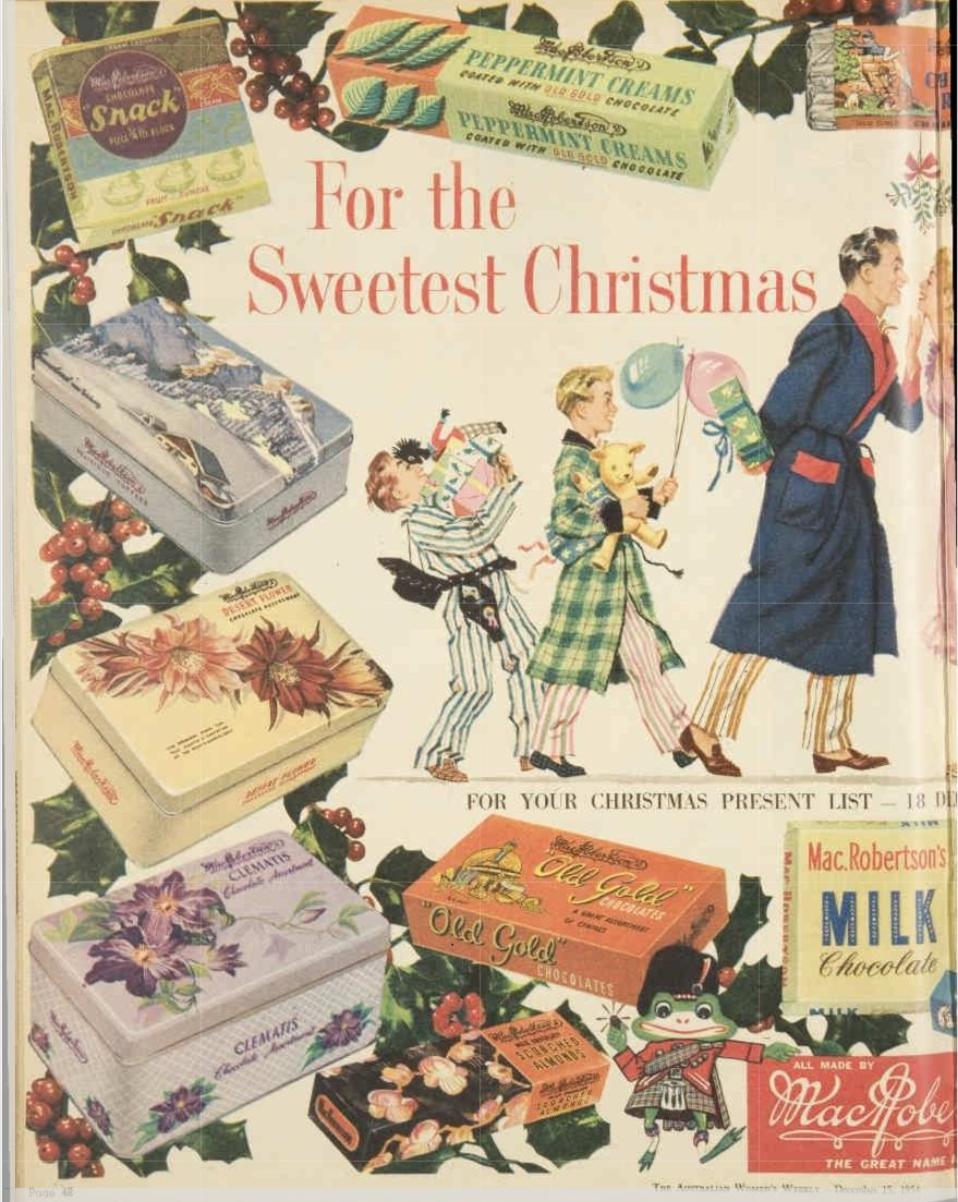
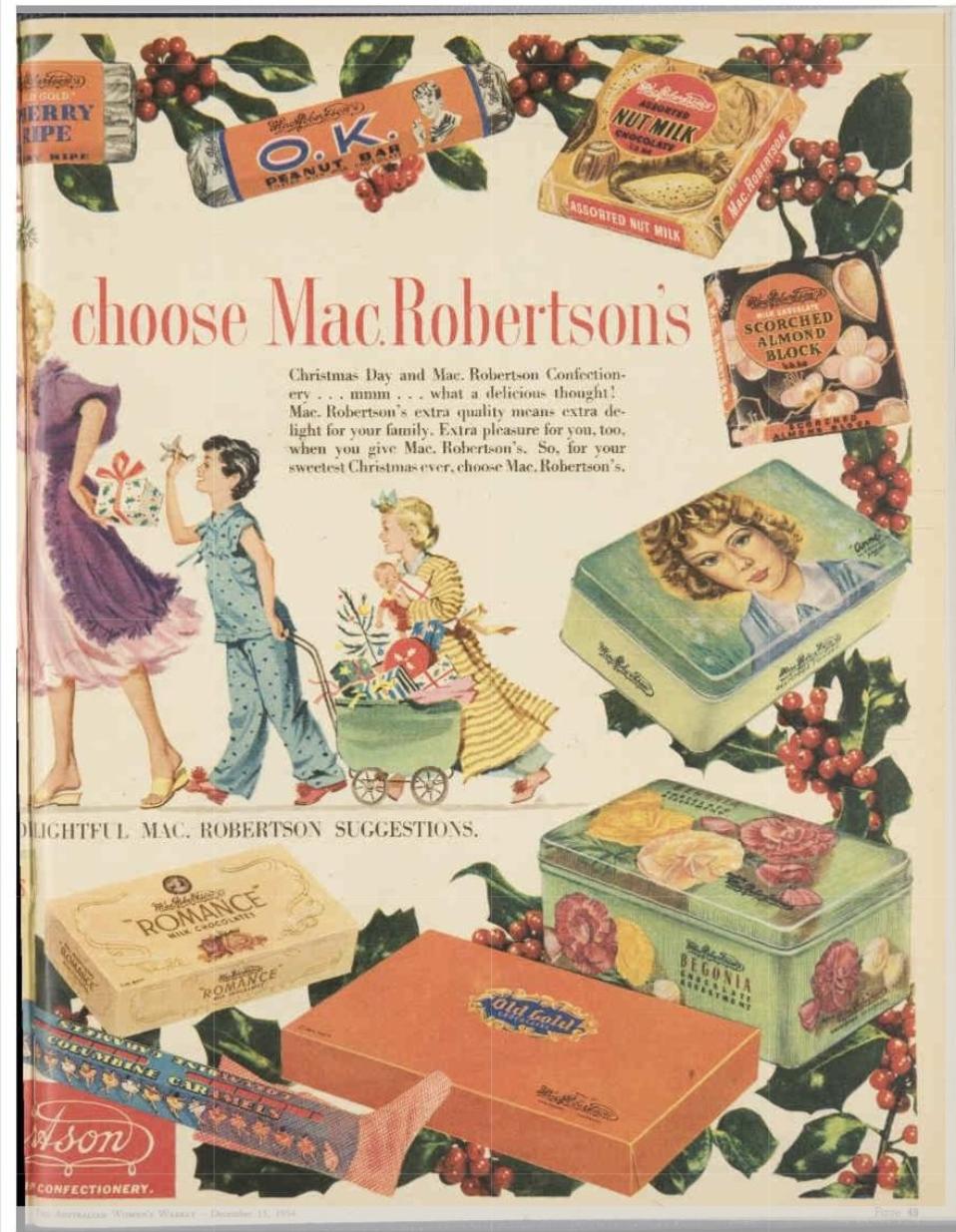
Christmas Day and Mac. Robertson Confectionery . . . mmm . . . what a delicious thought!
Mac. Robertson's extra quality means extra delight for your family. Extra pleasure for you, too, when you give Mac. Robertson's. So, for your sweetest Christmas ever, choose Mac. Robertson's. Advertising (1954, December 15). The Australian Women's Weekly (1933 - 1982), p. 48. Retrieved from http://nla.gov.au/nla.news-article44554989
With the recent resurgence of old favourites such as Scorched Peanut Bars, relaunched in late November 2019 and now being made by Wollongong company Cooks Confectionery, Violet Crumbles returned to us by South Australian gentleman Robern Menz in 2018 and his efforts bringing back the very yummy Polly Waffle in January 2019, that little bean from the lush jungles of South America has inspired a new generation of Australians to taste for the first time old Aussie recipes.
From MacRobertsons we had Cherry Ripes and O.K. Scorched Peanut bars while Hoadley’s gave us the Violet Crumble and Polly Waffle. However the Cherry Ripe story goes back a little further than the chocolate bar so many of us still enjoy today and had its beginnings in a popular song, that became linked with a popular painting and even a popular cake and biscuit before that Christmassy coloured treat came along.
Cherry Ripe is an English song, or old Madrigal, with words by poet Robert Herrick (1591–1674) and music by Charles Edward Horn (1786–1849) which contains the refrain;
Cherry ripe, cherry ripe,
Ripe I cry,
Full and fair ones
Come and buy.
Cherry ripe, cherry ripe,
Ripe I cry,
Full and fair ones
Come and buy.
An earlier poem by Thomas Campion (1567–1620) used the same title Cherry Ripe, and has other similarities. It is thought that the refrain originated as a trader's street cry.
The song's title has been used in other contexts on a number of occasions since and its tune has also been appropriated for many other uses. The song was popular in the 19th century and at the time of World War I.
In 1879 a very popular painting for one of those Christmas 'gift' supplements publications ran as affordable 'art for the masses' - as not all of us could then, or even now, afford works of Art.
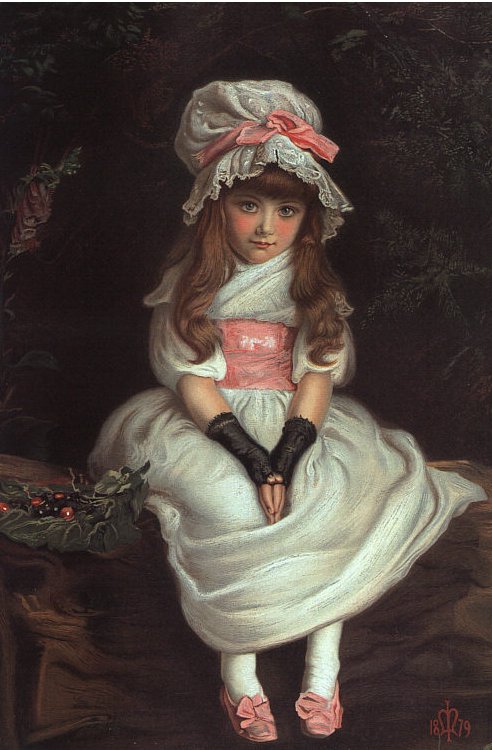
The Graphic's chromolithograph of Cherry Ripe (1879) by John Everett Millais (1829–96)
CHERRY RIPE.
It is always interesting to trace the history of people who have served as models for famous pictures, and our friendly interest in them is a life-long one. A contemporary tells us that Madame Franciso de Paula Ossorio, the lady who, with her husband, barely escaped alive from Manilla during the Spanish-American war, as the lovely little Edie Ramage, who sat to Sir John Millais some years ago for his great picture. "Cherry Ripe." The publishers paid Sir John £1,000 for it, and the following year the demand for it was so great that 600,000 copies were sold, and even then innumerable orders were left unsatisfied, so frantic was the demand for the work.- The picture went all over the world, and Australian miners, Canadian backwoodsmen, South African prospectors, and all sorts and conditions of colonial residents sent their tribute, of thanks to the artist for the perfect painting of a beautiful English child. The original, a sweet, serious, self-possessed little maiden, used to be accompanied to the studio by her mother, a shy, nervous lady. "Cherry Ripe" was always, however, the essence of coolness, and used to place a chair for her mother, to do the honours of the studio, and even to answer for her mother if the latter hesitated. She has been married for several years, and is herself a happy mother now. CHERRY RIPE. (1904, November 19). Evening Journal (Adelaide, SA : 1869 - 1912), p. 3. Retrieved from http://nla.gov.au/nla.news-article200830569
'CHERRY RIPE.'
Millais's delightful picture, "Cherry Ripe," for which we now know that the late Mr. M'Cullock vainly offered £5,000, has quite a pretty little story of its own recorded in the biography of the great artist. The original was said to be a professional model, but, as a fact, the child was little Miss Edie Ramage, a niece of Mr. Thomas, of the "Graphic." The sittings for the work seemed to have tried the child's mother, who was very nervous. Not so the child; the artist was amused to see how she sought to put her mother at ease, bringing her a chair, and even answering questions put to her parent. That same child sat afterwards for "Penelope Boothby," and so great was the success of the picture, that when the paper named published it as a coloured supplement at Christmas, no fewer than 600,000 copies of the number were sold, while orders for perhaps as great a total had to be refused, owing to the impossibility of printing more
ART IN THE WILDS.
It is not often given to an artist to reap such far-gathered harvest of pleasure as resulted to Millais from "Cherry Ripe." Engravings of the work found their way into the remotest parts of the English-speaking world, and everywhere won the admiration of wanderers from the Motherland. " From Australian miners, from Canadian backwoodsmen, from South African trekkers, and all sorts and conditions of colonial residents came to the artist letters of warmest congratulation." This picture of a lovely English child spoke to rough hearts and kind with a message such as few men could convey. And, her fame having preceded her, the little "Cherry Ripe," now grown to womanhood, herself ventured far afield. She and her husband—she had by this time become Mme. Francisco de Paula. Ossorio—were in Manilla during the Spanish-American War, and escaped with difficulty from the perils of the conflict. —"St. James's Gazette." “CHERRY RIPE.” (1908, September 26). Border Chronicle (Bordertown, SA : 1908 - 1950), p. 2 (SUPPLEMENT TO THE BORDER CHRONICLE). Retrieved from http://nla.gov.au/nla.news-article212435046
The National Library of Australia's search engine of TROVE, sharing so many early Australian newspapers and their articles shows several fancy dress events had many a young and older lady dressed as 'Cherry Ripe' while they were predated by 'Cherry Ripe' hats:
ditto ladies' bonnets and hats in "Cherry ripe," " Queen Mab," etc., in fancy straw ; SHIPPING. (1881, August 30). Launceston Examiner (Tas. : 1842 - 1899), p. 2. Retrieved from http://nla.gov.au/nla.news-article38225944
Sorrento Fancy Dress Ball.
On Easter Monday night visitors to "White-hall," Sorrento, participated with considerable, enjoyment in the annual fancy dress ball. The ball-room was beautifully decorated, and the costumes were tastefully arranged, the preliminary, "march" making it quite evident that much care and ingenuity had been exercised by the fair sex. Those appearing in the fancy dress were :—• Miss L. M. Allen, Scotch Thistle; Miss Judge, Powder and Patches; Mr. R. Allen, Mephisto-; Mr. J. G. Allen, Mother Goose; Miss A. Allen, Cherry Ripe; ...
The maize crop of the United States for 1906 is estimated at 2,730,-000,000 bushels. This crop, if divided among all the people of the. globe, would give about two bushels to each person. Illinois and Iowa are the largest maize-growing States, producing 305,000,000 and 882,700,000 bushels respectively in 1905. Sorrento Fancy Dress Ball. (1907, April 4). Table Talk (Melbourne, Vic. : 1885 - 1939), p. 25. Retrieved from http://nla.gov.au/nla.news-article145850119
Following is a list of the costumes : Miss R. Mahoney, MacRobertson's confectionery ; Miss Pim, Starry night ; Miss Rook, Cherry Ripe; Miss Murray, Dutch Cheese; Miss Ruth, Australia; …. APSLEY (1907, October 4). The Horsham Times (Vic. : 1882 - 1954), p. 2 (Supplement to the Horsham Times). Retrieved from http://nla.gov.au/nla.news-article72804243
Cherry Ripe used as a name for a sweet in Australia first came through as a cake and then a biscuit, the cake sold by Australia's first biscuit company, founded in 1854 by Thomas Swallow (1823-1890) who had a partner within five years he had taken in Thomas Harris Ariell and became Swallow & Ariell Ltd.

Thomas Swallow, c.1888 - State Library of Victoria, FL16386655
After Ariell died in 1875, F.T. Derham was appointed partner and managing director in 1877, and became his son in law. By the early 1880s their Port Melbourne factory extended to 3 acres (1.2 ha), and the company owned flourmills and sugar plantations in the Goulburn Valley and at Cairns in Northern Queensland, where Thomas Swallow passed away in 1890. With no equal outside Great Britain, Swallow & Ariell were the fifth largest biscuit company in the world, manufacturing over 100 varieties, including the common ship biscuit (an original product) and meat biscuits (apparently taken by Burke and Wills on their ill-fated expedition). The company also boasted popular sideline products, including cakes, plum puddings, ice-cream and dried fruit.
In 1892 the company patented their Cherry Ripe logo for the cake that was launched that same year.
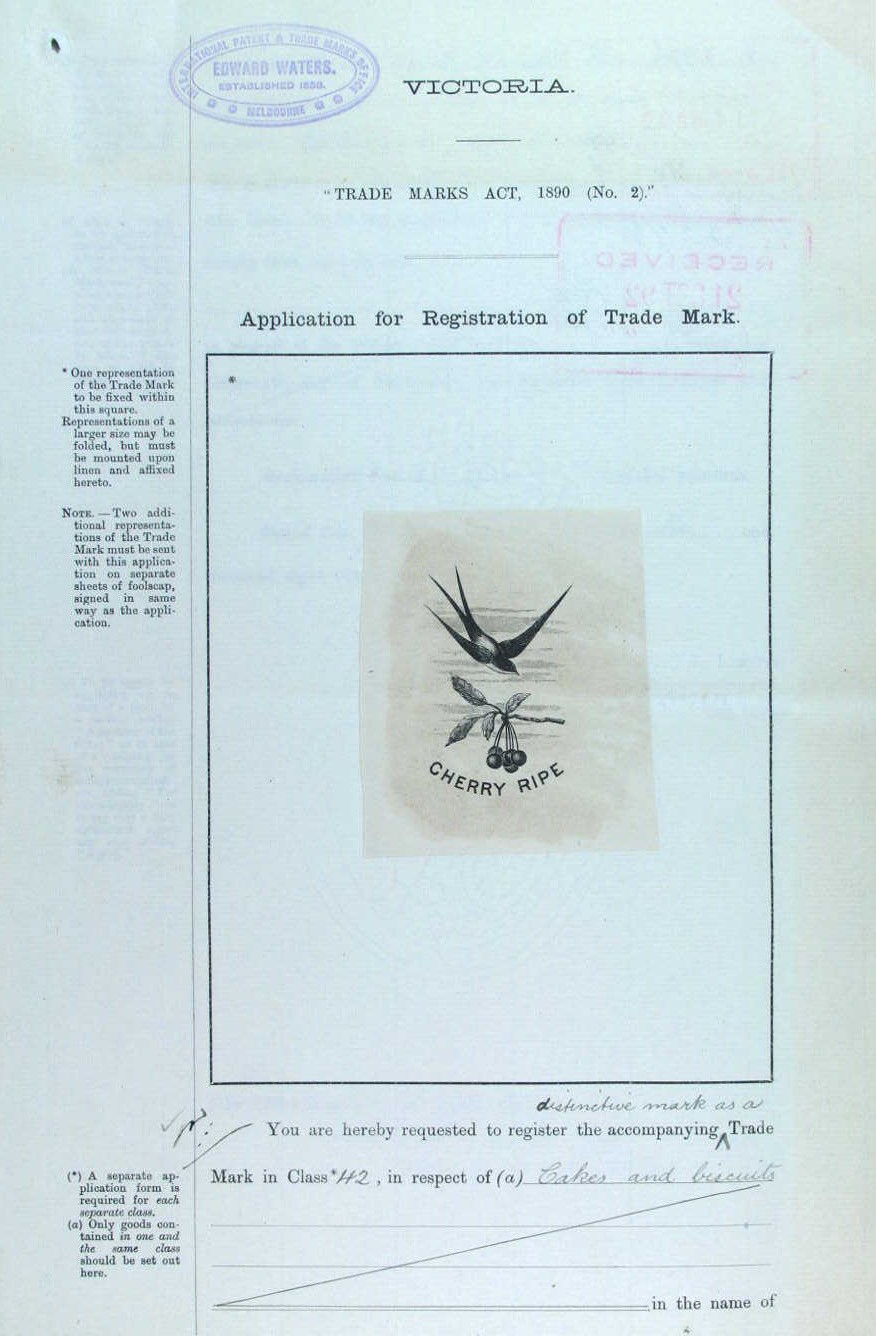
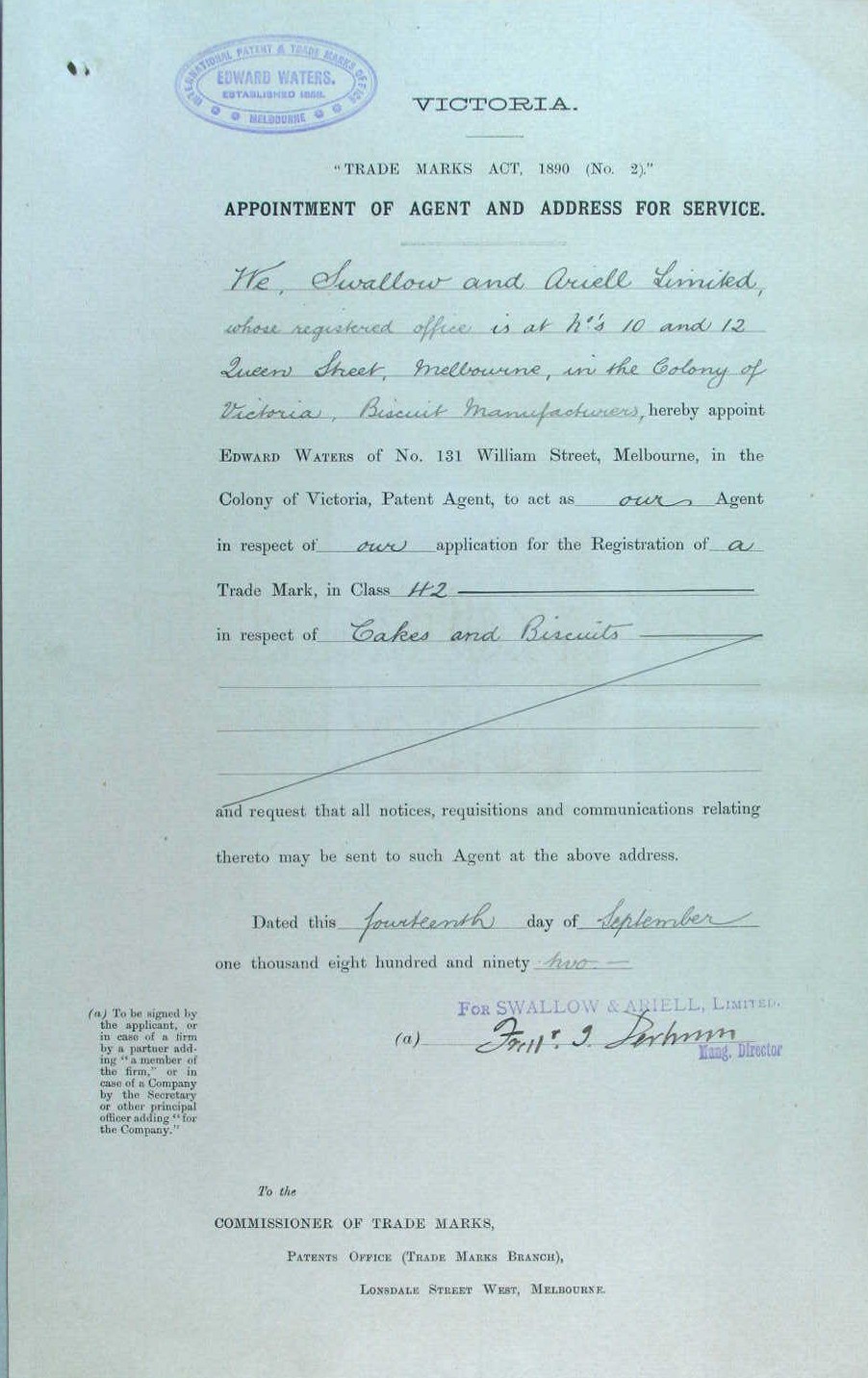
Application for Trade Mark titled Cherry Ripe depicting swallow approaching a cherry branch in respect of cakes and biscuits - by Swallow and Ariell Limited - 1892 - National Archives of Australia
WE have received from Messrs. Swallow and Ariell Limited samples of their latest novelty, the Cherry Ripe Cake, which has just been introduced to the public. The new cake is' a rich confection, fruited with exquisitely flavoured French cherries, and is altogether one of the nicest things the company has produced. The idea of utilising cherries in the manufacture of cake is an absolutely new one, and belongs to Messrs. Swallow and Ariell. Doubtless these enterprising caterers to the public taste will be amply rewarded in Witnessing a large demand spring up for Cherry Ripe Cakes. ENGAGEMENTS. (1892, October 13). Melbourne Punch (Vic. : 1855 - 1900), p. 16. Retrieved from http://nla.gov.au/nla.news-article174634396
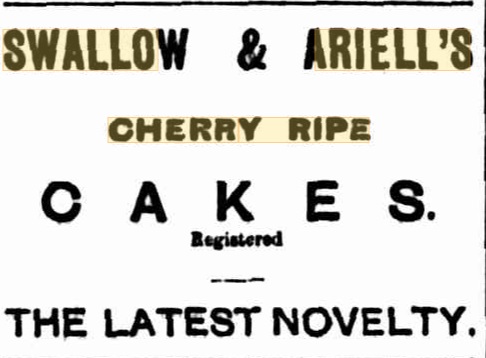
Family Notices (1892, October 26). The Herald (Melbourne, Vic. : 1861 - 1954), p. 2. Retrieved from http://nla.gov.au/nla.news-article242853051
Why they were using French cherries is a mystery - there were crops of cherries being harvested in Australia from at least 1826 onwards which had become, 100 years later, in New South Wales, well over 100 thousand trees and were certainly one of the peak crops in Victoria way before then:
BY MR. R. COOPER, In the Market-place, Sydney, on Thursday the 27th Instant at Eleven o'clock, without Reserve, ABOUT 4 Acres of an excellent ORCHARD, containing about 600 bearing Fruit Trees; viz. 120 cherry, 180 early peaches; with a variety of apples, pears, apricots, &c. &c. The whole of which is in excellent order and fit for immediate possession. Terms, Prompt payment in Spanish Dollars at 5s. each. ALSO, FOUR FAT BULLOCKS. Classified Advertising (1826, April 22). The Sydney Gazette and New South Wales Advertiser (NSW : 1803 - 1842), p. 1. Retrieved from http://nla.gov.au/nla.news-article2185695
CHERRY RIPE According to evidence given to the Tariff Board to-day by Mr. E. E. Herrod. secretary of the N.S.W. Fruitgrowers' Federation, there are 156, 717 cherry trees growing in this state. CHERRY RIPE (1925, May 13). Evening News (Sydney, NSW : 1869 - 1931), p. 5. Retrieved from http://nla.gov.au/nla.news-article117447062
In Pittwater cherries were grown on our western shores from the late 1880's on:
The dynamite powder hulk is moored in Towler's Bay, with residences on shore for the officers in charge. Mr. Robert Robinson has his residence of Raamah at the same place. Mr. Robinson informs me that he can grow to perfection such tropical fruits as bananas, guavas, ginger, mangoes, pineapples, Brazilian cherries, &c. This fact will demonstrate that there can be little or no frost in this locality. Other residents of this side of the bay are Mr. F. Chave, Woodlands, who has a very nice orchard, mostly summer fruit ; Mr. E. C. Johnstone, who has a nice residence and orchard; Mr. A. Steffani is another prominent resident, while the residence of the firm of Flood and Oately occupies a lovely peninsula in the quiet waters of the bay. Mr. Geo. Brown has a residence and an orchard in the neighborhood, and there is also a small church and cemetery at Church Point. Manly to Broken Bay. (1893, November 11). Australian Town and Country Journal (NSW : 1870 - 1907), p. 19. Retrieved from http://nla.gov.au/nla.news-article71191632
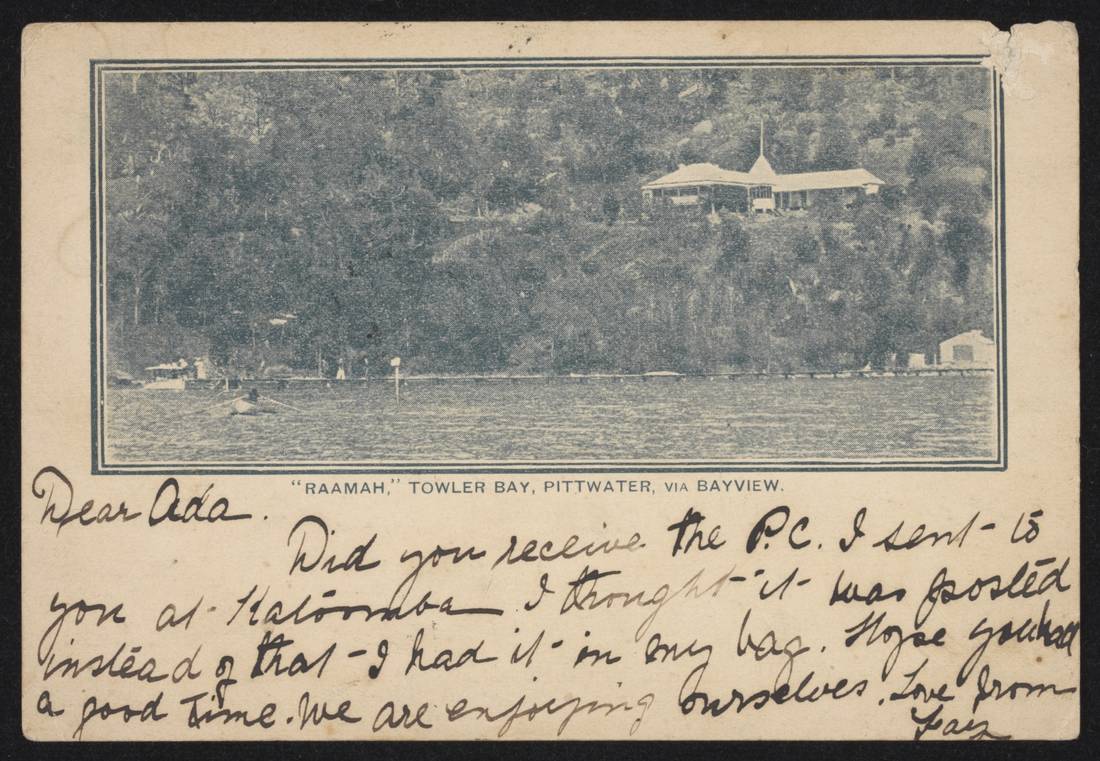
'RAAMAH, ' TOWLER BAY, PITTWATER, VIA BAYVIEW.'. It has a message on the front and the address on the undivided back, which is postmarked 21 Feb 1908. nma.img-ci20122792-788-wm-vs1_o3_1100 Courtesy National Musueum of Australia
In May 1924 Arnott's launched their 'Cherry Ripe Biscuit' - one of several biscuits then available by this Newcastle born company and an item that would continue to be part of their range for decades.
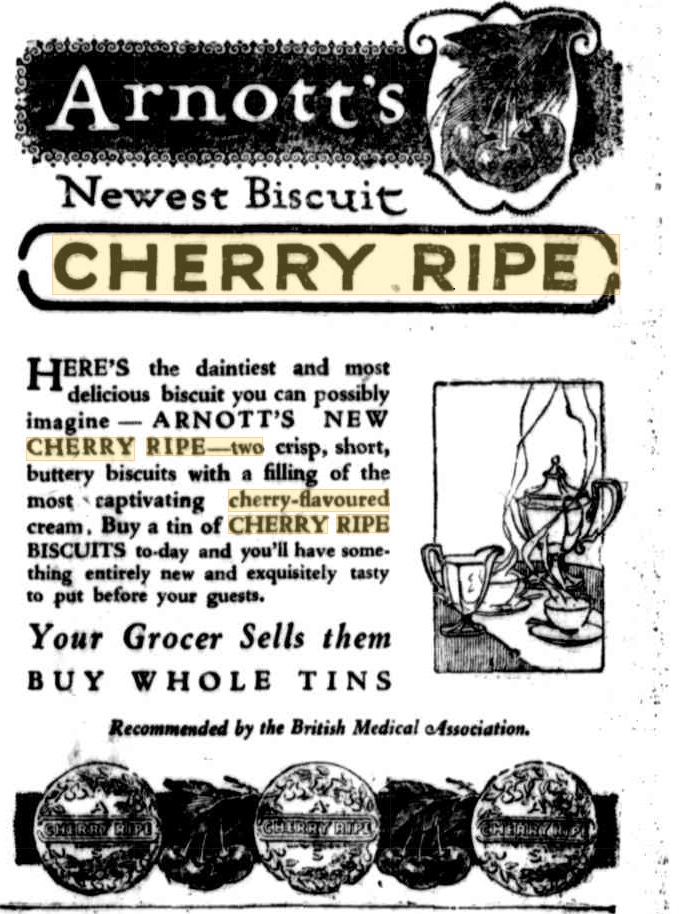
Display Advertising (1924, July 19). The Queenslander (Brisbane, Qld. : 1866 - 1939), p. 46. Retrieved from http://nla.gov.au/nla.news-article25539363
ARNOTT’s Newest Biscuit
CHERRY.RIPE)
THERE'S the daintiest and most delicious biscuit you can possibly imagine - ARNOTT'S NEW CHERRY RIPE- two crisp, short, buttery biscuits with a filling of the most captivating cherry-flavoured cream, Buy a tin of CHERRY RIPE BISCUITS to-day and you'll have some thing entirely new and exquisitely tasty to fit before your guests.
Your Grocer Sells them
BUY WHOLE TINS. Recommended by the British Medical Association. Advertising (1924, September 13). The Northern Miner (Charters Towers, Qld. : 1874 - 1954), p. 2. Retrieved from http://nla.gov.au/nla.news-article80548636
MacRobertson's confectioners were buying fruit for their jams prior to selling that part of the company off, and preserving fruit and using some of these, sultanas as one example, in their sweets from the late 1890's, especially their very popular mixed chocolates range, all smothered in Old Gold chocolate. By 1922 their chocolate covered maraschino cherries were a popular item. A maraschino cherry is a preserved, sweetened cherry, typically made from light-coloured sweet cherries such as the Royal Ann, Rainier, or Gold varieties.
MacRobertsons' was another Australian success story on a large scale - everything founder Macpherson Robertson needed as an ingredient for their products was Australian grown or made, including, when the price of the cocoa bean went up so much and so quickly after World War II, their own New Guinea grown chocolate beans. Some insights into Mr. Macpherson Robertson run under 'Extras' - he was one dynamic, amazing gentleman with a love for Australia and Australians, born in Ballarat in 1859, during the era when men sought gold and those born here were labelled 'cornstalks', he grew up to change this world.
The main ingredients of today's Cherry Ripe chocolate bar are, according to the product label: Sugar, Coconut, Glace Cherries Wheat Glucose Syrup, Cocoa Mass, Sweetened Condensed Milk, Vegetable Fat, Milk Solids, Cocoa Butter, Cocoa Powder, Gelatine, and Invert Sugar. The colour number and flavour numbers aren't the focus here - although they are part of those bars.
The first sweetened condensed milk in hermetically sealed cans was manufactured and sold in 1856 by Gail Borden in the USA. Mr. 'Mac' Robertson was having none of that though and formed a group with his so-called 'competitors' to meet all their Australian sweet producing needs:
CONDENSED MILK.
The infant milk factory of Bacchus Marsh (the Federal Milk Company) although only about three months old, has already outgrown - its clothes, and a new (or duplicate) outfit is to be provided. That should be sufficient proof to the most pessimistic that the undertaking has been a huge success.
Since October last we published the "pedigree" of the new Company, which consists principally of leading Melbourne confectioners, including MacRobertson, Hoadley's, Swallow, & Ariell, and Allan, who entered into negotiations with the Bacchus Marsh Dairymen's Co-operative Association to supply them with fresh milk. Operations were commenced on 6th March of this year.
A visit to the new factory shows this fresh milk undergoing treatment. At present 1,000 gallons daily are "piped" direct from the Dairy Association's scales (whose building adjoins) into two 500-gallon vats; from there it passes through an instantaneous heater into an intercepter vat, where the milk receives additional heating, and the best cane sugar added, in proportions which, of course, can be classed as a trade secret. But the amount of sugar used each week amounts to 31 tons.
From this vat the milk passes into the condensing pan, and reduced in vacuo to the right degree of density. After remaining in this pan for about four hours, the milk is then run off into cooling cans, which are placed in cooling vats. The cans stand in water, on revolving discs-12 in each of two vats, 24 in all-an ingenious arrangement of cog wheels within cog wheels, working flat on the bottom of the vats. The cans then have tinned-steel paddles placed in them, which prevent the sugar from settling or crystallising. This constant stirring also gives an evenness to the milk, which is about the consistency of honey. The cans remain here for five hours, are then taken out and the contents strained into another vat; from where the milk is run off into cans and weighed. Then all is ready for market as sweetened condensed milk in bulk.
To avoid back-racking lifts of the heavy cans in and out of the cooling vats, an overhead traversing tackling is provided-good idea. As the sugar is bought in large 1 cwt. bags, they are hauled on to the "second story" by steam power, and there is a safety self-opening and self-closing pair of doors, which obviates danger of the bags falling on the man below. The sugar is afterwards tipped into a self-feeding bin on this floor, and finds its way into the heating pan.
The very first day's output was a great success, and has been so ever since. The demand for it exceeds the supply, as it is all used by the confectioners first named, who find that the public has acquired a taste for all the products containing this sweetened milk. So great is the demand for the product that it has been decided to duplicate the whole plant, which it is hoped will be ready for use to take advantage of the flush-of milk in August.
The buildings will be so extended as to include a tinmaking and tinning plant, as the Company intend to make its own tins, and place the milk product on the open market, so that the public will have the opportunity of using it.
The water supply of the factory is pumped from two wells into a reinforced concrete reservoir, with a capacity of 10,000 gallons, also into a 4,000 gallon tank, which is on the roof of the factory, 30ft. high. This tank is made of, wood, lined with malthoid. As a large quantity of water is used, another ingenious contrivance is installed, whereby it can be used over and over again. The hot water from the factory is pumped across to the aerator shed, where it is distributed by ten sprays back into the reservoir before mentioned, which is covered in by a 8ft..x 21ft. galvanised iron louvred shed, with malthoid roof. With all the sprays working it resembles a huge shower bath, as the sprays are 10ft.,above the water surface, and the water is thus thoroughly cooled and aerated in falling.
If necessary, the reservoir can be filled from the town water mains. And, in case of fire, the water in the elevated tank can be used by the Fire Brigade, the Company, making this special provision.
The disposal of "washings" has been overcome by a scheme of drainage inaugurated by the Company. From the concrete floor the water flows into a receiver, and thence by gravitation into 4-inch earthenware pipes across the street into Mr. C. Dickie's seven-acre orchard, where the water is distributed by canvas hose. There are three silt traps on the way, which are cleaned out daily, and the whole is flushed out every evening with a full head of water from the elevated tank.
The company was fortunate in securing the services of Mr. Ernest H. Lawrence, as Manager, who, to use the words of one of the Directors, "has turned out a product second to none, right from the start." Mr. W. G. Lawrence is sub-manager. The Secretary is Mr. H. H. Sherlock, whoso head-quarters are in Queen street, Melbourne. Mr. Chas. Dickie is one of the Directors of the company, and is keenly looking after its interests at the manufacturing end. Mr. James Borrie, Engineer at MacRobertson's, supervised the erection of the machinery, which includes a 10 1.p. engine and 80 h.p. boiler. The 50ft. chimney stack is built of local bricks, from the Darley Firebrick Co.
The most important item, perhaps, so far as the suppliers of the Dairymen's Co-operative Association are concerned, is the price they are receiving for the raw material from the new company. The agreement made was to pay 6d. per pound butter fat higher than the price ruling for top Western District butter. This was to apply to 1,000 gallons during the spring months-August to January; and for the remaining six months 500 gallons on the same basis, and 500 gallons at d price to be mutually fixed, which at present is 1/ per gallon. This compact is being kept to the letter, as 1/11 per pound butter fat is now being paid, which is 6d. over Western District. The Co-operative Co. is therefore paying its suppliers 1/9 per pound butter fat, with a good margift of profit, which the suppliers will get the benefit of later on in a bonus. Under these circumstances the new company is the best proposition that ever came in the way .of the Cooperative Co., as it enabled them to receive the maximum price at a minimum working cost. As long as they can do that there should not be one dissentient voice amongst the suppliers. It is the wish of everyone that they should prosper, as their welfare' is the welfare of the whole district. The only regret is that the supply of raw material to both companies is not three times as great. Will the dairy farmers assist by duplicating their dairy ,herds? -And large landowners do likewise by making available more dairy farms? CONDENSED MILK. (1916, May 13). Melton Express (Vic. : 1915 - 1943), p. 3. Retrieved from http://nla.gov.au/nla.news-article96142983
The cherries came from a few places, including the high cherry producing state of New South Wales;
Young Cherries.
Bought by MacRobertson's.
The fame of Young is being crystallised by the fact that Mr Matt Jasprizza has entered into arrangements for the export of thousands of cases of the beautiful product of the Summer Hill cherry orchard to Melbourne. The purpose of this export is in connection with the big crystallising and bottling undertaking of the famous MacRobertsons, sweet manufacturers of Melbourne.
About five years ago this firm began operation's with 25 cases of cherries, and last year 150 tins of selected fruit were utilised for the purpose. The special varieties picked from the Summer Hill orchard were Florence, Napoleon and Bigaroo, and the samples forwarded were classed as some of the best ever exported.— Chronicle.' Young Cherries. (1925, December 21). The Yass Courier (NSW : 1902 - 1929), p. 3. Retrieved from http://nla.gov.au/nla.news-article249796508
CONFECTIONERY MAKERS
MacRobertson's £1,413,083
Gross trading profits of MacRobertson (Australia) Ltd. and its subsidiary companies for the year ended December 31st, 1951 rose by £374,555 to £1,413,083.
Expenses were £ 225,000 higher at £912,399, depreciation was £118,772 (£100,236 for 1950), taxation absorbed £206,391 (£134,861) and consolidated net profit was £206,673 including £ 10,949 excess tax written back. This compares with £159,599 for 1950. 'Net profit of the parent company was £178,645 including . £ 10,385 tax written back/ This compares with £50,744 for 1950. Consolidated assets total £5,265,000 (£5,000,000 a year ago). Stocks are £2,723,000 (an increase of £284.000). debtors £484,000 (£397,000). Bank overdraft is £586,000 (£408,000), creditors and liability under contracts for raw materials £1,066,000 (£1,149,000). Tax paid reserves are £379,696 (£434,489), general reserve £131,422 (£129,198). reserve against fall in stock values £204,500 (£200.000), and assets revaluation reserve £315,393. Bank loan is £200,000 and goodwill £200,000.
Directors report that the value of sales of the subsidiary companies' products during the year was the highest in the history of the business. All subsidiaries showed satisfactory trading results. Stocks on hand Increased considerably during the year. Owing to the market trend the board deemed it advisable to .purchase certain raw . materials earlier than usual, and this has contributed to the Increase in the bank overdraft during, the year. Additions to plant, which will contribute to the reduction of costs, have been made during the year, and the company has also acquired cherry processing factories in Victoria and South Australia.
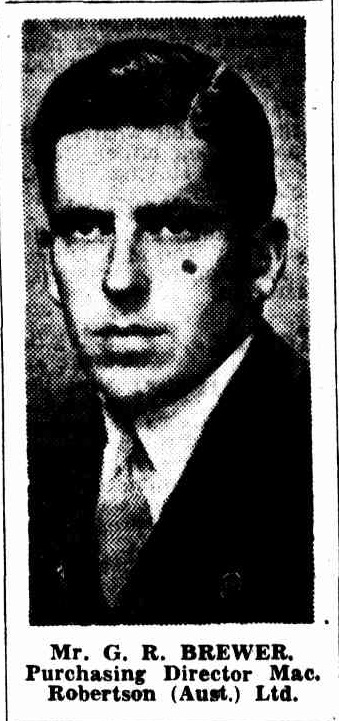
Mr. G. R. BREWER. Purchasing Director Mac. Robertson (Aust.) Ltd.
CONFECTIONERY MAKERS (1952, May 27). The Age (Melbourne, Vic. : 1854 - 1954), p. 6. Retrieved from http://nla.gov.au/nla.news-article205411008
Mac Robertson cocoa project
Mr. Geoffrey Brewer, purchasing director of Mac Robertson Pty. Ltd., will leave Sydney next week in the Bulolo, for Lae, New Guinea. Accompanied by the company's New South Wales manager, Mr. C. M. Orr, Mr. Brewer plans to spend several days at the MacRobertson cacao plantation, Wartaru, which is only a few miles from Lae. They will be away about a month.
This 1,000-acre property was bought towards the end of last year by MacRobertson as a pilot venture in cocoa growing. Already some beans from trees on Wanaru have been processed at the Fitzroy factory.
Mr. Brewer and Mr. Orr will then fly to Rabaul, where they will visit the Government experimental station at Keravat.
They will also Inspect a number of well-established cacao plantations in the Rabaul area, including that of Mr. Ted Pulton, whose property, Makurapau, is today growing 70,000 cacao trees and 35,000 coconut trees.
Cacao is the name of the tree and pod. Cocoa ls the product. Mac Robertson cocoa project (1955, January 8). The Argus (Melbourne, Vic. : 1848 - 1957), p. 18. Retrieved from http://nla.gov.au/nla.news-article71688624
MacRobertsons Cherry Ripe soon proved to be one of their most popular items, so much so, that as in the generations that preceded his, people celebrated the story and song themes that featured on MacRobertson products by dressing up as this new 'Cherry Ripe':
ALL HALLOWS
JUVENILE- BALL HUGE CROWD OF CHILDREN.
All the pent up spirits of juvenile humanity were unleashed for one happy night in the Boulder Town Hall on Thursday evening when 400 kiddies attended' the All Hallows juvenile ball. Following upon the adult ball the previous night, the function was a splendid success and the youngsters thoroughly enjoyed themselves.
PRIZE WINNERS Prettiest junior set, Carnival most original junior set, Royal Pages 1, Irish Lassies 2; 'best carried, out junior set, Night 'Fairies 1, Court Jesters 2 ; best junior poster.. set, Cherry Ripe 1, Wescobee Honey 2 : best dressed junior girl, Sweet 'Nell' of Old Drury ; best dressed tiny tots, Drum Major and Doll in the. (Box; best junior characters, Norwegian and Letter Box; best junior poster costume, Vacuum -Plume. 'Special Junior Prizes : Bridal Party, Bride and Groom, The Shepherdess, and Opperman. Prettiest senior set, Miniature 1, Pompadour Pierrots 2 ; most original senior set, The Old Bush School 1, Rainbow 2; best carried out senior set, Pearl and Fishermaiden 1, Men From Mars 2; best senior poster set; Angoorie Tea 1, Big K 2; best dressed senior couple, Yellow and Black Pierrots 1, Pages 2; most original senior girl, The Bat 1, Don Bradman 2; best senior individual, Golden Eagle. SETS. Mrs. Walsh's Pompadour Pierrot Set : Mary Matthews, Rita Whooley, Nora. Ohessom, Joan Harris, Molly Heara, Betty Silva, Betty Twigg, Ella Maundoli. Mrs. Fisher's Miniature Set: Pauline Jordan, Jean Ranclaud, Bethel Rees, Marjorie Oates, Roima Robertson, Marjorie Maffina, Shirley Tillet, Glenice Perks, Mavis Leslie. Mrs. M. Moore's Court Jesters Set : Jack Whooley, Jack Sommers, Mile Roberts, Ron Moore, Desmond Whyte, George Portell Joe Mathews, Jack Davis, Miss M. Hill's Night Faries Set: Shirley Bennetts (leader), Joyce Armstrong, Aiva Davidson, June Hebbard, Irene Bqsustow, Fay Bennetts, Patty Rosinius, Mary Hobbs, Shirley Robertson. Mrs. Green's MacRobertson's Cherry Ripe Set: Cora Wood (leader), Vera Wood, Francis Green, Dorothy Taaffe, Joan Green, Nellie Dray, Irene Wood, Barbara Call, ' Lillian Kenneally. Mrs. J. Wren's Carnival Set: Pat Troupe ALL HALLOWS (1934, July 7). Kalgoorlie Miner (WA : 1895 - 1954), p. 6. Retrieved from http://nla.gov.au/nla.news-article95018799

MacRobertsons Pall Mall Advertising (1935, October 12). The Advertiser (Adelaide, SA : 1931 - 1954), p. 6. Retrieved from http://nla.gov.au/nla.news-article74148374
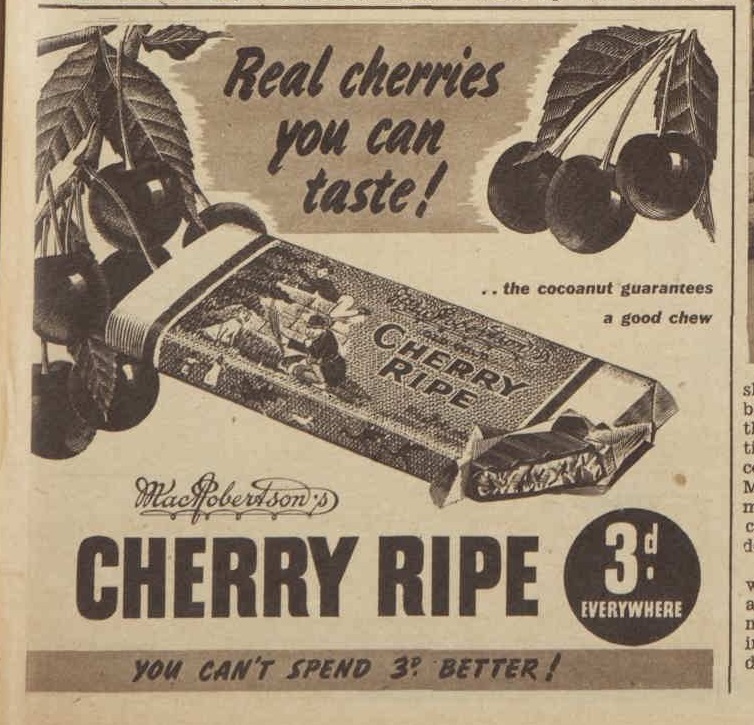
Advertisement published in newspapers and magazines such as The Australian Womens Weekly - December 6th, 1941
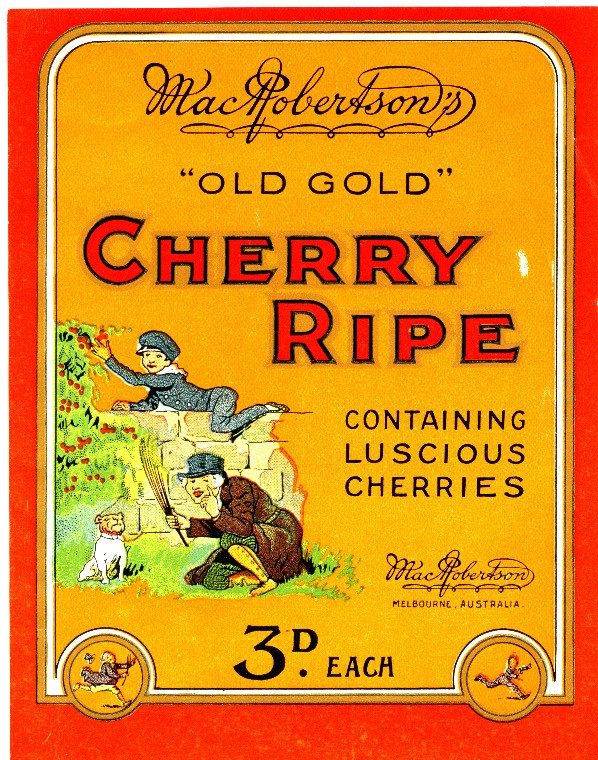
Macpherson Robertson had a keen eye and knew attractive presentation of his product would increase sales. Once he commenced making chocolates series of these ran as 'Beau Brummell', 'Dolly Varden' and other similarly themed and beautiful boxes - many kept and reused for storing sewing items, or the treasures children gather as youngsters; marbles, colourful stones.
As a grandson stated just a few years ago:
Many of the colourful packages featured poems or stories, like the boy who stole the cherries on the back of the cherry ripe wrapper. - David Robertson, grandson of the well-known Melbourne businessman and philanthropist, launching the exhibition, Nail Can to Knighthood : the life of Sir Macpherson Robertson KBE, hosted and curated by the Royal Historical Society of Victoria, July 14, 2015 to March 4th, 2016. From Transcription of his Address in opening the Exhibition.
The little boy depicted in the Cherry Ripe wrapper looks like he is wearing a Little Lord Fauntleroy suit with a working class boys cap and also looks like Buster Brown and his dog Tige, an America Pit Bull. The Cherry Ripe, launched in 1924, comes around the time Mr. Robertsons last born and youngest son Eric would have been around six years of age, and perhaps getting up to mischief at times.
In Little Lord Fauntleroy a novel by the English-American writer Frances Hodgson Burnett, her published as a serial in St. Nicholas Magazine from November 1885 to October 1886, the story evolves the shift in perspective by the Earl of Dorincourt, an unruly millionaire who despises the United States and was very disappointed when his youngest son married an American woman and had a young son Cedric Errol. With the deaths of his father's elder brothers, Cedric has now inherited the title Lord Fauntleroy and is the heir to the earldom and a vast estate. Cedric's grandfather wants him to live in England and be educated as an English aristocrat. He offers his son's widow a house and guaranteed income, but he refuses to have anything to do with her, even after she declines his money.
This reflects a little of Mr. Robertson's own early experience where, according to some anecdotes, his mother was rejected by his grandmother when the family returned to Scotland for a few years and he had to work before and after school to help make ends meet.
The Earl planned to teach his grandson how to be an aristocrat. Instead, Cedric teaches his grandfather that an aristocrat should practice compassion towards those dependent on him. The Earl becomes the man Cedric always innocently believed him to be.
An extract - this work is available online:
The carriage rolled on down the stately avenue under the beautiful, broad-branched trees, through the spaces of green shade and lanes of golden sunlight. Fauntleroy saw again the lovely places where the ferns grew high and the bluebells swayed in the breeze; he saw the deer, standing or lying in the deep grass, turn their large, startled eyes as the carriage passed, and caught glimpses of the brown rabbits as they scurried away. He heard the whir of the partridges and the calls and songs of the birds, and it all seemed even more beautiful to him than before. All his heart was filled with pleasure and happiness in the beauty that was on every side. But the old Earl saw and heard very different things, though he was apparently looking out too. He saw a long life, in which there had been neither generous deeds nor kind thoughts; he saw years in which a man who had been young and strong and rich and powerful had used his youth and strength and wealth and power only to please himself and kill time as the days and years succeeded each other; he saw this man, when the time had been killed and old age had come, solitary and without real friends in the midst of all his splendid wealth; he saw people who disliked or feared him, and people who would flatter and cringe to him, but no one who really cared whether he lived or died, unless they had something to gain or lose by it. He looked out on the broad acres which belonged to him, and he knew what Fauntleroy did not—how far they extended, what wealth they represented, and how many people had homes on their soil. And he knew, too,—another thing Fauntleroy did not,—that in all those homes, humble or well-to-do, there was probably not one person, however much he envied the wealth and stately name and power, and however willing he would have been to possess them, who would for an instant have thought of calling the noble owner “good,” or wishing, as this simple-souled little boy had, to be like him.
And it was not exactly pleasant to reflect upon, even for a cynical, worldly old man, who had been sufficient unto himself for seventy years and who had never deigned to care what opinion the world held of him so long as it did not interfere with his comfort or entertainment. And the fact was, indeed, that he had never before condescended to reflect upon it at all; and he only did so now because a child had believed him better than he was, and by wishing to follow in his illustrious footsteps and imitate his example, had suggested to him the curious question whether he was exactly the person to take as a model.
Fauntleroy thought the Earl's foot must be hurting him, his brows knitted themselves together so, as he looked out at the park; and thinking this, the considerate little fellow tried not to disturb him, and enjoyed the trees and the ferns and the deer in silence.
In Buster Brown, a comic strip character created in 1902 by Richard F. Outcault, Busters', his sweetheart Mary Jane, and his dog Tiges' adventures are told. Buster is a young city-dwelling boy with wealthy parents who is lovely to look at but with mischievous ways. He is a practical joker who might dress in a girl's outfit and have her wear his clothes, break a window with his slingshot, or play a prank on a neighbour. The transgression is discovered and he is punished, usually by being spanked by his mother, but it is unclear if he ever repents. The character of Buster Brown was loosely based on Granville Hamilton Fisher, a son of Charles and Anna Fisher of Flushing, New York. Fisher's physical appearance, including the characteristic pageboy haircut, was copied by Outcault and given to Buster Brown. The name "Buster" came directly or indirectly from the popularity of Buster Keaton, then a child actor in vaudeville.
The character's name was also used to describe a popular style of suit for young boys, the Buster Brown suit, that echoed his own outfit.
Similarly the Fauntleroy suit, a velvet cut-away jacket and matching knee pants, worn with a fancy blouse and a large lace or ruffled collar. These suits appeared right after the publication of Burnett's story (1885) and were a major fashion for boys until after the turn of the 20th century. Many boys who did not wear an actual Fauntleroy suit wore suits with Fauntleroy elements, such as a fancy blouse or floppy bow. Only a minority of boys wore ringlet curls with these suits, but the photographic record confirms that many boys did.
The suit was most popular for boys about 3–8 years of age, but some older boys wore them as well. It has been speculated that the popularity of the style encouraged many mothers to 'breech' their boys earlier than before, (the occasion when a small boy was first dressed in breeches or trousers) and pointed to as a factor in the decline of the fashion for dressing small boys in dresses and other skirted garments.
Below you may see Mr. Robertson visited America and brought back chewing gum, launching this as a product in 1896, and introduced fairy floss to an Australian market as well. There is also a reflection of the George Washington 'I cannot tell a lie' story with the switch held in the squire-type character's hand. Macpherson Robertson would not seem the type to chase a little boy and his little dog out of his cherry tree, although there would perhaps be a lesson to be learned about not stealing.
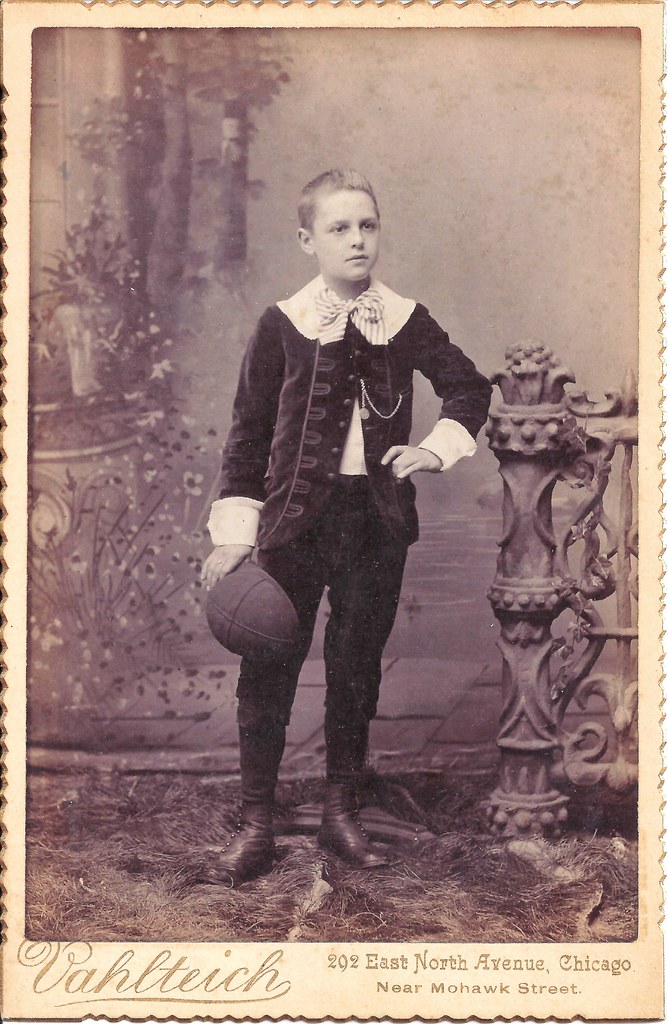
A Little Lord Fauntleroy - Buster Brown style suit
The exact story behind the characters used on the wrapper is not on record, as are some others employed - someone may tell us soon - they usually do! However, at this stage this remains one of those items that disappear in a few generations because they were too familiar to those who lived and breathed them to bother passing on to we who came next - we're just supposed to know. We don't.
The 'Mac Robertson' signature used is actually Macpherson Robertson's' own signature and demonstrates not just great penmanship but hints of an appreciation of stories and art. The founders fondness for children, for making beautiful boxes with old and great characters on them, points to a love of literature and songs as well. Newspapers from Australia's past ran many reports attesting to his pursuit of making the packaging on par with what it contained, his focus on getting this right is stated in this instance as:
WELCOME GIFT
£500 in Scholarships MAC ROBERTSON TO BALLARAT TECHNICAL ART SCHOOL.
Mr M'Pherson Robertson, the confectioner, who is known throughout Australia as "Mac Robertson," has demonstrated his interest in his native city, Ballarat, by a gift to the Technical Art School that will win him the appreciation not only of the school council, but also of the parents of hundreds of students, who will be able to have an opportunity of advancing solidly with his assistance along the route of education they have marked out for themselves. ’’Mac Robertson's” gift to the school, which came to light yesterday, per his very live Ballarat manager, Mr J. J. Dunkin, takes the form of five yearly scholarships of £100 each- —or a total of £500—with an option of renewal, if the school or rather the student, “makes good.”
It is an exceptionally fine gift to an exceptionally fine, school, and it was Mr Dunkin’s pleasure to be able yesterday to convey the welcome news to Mr Herbert H. Smith, the principal of the school, who, needless to say was with his council, with Messrs Betheras and Carew Smyth, of Melbourne, who were on an inspectoral visit to the school, highly pleased with the fine generosity of the old Ballarat boy “Mac Robertson.” It is not generally known that he is a Ballarat product, but such is the case, and he is immensely proud of the fact. More over he is well represented in Ballarat by Mr Dunkin, a modest man himself, but with a quiet punch withal that tells in business.
Mr Mac Robertson has left the details in the hands of the principal, Mr H. H. Smith, and Mr Dunkin, and in a chat with the former last night, a representative of “The Star” learnt that the scholarships will probably be designed to cover art, design, and architecture, these being the three subjects more closely associated with Mac Robertson's business.
The idea at present is to throw open the scholarships to the most deserving students each year, and they will not be confined to any one district or State. It is the biggest thing in scholarships in Victoria, and as such is keenly appreciated by the school authorities. The fine offer by Mr Mac Robertson may also be the means of inducing other generous men to “go and do likewise.’ One aspect of the scholarships is this, as Mr H. H. Smith pointed out—Some times promising students work up to their last year and then find that they are unable, through lack of funds, to carry, on. They can by . winding a Mac Robertson scholarship' continue their studies to a point _ at which they can secure remunerative employment. It may he possible to secure a two-years scholarship, but this has yet to be decided by the board of instructors who will be the arbitors. As to the scholar ships. The school authorities do not intend to delay taking advantage of the generous offer, and the first scholarship will be made available this year. WELCOME GIFT (1924, February 12). The Ballarat Star (Vic. : 1865 - 1924), p. 1. Retrieved from http://nla.gov.au/nla.news-article213957557
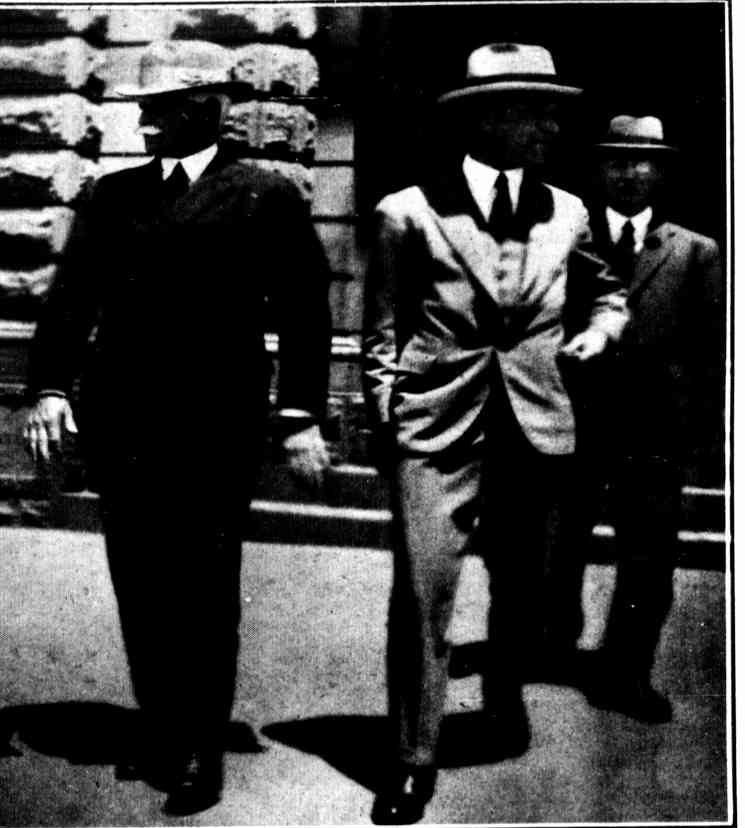
Mr. Mac. Robertson (left), the well-known Chocolate and Confectionery Manufacturer (accompanied by Mr. L. G. Atkinson), leaving the Town Hall, Ballarat, after the civic reception held In his honor recently. Mr. Mac. Robertson is a native of Ballarat, and paid a brief visit to his native city. LADIES' LETTER (1924, January 31). Table Talk (Melbourne, Vic. : 1885 - 1939), p. 33. Retrieved from http://nla.gov.au/nla.news-article146468130
The Culture Victoria website (State Gov. of Vic) informs that 'in the grounds of the original MacRobertson factory buildings, now converted into apartments, a cherry tree and palm tree still grow in commemoration of this popular product'.
People still dress up as 20th century versions of 'Cherry Ripe', make cakes, sweets and ice creams based on the favourite bar, knit jumpers with Cherry Ripe themes, and follow a little of Macpherson Robertsons' policy of being a little sweeter to their fellow human being and helping them out when it's needed. He was a pioneer, philanthropist, with a keen interest in every aspect of devoting means to growing Australian individuals as much as Australian industry and Australian Made products - to him they were all the many parts of one whole. MacRobertson Girls High School, MacRobertson Bridge, and the Herbarium at the Royal Botanic Gardens, constructed with funds provided by Sir MacPherson Robertson to celebrate Victoria’s centenary celebrations in 1934, stand still as testament to what something a moment on the lips and forever swaddling our hips may bring.
At this time of the year it is timely to remember that each Christmas he gave thousands of pounds to many organisations in every state of Australia, a gift that would be £10 000 pounds annually by the mid 1920's, a fortune translated forward, and would continue to do so throughout the hard years of the 1930's, taking a cut in profits to meet peoples needs.
With a face that never seemed to get lined, despite his obvious hard work hard-play hard ethos, and a shock of pure white hair, he reminds many of an original Australian Father Christmas.
In 2015 the Cadbury's factory in Ringwood, Victoria was processing 40 million Cherry Ripe bars annually, with six tonnes of chocolate being produced every two hours at the factory. The creation remains, alike the cherry, one way we bring the glorious red colour of a true heart into our Christmas, New Years and Summer celebrations. In fact, we're going out right now to get some Scorched Peanut Bars, a heap of Cherry Ripes and a case of homegrown Australian cherries.
No recipes required!
Have yourselves a very Merry Christmas and the best for 2020 to all!
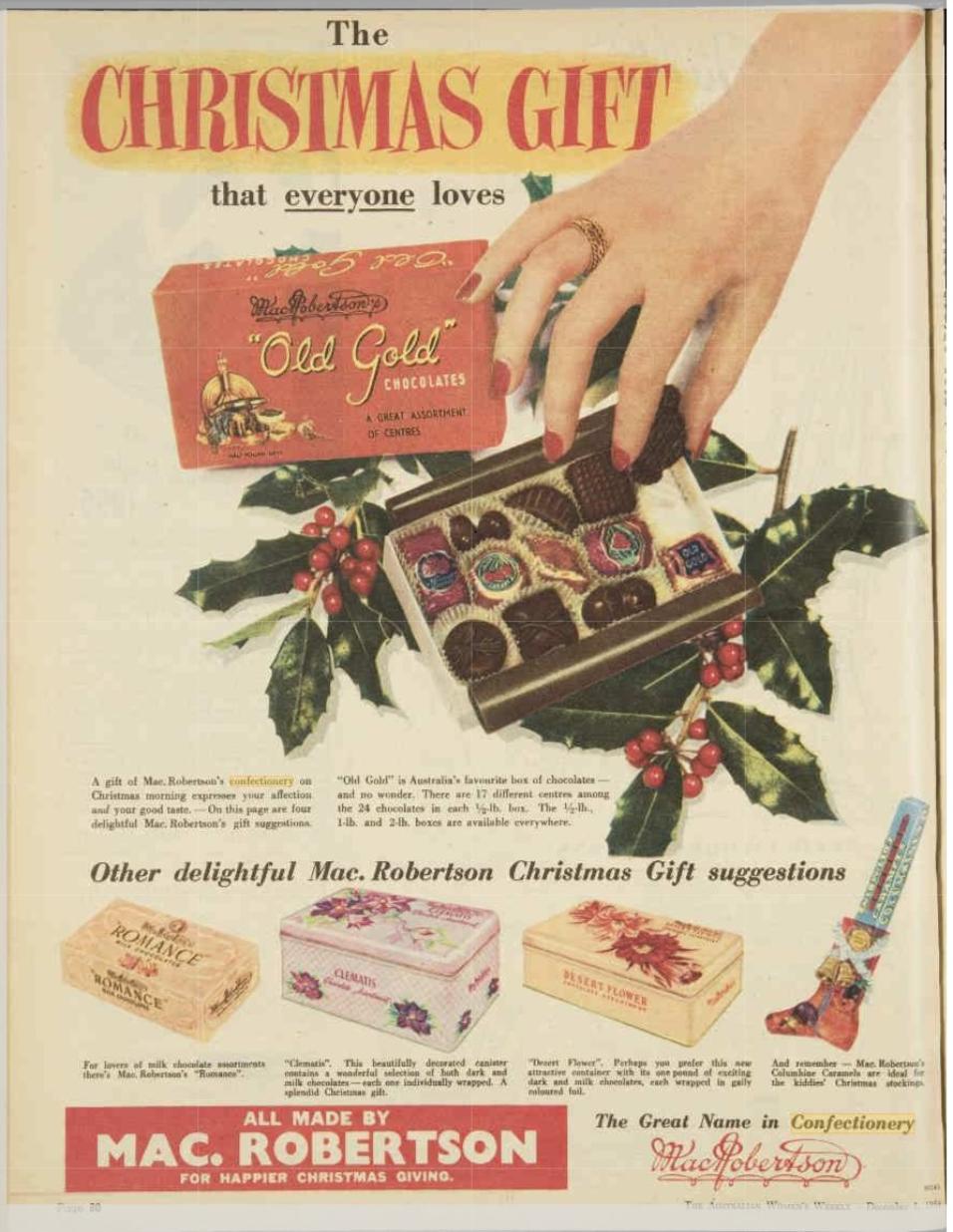
Advertising (1954, December 1). The Australian Women's Weekly (1933 - 1982), p. 80. Retrieved from http://nla.gov.au/nla.news-article41409270
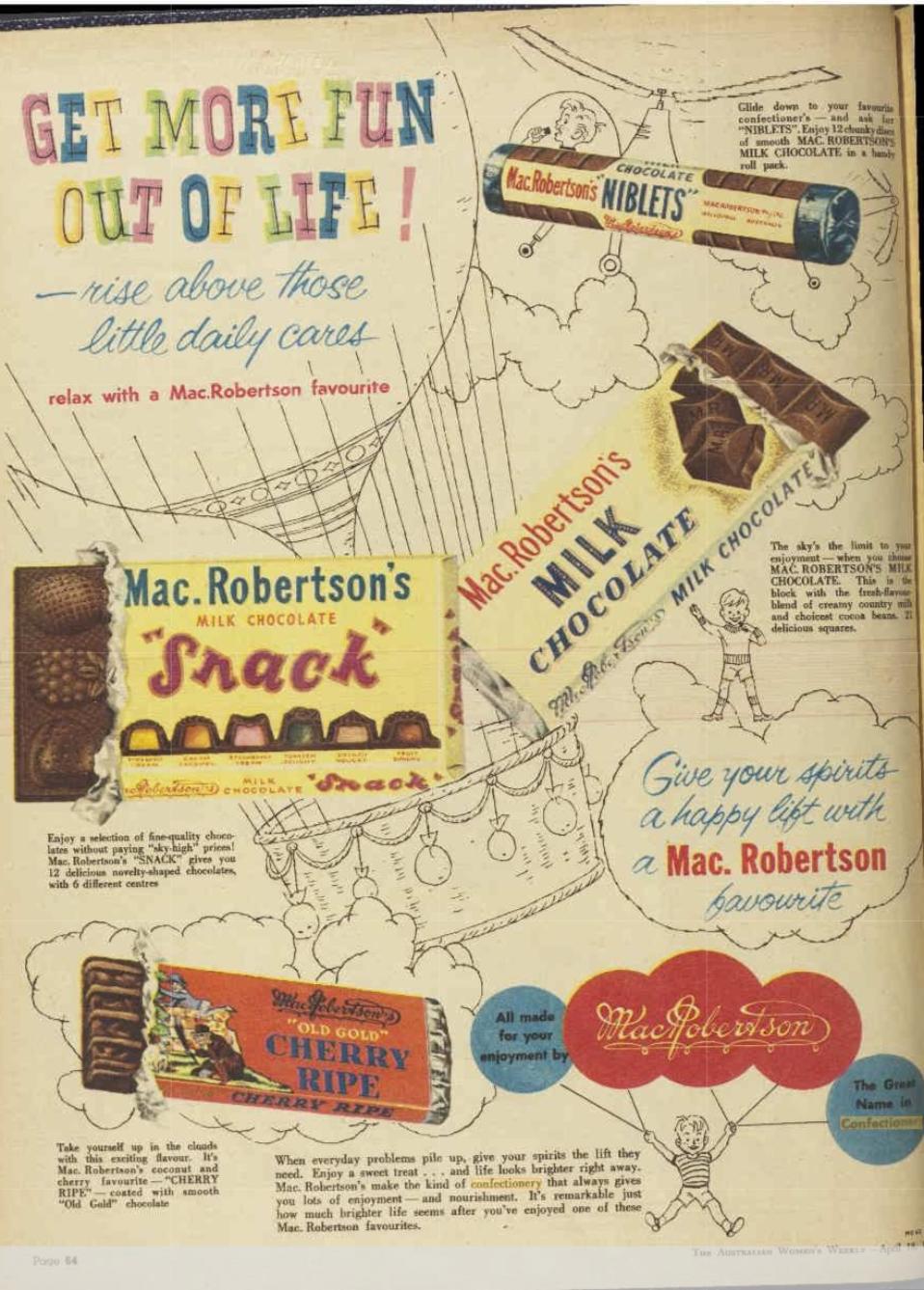
References And Extras
- Trove
- Transcript of David Robertsons' Speech in Opening Nail Can to Knighthood : the life of Sir Macpherson Robertson KBE., 14 July 2015; reproduced from History News (Royal Historical Society of Victoria), Issue 319, August-September 2015, p. 5 - Retreived from: https://www.historyvictoria.org.au/collections-lounge/macrobertson-confectionery/
SWALLOW & ARIELL LIMITED.
The great biscuit factory, roller flour mills, preserving works, and refinery of Swallow Ariell Ltd, constitute one of the largest and most important factories in Australasia. They are by far the largest works of the kind in the Southern Hemisphere.
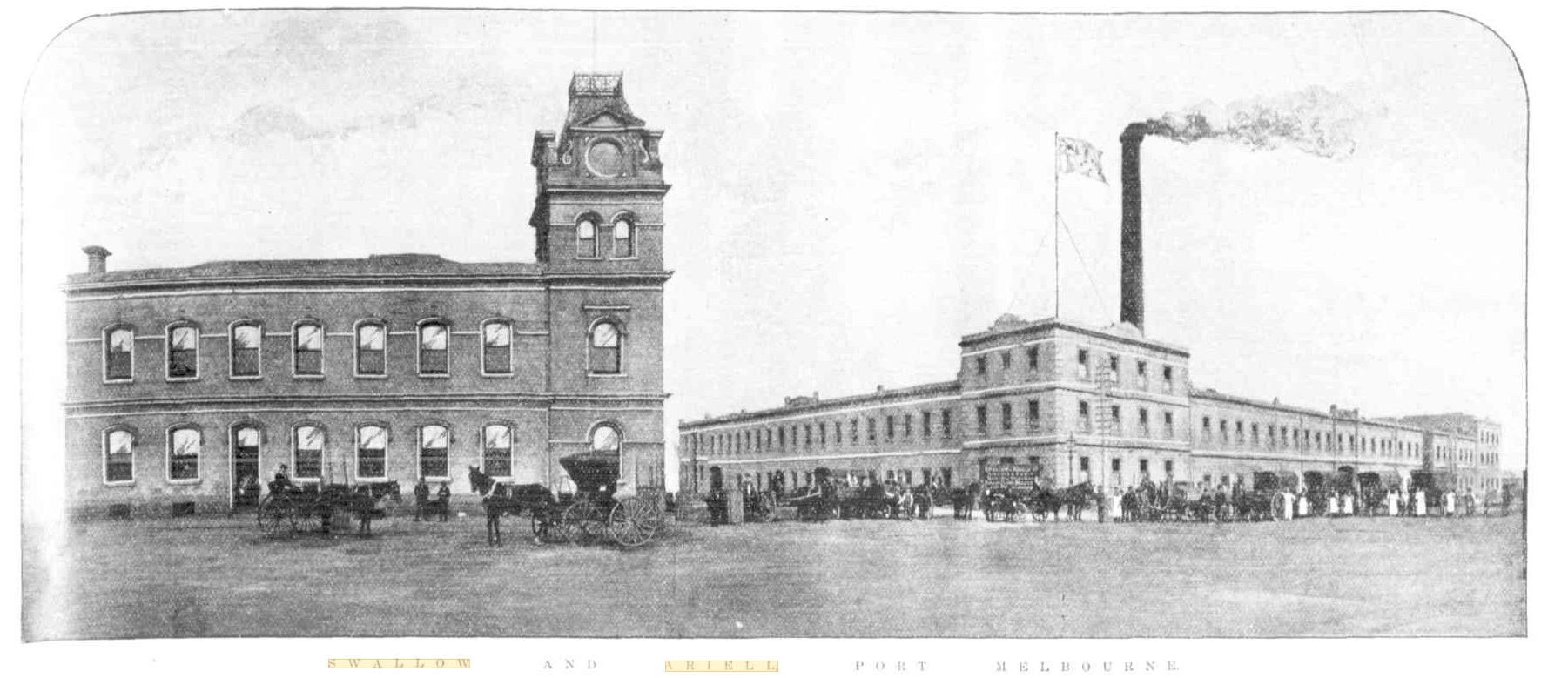
SWALLOW AND ARIELL, PORT MELBOURNE.
The area covered by the buildings is 3 acres, and employment is given to between 700 and 800 hands during the season; while a separate clerical establishment, numbering 36 persons (including travellers), carries out the mass of business which such a factory entails. It not only supplies Victoria, in every part of which Swallow and Ariell's good name is familiarly known, but also Australasia. And not only Australasia, but the East. The firm's reputation is as great in Bombay and in Calcutta as in Melbourne, and it is fast treading in the paths of British pioneers in South Africa. Its splendid biscuits, cakes, jams, jellies, preserves, both of fruit and vegetables, are welcome and wholesome dainties, not only to the fortunate people of Victoria, but to those on the sun-baited plains in Hindustan, the arid wastes of Western Australia, and the torrid veldts of Southern Africa. It is becoming a great southern Crosse and Blackwell, with the advantage that it draws the greater hulk of its raw materials from its own country.
It was established in 1854 by the late Mr Thomas Swallow, the first to introduce biscuit making machinery into Victoria, and flourished so well that in 1858 the erection of the present handsome and spacious manufactory was commenced. The business is now owned by a big and powerful company, and is under the capable management of Mr F. T. Derham, a gentleman who in times past has rendered much service Victoria both as a member of Pariliament and a capable Minister of the Crown. The premises are so large and the nature works so multifarious that It is impossible to do justice to a description of them without occupying a great deal of space.
The firm grinds its own flour, which is chiefly employed in biscuit and cake bakeries, but a large quantity of fine digestive meal is turned out, and also Swallow and Ariell's justly famous self-raising flour. What Is not required is disposed of to bakers and others, so that the flour used in the factories is always new and fresh. Next come the biscuit bakeries, and to the great majority of people the clever machinery employed in the production of the simplest form of biscuits would prove a surprise.
.jpg?timestamp=1576228126858)
SWALLOW AND ARIELL.— THE JAM-BOILING ROOM.
The term "biscuit" is, by the way, in some sense a misnomer, inasmuch as very few varieties are twice cooked. There is a biscuit which is first boiled and then baked, however. While an endless variety of biscuit is manufactured, from captain's and ship's biscuits up to the finest of maccaroons, the processes are very similar. From the time the dough comes out of the kneading machine and passes through what are termed brakes, which press it into sheets of the required thickness, which then go through the cutters and stampers, and finally into the great revolving ovens they are not touched by hand. The machines cut the biscuits with wonderful neatness, and in some instances the superfluous dough is caught up by an ingenious contrivance, which takes it out of the way and leaves it fit for use again. The ovens are worthy of attention. One great revolving oven, 75ft in circumference, works with wonderful rapidity. The speed is easily regulated, according to the thickness of the biscuit. Thick biscuits are carried round in 25 minutes, and turned out baked, while thin biscuits are rattled around in 10 minutes. It was a novelty to eat a fine-flavored biscuit, which was seen stamped out from the dough ten minutes before, but the biscuit was most excellent. In the department where the big biscuits are manufactured, a great variety of cabin, pilot and navy brands, and also dog biscuits, are produced.
In the fancy department tasty lemon cakes, lemon fingers, ginger nuts are produced, and in the dessert biscuit end cake bakehouse a great variety of ratafias, maccaroons, queen drops, short bread, sultana biscuits, rusks. Savoys, craeknells, and cakes of all kinds are manufactured. Everything is as clean as the proverbial new pin. Canterbury cakes, Hopetoun, cakes, Sunbeam biscuits, wedding cakes, Christmas cakes. tea meeting cakes (notable chiefly for their excellent quality and large size), birthday and presentation cakes, cherry ripe cakes, and many other well-known varieties are manufactured there.
A savory smell of cooking denotes that another department has been reached. Here they boil, dry, dessicate and press potatoes, which in this form prove invaluable for use in different ways wherever fresh-grown potatoes are not available. Then the plum pudding branch of the establishment. Huge puddings and tiny puddings — all sizes, in fact— are undergoing all processes, from mixing and spicing and seasoning to boiling. The plum puddings are such as to make old Scrooge himself turn green with envy; full-flavored, beautifully spiced, and boiled to a turn. Adjacent is the department in which vegetables of all kinds are preserved. You can get vegetables of all kinds for a soup pressed into a small block, with a very savory aroma, or you can get blocks of different kinds of vegetables, which will keep in excellent condition Cor years if necessary. A joke is told if Swallow and Ariell's tinned foods. A facetious Kalgoorlie miner, who was beguiling leisure time by preparing a large inscription, "God Bless our Home," suddenly remembered his indebtedness to this great manufacturing firm, and altered the devout wish to "God Bless Swallow and Ariel."
The preserving rooms, where all classes of jams are manufactured, cover a large area, and recently new rooms have had to be erected on the railway reserve, to the west of the factories. These are also on a very large scale. Jam making goes on all the year round. The fruit is pulped in the season, and is then stored for use as required. The filling of the tins is a rapid process of interest. The great coppers are run along on trollies, and the jam is taken out in pourers by two men, who fill the tins as fast as an ordinary clock will tick. There is a special machine for making lemon and melon jam. The best Seville oranges are used for the marmalade. The jams can he had in modest cases of 501b weight. It is all of the best quality that can be produced, and made from the finest fruits and purest sugar. Preserving of fruits and boiling of vegetables is also made a great feature of, and, tasting these, one can understand the popularity of the firm's wares, especially in tropical countries, where fresh fruits and vegetables are difficult to obtain. The company carries on a very large business in Western Australia, its products being very popular on all the gold fields and in the cities and towns. About 18 months ago Swallow and Ariell established preserving works in Mildura, where, in the season, they employ from 70 to 100 hands. This establishment is of great benefit to the local fruit growers. The Melbourne offices of the company are at Nos. 10 and 12 Queen street, and their depot is at No. 2 Bond street.
.jpg?timestamp=1576228047058)
SWALOW AND ARIELL.— THE BAT STREET STORE. SWALLOW AND ARIELL.— PORTION OF THE ORNAMENTING ROOM.
SWALLOW & ARIELL LIMITED. (1898, September 10). Weekly Times (Melbourne, Vic. : 1869 - 1954), p. 51 (SUPPLEMENT TO THE WEEKLY TIMES). Retrieved from http://nla.gov.au/nla.news-article222626716
MacRobertsons
Macpherson Robertson (1859-1945), industrialist and philanthropist, was born on September 6th 1859 at Ballarat, Victoria, eldest of seven children of Macpherson David Robertson, carpenter, and his wife Margaret, née Brown (e). His father, born in Uruguay of Scottish parents, came to Victoria from Leith, Scotland, and the family lived precariously while he moved between gold-seeking and work as a builder. In 1869 his father dispatched the family to Scotland, while he went to Fiji. Macpherson blamed his father for the penury that forced him to leave school and become a breadwinner, although this did afford him his initial training in sugar confections.
After his grandmother (in Scotland) passed away, leaving him £70, the family returned to Melbourne in 1874, and he served an apprenticeship with the Victoria Confectionery Co. and gained experience with other confectionery firms prior to commecning his own works, initially making these in his mother's bathtub four days a week and selling them by walking through the streets for the rest of the week.
In 1879 he is mentioned in:
THE MELBOURNE JUVENILE EXHIBITION.
A considerable stir was created towards the eastern end of Bourke street by the opening of the exhibition of juvenile industry in the basement story of the new market yesterday. The doors were opened at half past 12 o clock, but the ceremony did not take place until 2 For an hour and a half therefore the early visitors had an opportunity of overhauling the articles on view before the place became crowded with the hundreds who put off their coming until the arrival of Ilia Excellency the Governor and Lady Normanby the getting up of this exhibition has been attended with several difficulties The project was started about 18 months ago, soon after the Ballarat exhibition was held. For some time the Executive Committee, appointed at a meeting of manufacturers and others in the Town hall, were at a loss where to find a building, and it was even thought that a special one would have to be erected.
Ultimately, however, they ascertained tint the use of the Elstern Market, expected to be completed before Christmas, could be obtained at a rent of about £1,000 from the corporation. Their anxieties then came to an end, and all that remained to be done was to make arrange menta for receiving exhibits, which it was foreseen would come in in plenty, and to induce liberal citizens to offer special prizes
THE EXHIBITS
… the sweetmeats and confections from Mr Macpherson Robertsons’ factory at Fitzroy contain some shapes that are curious rather than attractive, such as models of hands, busts, sheep, dogs, &c… THE MELBOURNE JUVENILE EXHIBITION. (1879, December 24). The Argus (Melbourne, Vic. : 1848 - 1957), p. 6. Retrieved from http://nla.gov.au/nla.news-article5968129
The business expanded quickly, drawing in most of the family. By the late 1880s MacRobertson's Steam Confectionery Works with over thirty employees had begun to expand by acquiring and demolishing nearby housing.
CONFECTIONERS.— Good Hand, jubes, fondants, Jellies, &c. MacRobertson, 145 Argyle st., Fitzroy. Advertising (1884, November 14). The Age (Melbourne, Vic. : 1854 - 1954), p. 8. Retrieved from http://nla.gov.au/nla.news-article191475301
He married in the Winter of 1886:
Engagements.
THE marriage of Mr. Macpherson Robertson and Miss Elizabeth Alice Hedington is to take place in the Presbyterian Church, Nicholson Street. Family Notices (1886, July 9). Table Talk (Melbourne, Vic. : 1885 - 1939), p. 10. Retrieved from http://nla.gov.au/nla.news-article145713283
Marriages Robertson—Hedington.—On 8th July, by special licence, at North Carlton Presbyterian Church, Victoria, by the Rev. T. W. M'Gregor, M'Pherson, eldest son of David Robertson, to Lizzie, second daughter of George Hedington, both of Fitzroy. Family Notices (1886, August 14). The Tasmanian (Launceston, Tas. : 1881 - 1895), p. 27. Retrieved from http://nla.gov.au/nla.news-article200325909
A family disagreement followed his marriage on 8 July 1886 to Elizabeth Alice Hedington. He left the business to found the American Candy Co. His skills, however, were indispensable and within a few years he returned, although bitterly resenting presentation of the enterprise as his father's - whose name was attached to many of the Patents taken out - and heartbroken after the loss of his son:
ROBERTSON.—Ernest Macpherson, the only beloved son of Elizabeth and Macpherson Robertson, of Napier-street, Fitzroy, after a few hours' illness, aged two years and seven months. Dearly beloved and deeply regretted. Family Notices (1889, November 7). The Argus (Melbourne, Vic. : 1848 - 1957), p. 1. Retrieved from http://nla.gov.au/nla.news-article8569362
In 1890 his daughter, Stella Irene, was born.
CARPENTER, for short job. Apply before nine o'clock, MacRobertson, confectionery works, Mitchell-street. Advertising (1890, June 3). Bendigo Advertiser (Vic. : 1855 - 1918), p. 3. Retrieved from http://nla.gov.au/nla.news-article88985262
9, 798. Macpherson David Robertson trading as MacRobertson— All classes of confectionery. (Advertised on 7th instant.) The mark shown in advertisement should be preceded by the words A distinctive wrapper on which appears the following matter :— and followed by the words The wrapper in of wax paper with twisted ends. TRADE MARKS. (1904, June 21). Government Gazette of the State of New South Wales (Sydney, NSW : 1901 - 2001), p. 4912. Retrieved from http://nla.gov.au/nla.news-article226410703
10,811. Macpherson David Robertson to Macpherson David Robertson and Macpherson Robertson, trading as "Mac Robertson Certificate of Trade Mark No. 9,798, for a wrapper having thereon a representation of a cow, also the signature "MAC ROBERTSON" &c.,— to be applied to all classes of confectionery. 27th February, 1906. TRADE MARKS. (1906, April 19). Government Gazette of the State of New South Wales (Sydney, NSW : 1901 - 2001), p. 2421. Retrieved from http://nla.gov.au/nla.news-article226476285
Macpherson Robertson was the driving force behind the firm's phenomenal expansion. Some of his flair for product innovation, eye-catching packaging and skilful promotion reflected his world tour of 1893, when he worked in the United States of America. His impressions of 'Colossal America' were published in the Ballarat Courier in 1894. Robertson introduced chewing-gum and fairy floss to Australia, promoting Pepsin Gum through his cycling school, and through testimonials from prominent sportsmen. The Patent as kept in the National Archives of Australia shows the colour and design used:
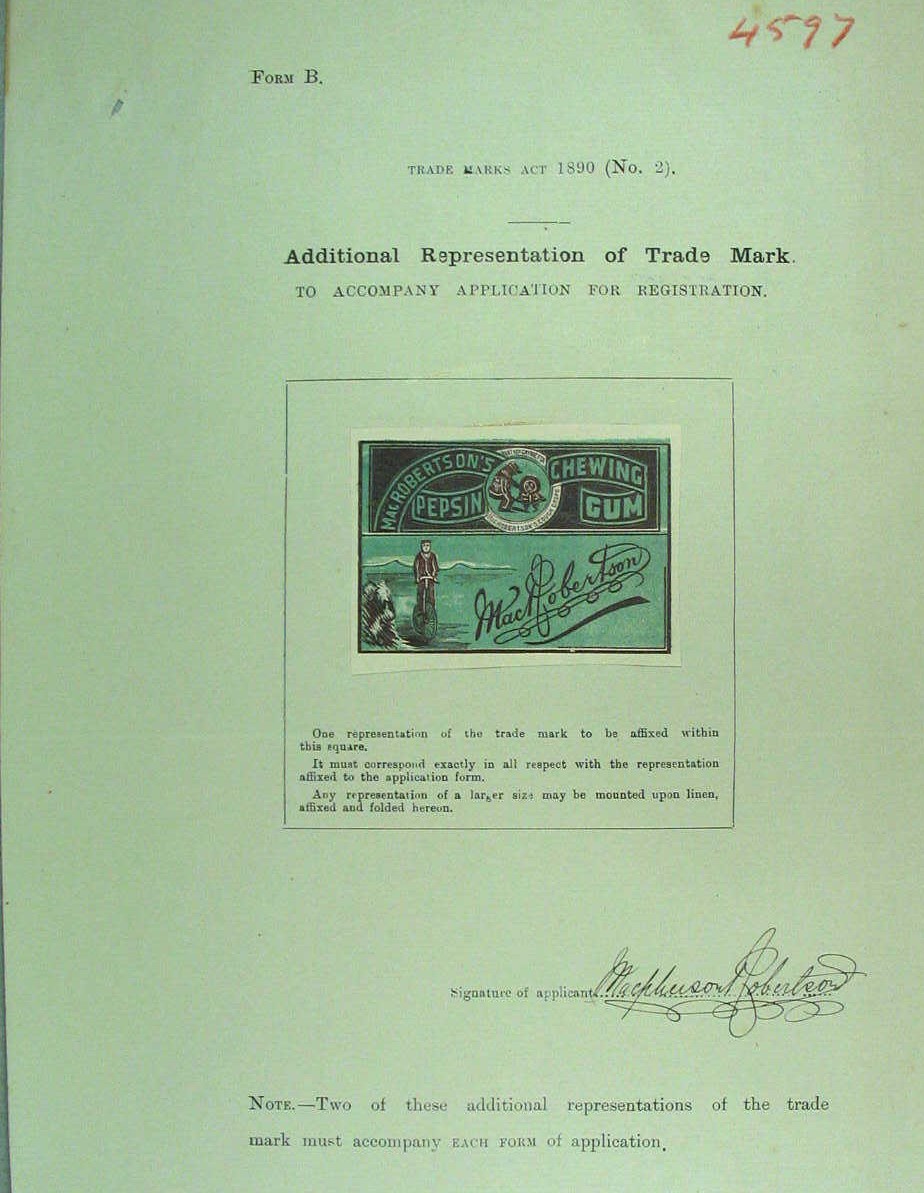
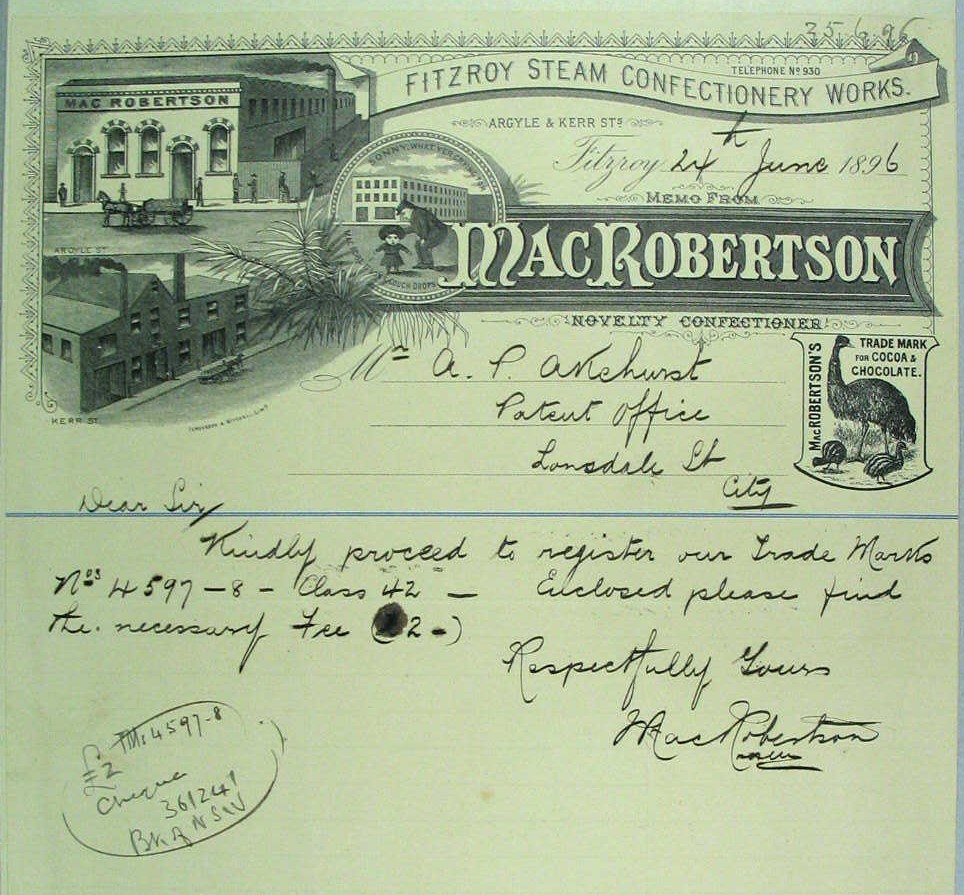
Chewing Gum and MacRobertson.
IF there has been one name brought more prominently before the Australian public than another during the past twelve months, that name is MacRobertson. Turn where you will, and you -will find. MacRobertson's Pepsin Chewing Gum. It is as pronounced as tinned tacks to a cyclist. A description of a visit to the establishment of MacRobertson recently to obtain a few particulars about " Gum," should therefore be interesting reading. In the gum department there are forty-eight girls all in white overalls and white caps as busy as bees, wrapping up and labelling the various kinds of chewing gum. Mr. MacRobertson courteously explains the various interesting processes while acting as cioorono.
Chewing gum is made from an insoluble gum, and, duly incorporated with other ingredients-medicinal and otherwise-and flavoured to suit all palates. After being rolled out and cut into different sizes, the product is handed over to the girls for packing and to be placed into boxes. The display of artistic labels of unique design, all in the interests of " chewing gum." make one marvel at the enterprise and the invention shown by the proprietor.
Mr. MacRobertson made a special trip to America to discover the process of manufacturing chewing gum, and had exceptional difficulties to contend with, owing to the American manufacturers-and at that time there were only six engaged in the trade being determined not to divulge the trade secret. However, after working Boston, New York and Philadelphia respectively Mr. MacRobertson obtained an inkling that put him on the right track, and now the gum productions of MacRobertson's are known all over Australasia. The artistic labels and elegant boxes would adorn any chemist's window, while the contents of the boxes are certain to give dyspeptics an appetite. Amongst the varieties of chewing gum brands are Pepsin, Celery, Cafe Clove, Trilby, Tutte Frutte. Trilby and Koj Kure. Several unsolicited testimonials from doctors, barristers and others are on view in the office. They pronounce the chewing gum a great source of relief in cases of indigestion and dyspepsia. Its use ensures an appetite. To athletes its use is invaluable as it maintains stamina and endurance. To singers and public speakers-as the latest testimonial from a well-known solicitor says-its use renders the voice strong and clear, and keeps the mouth moist when speaking. It has a very soothing effect, and generally is a palliative.
MacRobertson's establishment in Fitzroy covers about three acres of land, and 260 employes are seen at work all clad in snow white linen in this veritable beehive of industry. The enterprise shown in this establishment is worthy of emulation, but to keep up the pace with MacRobertson, who is a man of many parts, is a task more easily attempted than accomplished by competitors. Mr. MacRobertson seems to have all the push and enterprise generally found in Americans which is blended with the determined perseverance characteristic of an Englishman. He designs all his own labels and boxes which are great improvement on the American wrappers and are most attractive. The number and variety of sweets made at this establishment is positively bewildering, they range from the modest boiled lollies to the high-class French and American sweets, and the fruits and flowers made all in sugar are constantly being mistaken for real.
Adjoining the factory is a bicycle department also managed by Mr. MacRobertson, and a bicycle school. The latest novelty here is a bicycle social, where the riders sit side by side. Its motion is delightfully light and cosy, and it looks well when going. A light weight and heavy weight can ride at one and the same time. The machine balances the same as a bicycle. Indeed, the handle can be moved to the middle and one of the seats placed behind it, and so transform the machine into a veritable bicycle. Chewing Gum and MacRobertson. (1896, November 6). Table Talk (Melbourne, Vic. : 1885 - 1939), p. 14. Retrieved from http://nla.gov.au/nla.news-article145932231

By the early 1900s MacRobertson's had established a reputation for quality and variety and had secured a large share of the confectionery market, previously monopolised by English importers. Federation gave access to an Australia-wide market and later on the disruption of imports in World War I allowed Robertson to make further inroads.
MACROBERTSON.
Within the handsome case under review are the products of the modern confectioner in all their artistic forms, blends and beauty. MacRobertson started in business twenty-three years ago with the proverbial man and a boy, and by constant plod, plod, plodding ascended the Australian candy ladder, and to-day occupies the top step, and finds employment for between 700 and 800 hands, and the firm manufacture every known variety of confectionery. The endeavour and patriotism of the firm is to manufacture every sweetmeat that Australians desire, and the exhibits in the show case in every instance are the products of Australian Workmen (born and bred), and who were educated in confectionery by the firm, and it is a matter of practical impossibility to excel the productions in quality, purity and artistic Workmanship.
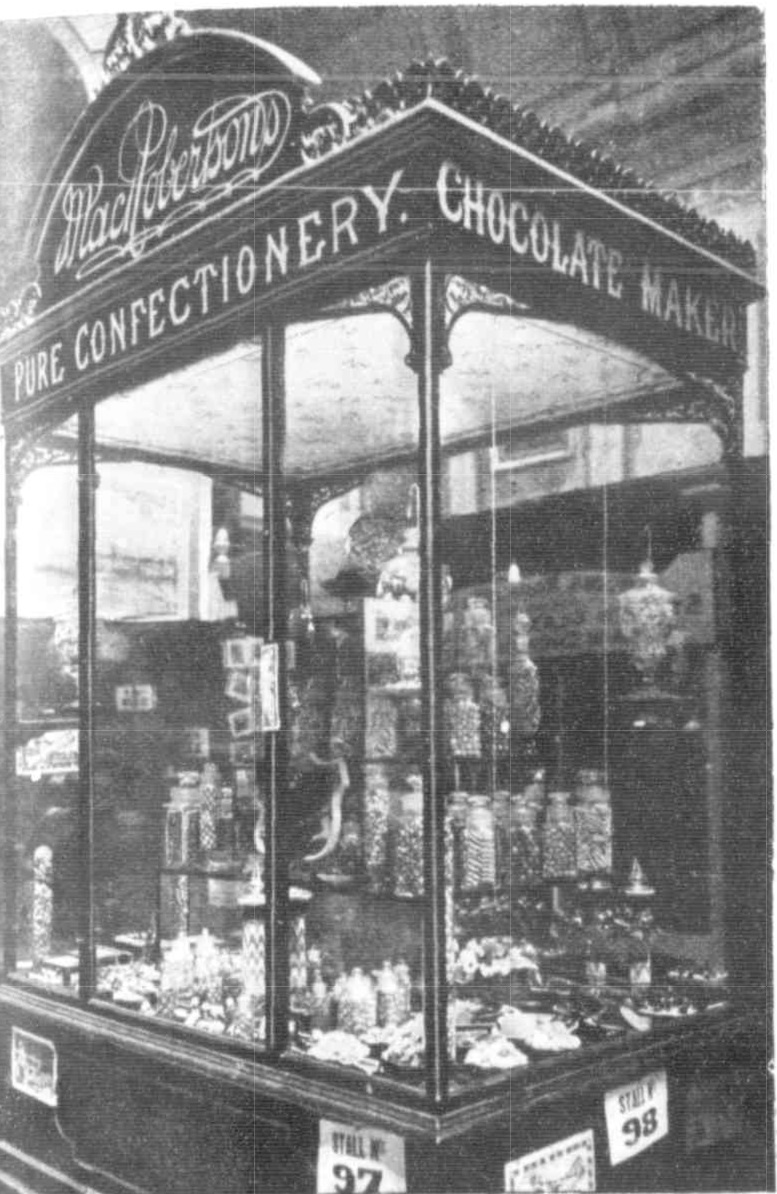
By a new process of sugar boiling the boiled sweets of MacRobertson's do not cling or become sticky. This has hitherto been a drawback in this class of goods, but "the Difficulty is now overcome by the firm, and they are now almost crystal clear in appearance and rattle in their tins and boxes like pellets (the trade will undoubtedly appreciate the quality). Lettered and figured rocks are one of the features in the case.
A splendid construction, also in almond paste, representing a miniature lake, within a lawn, and a bridge spanning the water, and swans swimming beneath. A very handsome jewel casket, made in rock candy and sugar dainties, which denote the arctic skill of the sugar artisan. The imitation of glass marbles. This, too, is a fine piece of work, the variegated stripes being quite visible through each the crystal clear casing. Then the sathuttes, a very popular form of sweetmeat as brilliant as a mirror. The baskets of flowers and fruits, raspberries and cream, strawberries and cream, blackberries and other fruits are the most natural imitation it is possible to proih:e and last, but out not least, the inn small small rose-ftin Australian bud buttonholes are simply perfection. Surely such a combination of excellent productions produced by Australian workmen, goods of character, quality, variety and puritv one ti^T 1 that it is most unjust and unpatriotic to seek the products of anything but those inn..ne turnover of the firm of MacRobertson , during the last twelve months rnuum, approximates — 4000 tons sweetmeats. When this is taken into serious sr 2Sri? ffitei^r sweet tooth the Australians have. In conclusion, we must admit that it is a most agreeable revelation to realise that Australia can produce such excellent goods from pure sugar. MADE IN AUSTRALIA. (1904, October 20). Punch (Melbourne, Vic. : 1900 - 1918; 1925), p. 11. Retrieved, from http://nla.gov.au/nla.news-article175405568
He established his own engineering department to manufacture plant, and launched the exclusive 'Old Gold' line of chocolates. The largest confectionery works in the Commonwealth, with agencies in every State, it was known by the distinctive MacRobertson signature.
NEW PATENT APPLICATIONS.
Commonwealth patent applications have been recently filed in the following 21 cases by Messrs G. G Turri and Co., of the Office for Obtaining and Selling World's Patents and Trade Marks, 364 Collins-street: —
FOR AUSTRALIAN INVENTORS.
Chocolate confection making; Mac. Robertson NEW PATENT APPLICATIONS. (1907, January 19). The Age (Melbourne, Vic. : 1854 - 1954), p. 15. Retrieved from http://nla.gov.au/nla.news-article196162447
In 1902 his mother passed away:
DEATH OF MRS. MARGARET ROBERTSON.
It is with feelings of profound regret that we have to chronicle the death of Mrs. Margaret Robertson, wife of MacPherson David Robertson, manufacturing confectioner, of Fitzroy. It will be within the memory of all that Mr. and Mrs. Robertson left Melbourne late in April for an extended tour of the world, and intended staying for a period of two months in Japan, thence on to America via Honolulu, thence to Britain and Europe to Palestine, and via India back to Melbourne, spending in all about twelve months. It is also noteworthy that the trip was under taken with the express idea of restoring Mrs. Robertson to her former good health. During the past six months she had been ailing, and gradually weakened and allowed herself to drift into a low state, but pending the month prior to sailing she began to recover day by day up till the very day of her departure. Reassuring and agreeable messages were received by the family from Mr. Robertson during the route as far as Hong Kong, but on Thursday last a private cable to the family announced her death.
The deceased lady was an Irishwoman, and of a most exemplary character, being "just" in the most acute sense, forceful, plodding, and energetic in the extreme, with not an idle bone or muscle, a lady particularly observant to all surroundings, conversant on any subject, and possessed with a keen and retentive memory, the events of her life being tabulated indelibly upon her mind and ready for instant reference. She was a mother of mothers, with a deep-rooted love for her children.
It was this splendid woman that first launched the business of " MacRobertson's," with the assistance of one of her sons, just 20 years ago. Under her progressive and just influence, her husband and family have guided and built up their present business. One of the chief characteristics of Mrs. Robertson's life was the binding of her family together, and the possibility of their drifting simply created within her a stronger desire to clasp them still more closely. 'This is proved by the fact that she was in daily verbal contact with the whole of her family. The loss of this courageous woman is a national loss, and it is with the keenest sorrow that we tender our sympathies to Mr. Robertson and his family in their unfortunate bereavement. Naturally, Mr. Robertson has postponed his intention of proceeding further, and is now returning to Melbourne with the remains of his late wife. DEATH OF MRS, MARGARET ROBERTSON. (1902, June 13). Mercury and Weekly Courier (Vic. : 1878 - 1903), p. 3. Retrieved from http://nla.gov.au/nla.news-article58580711
His father passed away a few years later:
DEATH OF MR. MACROBERTSON.
PIONEER CONFECTIONER
THE ROMANCE OF THE TRADE.
The death of Mr. David MacPherson Robertson, founder of the MacRobertson confectionery business, which is known throughout Australia, occurred yesterday morning at his residence in Argyle street, Fitzroy. He had been in failing health for several months, and his death, from heart failure, was not unexpected by his relatives and friends.
The late Mr. Robertson was widely respected. He was born at Monte Video, South America, in 1834. His parents were Scotch, and when a child he returned to Scotland with them. As he grew up he joined his father in the building trade, but the time of the Victorian gold-fields lured him from home when 20 years of age. He arrived in Melbourne by the ship Oliver Cromwell in 1854, and proceeded immediately to Ballarat, and later to Bendigo.
Failing to find the fortune that he had expected on the gold-fields, he engaged in the building trade in Melbourne. He was moderately successful, and saving a little money, he, in 1882, started in the confectionery business in Argyle-street, where now the present MacRobertson factory stands. The last 27 years of his life's history is bound up with the growth of a great manufactory. The beginning was very small. He began with £100 or so of capital, in a little building in Argyle-street, Fitzroy, making boiled lollies in a copper pan. He was his own manufacturer and his own salesman. Industry, skill, and enterprise, however, earned their reward. In 27 years his business capital increased a thousand-fold, and the man who had boiled sugar in a copper pan died the head of the greatest confectionery factory in Australia, employing 800 workers, and sending its produce to every part, possibly to every city, town, and settlement of the Commonwealth.
Mr. Robertson made his business his hobby, and up to the last few months he took an active part in its management. He was always keenly alive to the value of modern machinery, and he took a pride in keeping his factory equipped with the most up-to-date plant in Australia. His wife died at Hong Kong, when travelling, seven years ago. Mr. Robertson leaves one daughter—Mrs. R. J. Burroughs—and five sons. They are Messrs. MacPherson Robertson, William Robertson, David Robertson, and Howard Robertson, who are associated with the business, and Dr. Ernest. Robertson.
The interment of Mr. Robertson's remains will take place to-day at the Melbourne General Cemetery. DEATH OF MR. MACROBERTSON. (1909, August 9). The Argus (Melbourne, Vic. : 1848 - 1957), p. 7. Retrieved from http://nla.gov.au/nla.news-article10724946
After his father's death in 1909, Robertson claimed a half-share, and assigned the remainder of the business to three brothers.
In public the man and the enterprise were synonymous. Dressed immaculately in white, he presided over his Great White City at Fitzroy, a complex of white-painted factories housing several thousand white-uniformed employees.
FITZROY
FACTORY EXTENSION SEVERAL PROPERTIES BOUGHT
To meet growing demands of trade the well-known confectionary making firm of MacRobertsons has decided upon additions to its already large premises, with this in view, Mr Robertson has made several purchases of property in the Immediate vicinity of the works. Mr Provar's property In Argyle street. Mr Candy's, in Gore street, and Mr Fitzsimmons' in Smith street, have all been acquired, and an offer has been made for the Smith street, frontage from Argyle street, to Kerr street. An addition to the Kerr street works Is now in progress, at a cost of about £5600. This building— an extension of the chocolate department— will be finished at the end of the present month There will be an Installation of nearly £5600 worth of chocolate machinery, as well as a 100 h-p. compound steam engine, new multitlbular boiler, and 100ft. chimney stack— engine chimney and stack costing £2000. FITZROY (1910, September 29). The Herald (Melbourne, Vic. : 1861 - 1954), p. 4. Retrieved from http://nla.gov.au/nla.news-article241985549
A Colossal Australian Enterprise
PERFECTION IN SWEETMEATS
The Whole Output—Australian
A SLIGHT idea of what can be and is being done in Australia to-day is manifested by the wonderful window display at the establishment of Ball and Welch Pty. Ltd., Flinders-st, of MacRobertson's Old Gold chocolate confections and satin finished bon-bons, and when one considers that the entire output is purely Australian it certainly is a stupendous achievement for an individual firm. All the work, including box-making, printing and sweetmeat manufacturing, is done on the premises at Fitzroy and the greatest credit is due to Mr. MacRobertson for giving Australia such an advertisement. All the MacRobertson productions are worthy of a place in any home anywhere in the world, and that such a gigantic undertaking as the entire supervision of this enormous factory should be so successfully managed by one man is not only a credit to Mr. MacRobertson himself but something to be proud of by every Australian.
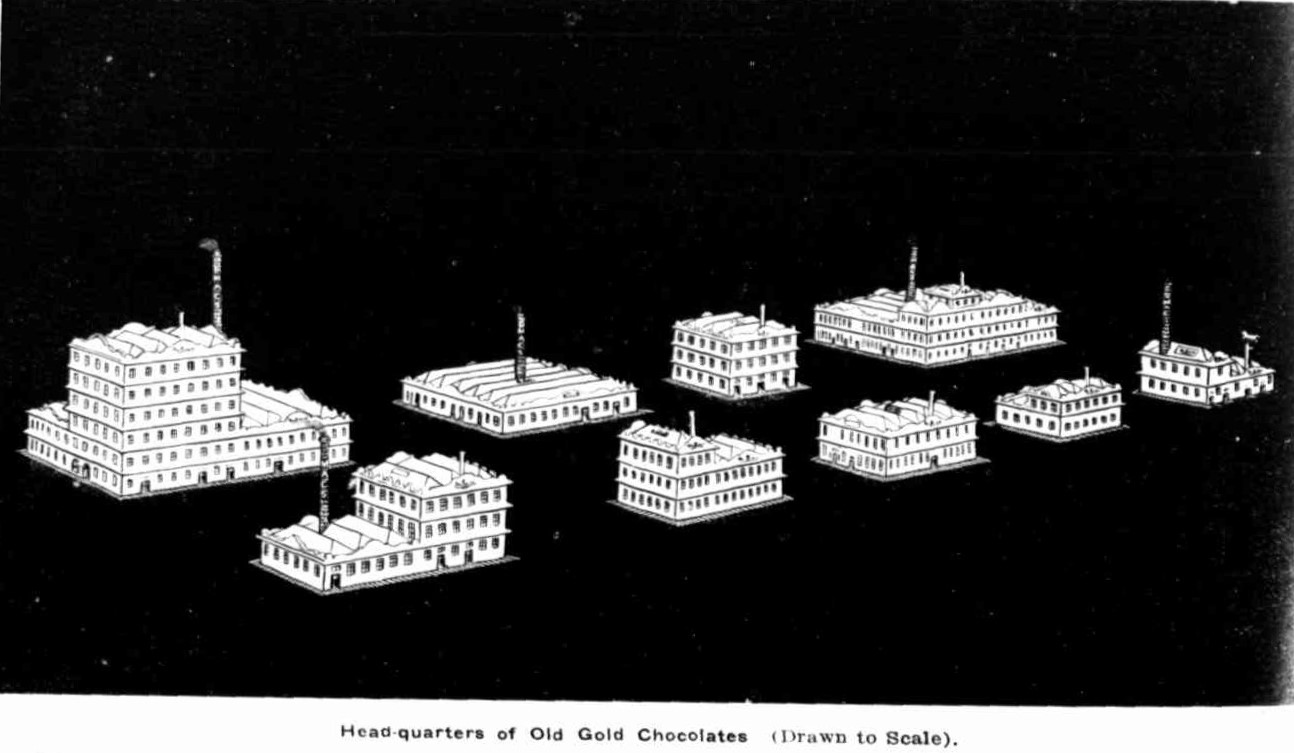
Head-quarters of Old Gold Chocolates (Drawn to Scale).
We of the land of the Southern Cross should advocate Australian goods for Australian people, and when they are brought to such perfection as these we certainly should not pass them by. Now is the time for gift making, and what could answer the purpose better than a box or jar of these wholesome delicacies? No-thing could be more acceptable, and the variety for choice is remarkable. The "Old Gold" chocolates them-selves comprise a very wide range of flavors and fillings, while specially selected assortments are done up in artistic cartons, including Creme-de-Menthe, Mello Mints, Maraschino Cherries, Chocolate Butterscotch, Crunch Foam, etc. Then again, are the "Autumn" assortment of distinctive centres, coated with "Old Gold" chocolate, the "Oriental" variety, the "Presentation" boxes of mixed flavors, the "Masterpiece," "Old Gold de Luxe," the "Aristocrat" assortment and the "1830 Chocolate Coated Caramels," so it will be seen the matter of pleasing the most fastidious should not be difficult. Nothing could be more desirable than the Silk-ee Bon-bons, for they not only appeal to the eye by reason of their exquisite coloring, but are whole-some as well.
In the centre of the window exhibit at Ball and Welch's there is a perfectly modelled bust in chocolate of the immortal William Shakespeare, after the Chandos portrait. It was a happy idea to choose this king of English literature, for, as he leads in genius, so the sweets surrounding it lead in appearance and quality. At the back of the window stands a miniature model, drawn to scale, of the nine factories of MacRobertson's at Fitzroy. When one looks at it, and pictures the original, with all its machinery and army of 2000 employees, it is little wonder that one swells with pride at such an industry in our midst.
When it is remembered that only forty years ago it was started by Mr. Macpherson Robertson, a Ballarat born man, "without a shilling in the world," to use his own words, and that the first confection was made in a threepenny tin pannikin, the progress and development of the firm are all the more remarkable. It is easy enough to start a business with an enormous capital, and even then failures are sometimes made, but when one sets out to build a name for oneself with less than twelve coppers, success is little less than marvellous. Yet Mr. MacRobertson has achieved this. From the handful of sweets in the tin, others were produced and sold, the slender capital being employed to extend the "plant." Having a great liking for the trade, he devoted his whole energy and time to the manufacture of sweet-meats. Early success and an increasing demand enabled him to dispense with the primitive sweets maker and invest in a small copper boiling pot. This pot, which is cherished by its owner, occupies a prominent position at the establishment to-day. From this modest beginning the business steadily grew until at 1921 it stands as the largest concern owned and controlled by one man in Australia.
Prejudice against any locally produced article has always been marked, and in the confectionery trade it has been no exception, consequently the fight has been all the more severe. Some years ago, Australians would not purchase high-priced sweets manufactured here, but would give higher prices for the imported article. But the war altered that. By the prohibition of imports, the public was forced to buy confectionery made in our own land, and it is generally admitted now that the product of the local factories is better and surpasses the imported commodity. As soon as the embargo was placed on outside goods, MacRobertson's set out to manufacture practically the full range of British and Continental confectionery lines.
This firm is essentially Australian, and has branch depots in each capital city, whence the products are distributed throughout the States. In New South Wales alone the business expanded to such an extent that the expenditure of £15,000 on a large store was necessary. Here huge stocks are held of all the firm's manufactures.
The extension of the confectionery business has been followed by the establishment of several other kindred industries. Adjacent to the confectionery works is the box and case-making factory, where every kind of container, from a rough pine box to an elaborate velvet and silk casket, is manufactured. Another important industry directly related to the confectionery business is that of the maize syrup.
Some time ago Mr. MacRobertson sent a party abroad to make investigations relating to the production of this syrup, and to secure an expert. Subsequently Maize Products Pty. Ltd. came into existence. At these works at Footscray over 200 hands are employed, and had it not been for the existence of this industry confectioners throughout Australia would have been in a very serious position, owing to a shortage of the syrup. The success that has attended the establishment of this new industry is primarily due to the efforts of Mr. David Robertson (Mr. MacRobertson's brother) who was included in the party sent *** Australian timber is wholly used in the making of the casks for the syrup, and the *** establish factory (the *** Cask W*** where they are made is the first establishment of its kind in Australia.
Then again, in the making of the chocolates, caramels, etc.. large quantities of condensed milk are used, and *** rates for same were recently *** Mr. MacRobertson, with other manufacturers, investigated the possibility of establishing a milk condensing enterprise under their own control, the result, the Federal Milk Company was formed. Mr. MacRobertson is the principal of all the industries mentioned and they owe their existence primarily to the remarkable development of the confectionery business started years ago with a threepenny pannikin at Fitzroy. At the Fitzroy establishment alone which comprises fourteen acres, nearly 2000 workers are given constant employment, the annual wages bill being approximately £300.000, and within the next two months it is anticipated it will be in-creased to £350,000. Truly, it is an industry we all should all be proud of. The best way to display our pride is to support it to the best of our advantage by always buying MacRobertson goods.
This firm is purely Australian, and not connected with any confectionery firm in Britain, America or on the Continent, and it is certain that establishment in these countries surpass, or even equal the product made by it. To-day it is the factory in Australia, and within its walls every conceivable form of sweet-meat is produced, from the common "boiled sugars" to the most expensive and delicately flavored chocolates. A Colossal Australian Enterprise (1921, December 22). Table Talk (Melbourne, Vic. : 1885 - 1939), p. 32. Retrieved from http://nla.gov.au/nla.news-article146318877
MacROBERTSON'S DISPLAY
The exhibition of MacRobertson's "Old Gold" chocolates, bon-bons, and other dainty confections at Ball and Welch's, in Flinders-street, which is described at length on another page, is an education in Australian taste and workmanship, especially appropriate at this season, and a display which should not be missed during the round of sight-seeing, and we would recommend our readers to view it. MacROBERTSON'S DISPLAY (1921, December 22). Table Talk (Melbourne, Vic. : 1885 - 1939), p. 31. Retrieved from http://nla.gov.au/nla.news-article146318886
His delivery trucks were drawn by prize grey draughthorses, which he readily lent for public processions and drove himself on Eight Hours Day.
EIGHT HOURS' PROCESSION.
MACROBERTSON'S 13 GREY HORSE TEAM.
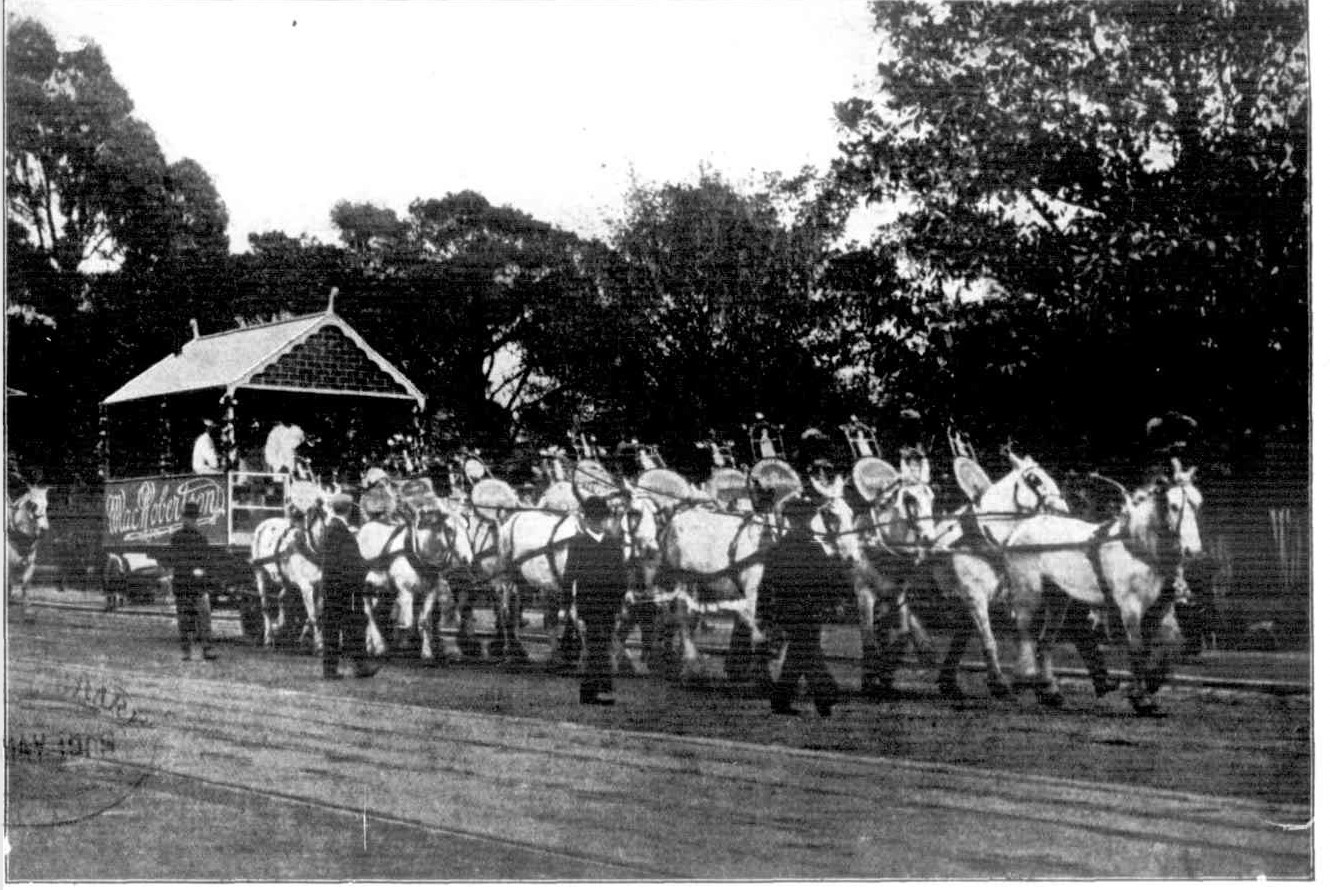
For the past seven years MacRobertson has made a great display for the benefit of the Confectioners' Society of Victoria, but his last efforts eclipsed all previous displays. The illustration represents a magnificent team of thirteen grey horses, gorgeously caparisoned, and artistically surmounted. The greys were yoked three abreast, and a leader, and each horse pulled from his own swingle-tree (the fore horses were not hitched to the collars of the rear horses), thus a contrivance in the shape of special poles and shafts was essential.
Mr. William Hopper, stable chief at MacRohertson, was responsible for the ingenious device. He, too, has the special credit of "reining up" the team, for extreme care was necessary to thread the reins so as to prevent any friction with either the horses or the elaborate, decorations, for it has to be borne in mind that the whole thirteen were driven direct from the seat, necessitating five reins in each hand. It took nearly five months to prepare the decorations used on the team, and the operators—Mr. and Mrs. Hopper and Mr. Jack Elliott—were not confined to the orthodox eight hours, but laboured incessantly and continuously in designing, planning, trimming, and plaiting, so as to be ready in time. The picture gives but a [unit idea of the actual work of the operations above referred to. The team were hitched to a huge lorry carrying a gable top roof as representing a small factory, wherein a number of operators were at work in the manufacture of sweets, which they freely distributed as the procession moved. The team was the feature of the whole procession, and was lustily cheered enroute and universally admired. This team of greys—the finest in Victoria—is valued at ,£1200. In the picture the thirteen horses are shown collectively in their mountings and decoration. EIGHT HOURS' PROCESSION. (1908, May 21). Punch (Melbourne, Vic. : 1900 - 1918; 1925), p. 15. Retrieved from http://nla.gov.au/nla.news-article176016259
His promotion of the romanticised tale of his business, A Young Man and a Nail Can (1921), gave Melbourne a legendary timeline and secured for all time those colourful boiled lollies as well as some of the great boxes and themes used for the range of chocolates:
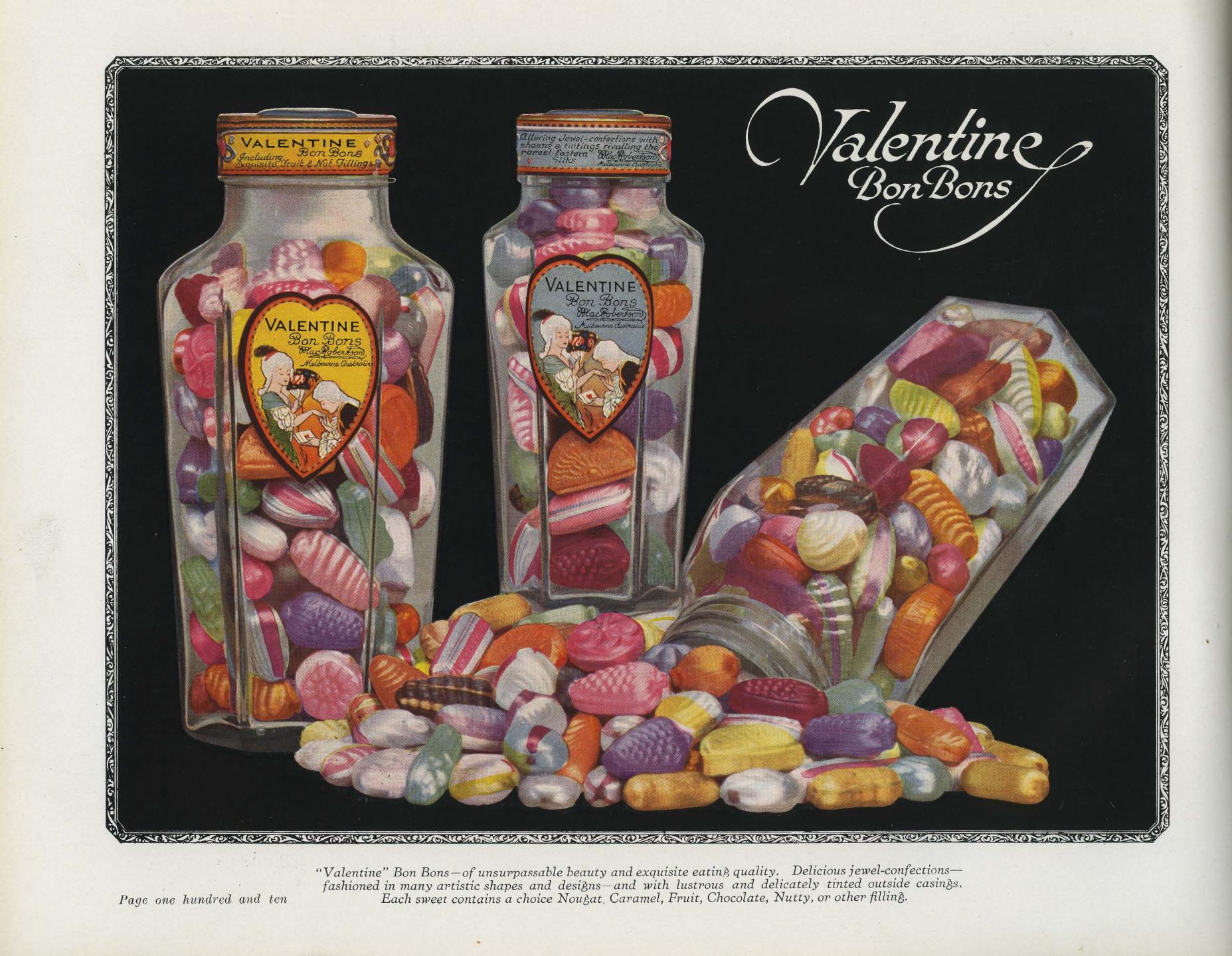
Page 110 from A Young Man and a Nail Can, autobiography of Macpherson Robertson Artist unknown, 1924. 'Valentine' Bon-bons Noel Butlin Archives Centre, N194-349, Federated Confectioners’ Association of Australia, New South Wales deposit - from Australian National University Art Archives
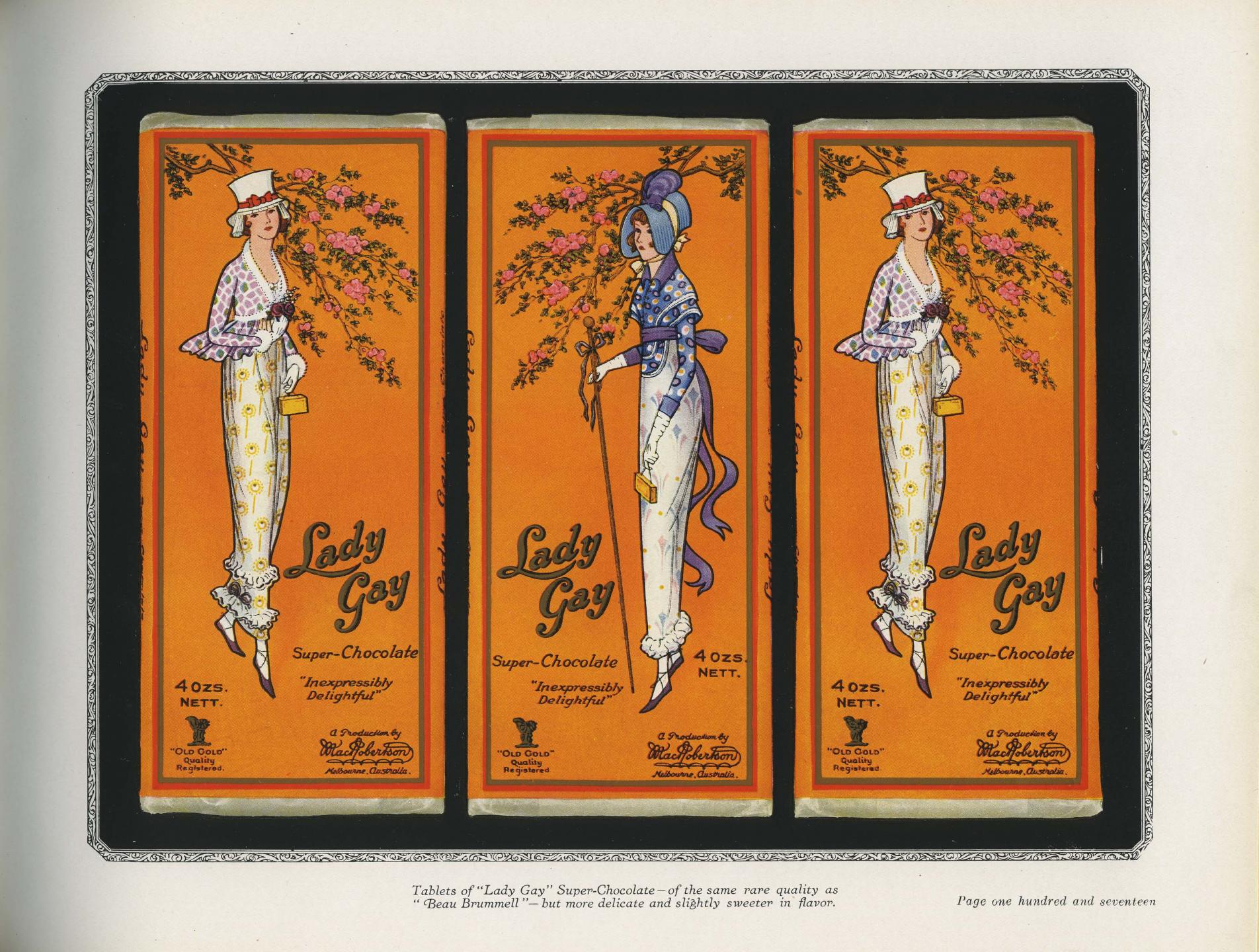
Page 117 from A Young Man and a Nail Can, autobiography of Macpherson Robertson Artist unknown, 1924. 'Lady Gay' chocolates. Noel Butlin Archives Centre, N194-349, Federated Confectioners’ Association of Australia, New South Wales deposit.
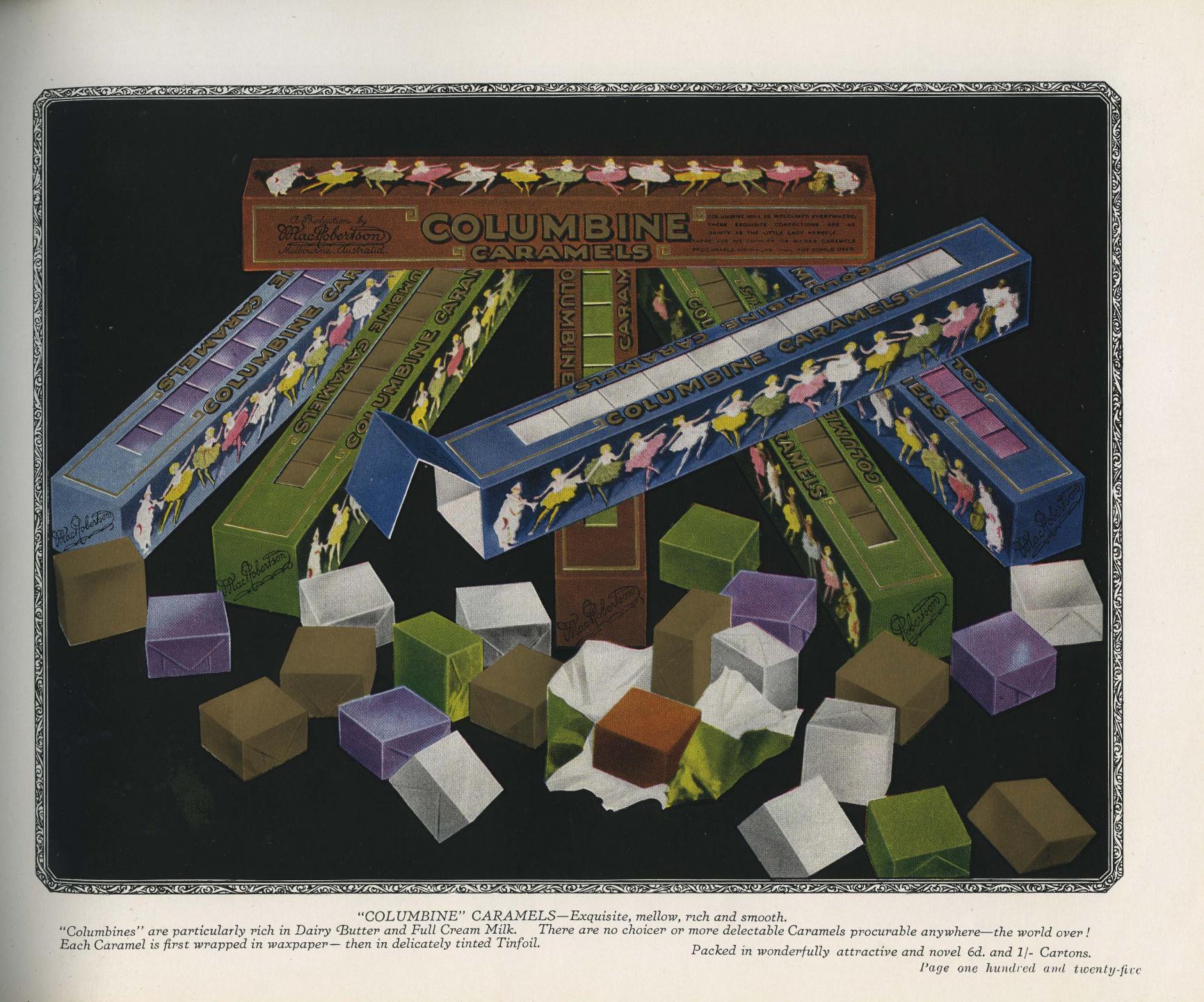
Page 125 from A Young Man and a Nail Can, autobiography of Macpherson Robertson Artist unknown, 1924. 'Columbine' caramels. Noel Butlin Archives Centre, N194-349, Federated Confectioners’ Association of Australia, New South Wales deposit.
MacRobertson's
MELBOURNE.
A GIGANTIC AUSTRALAN
INDUSTRY
The largest confectionery factory in Australia is Mac. Robertson's Fitzroy, Victoria, where every conceivable form of sweetmeat is produced, from the common boiled lollies to the most expensive and delicately flavored chocolate. A visit to the extensive works is necessary to realise its extent and capacity. when it is remembered that the whole organisation has been created by one man, an Australian, born at Ballarat (Mr. Macpherson Robertson), one begins to realise the enormous amount of energy required to carry out such a vast achievement, and what Australia owes to her Napoleons of industry.
Forty-two years ago Mr. Macpherson Robertson started his industry (to use his own words) "without a shilling in the world." The first Mac. Robertson confection was made in a three-penny tin pannikin, and as the lollies were produced and sold the slender capital was employed to extend the "plant." Being enamored of the trade, Mr. Robertson devoted the whole of his time and energy to the manufacture of sweetmeats. Early success and a growing demand enabled him to dispense with the tin pannikin, and purchase a small copper boiling pot. This pot, which is cherished by its owner, occupies a prominent show place in the Mac. Robertson establishment. From this small beginning the business grew steadily, until to-day it stands as the largest concern, founded, owned and controlled by one man in Australia.
Prejudice against the locally-produced article has always been most marked in the confectionery trade. The fight therefore has been all the more severe. Before the war people would not buy high-priced sweets unless they were imported. By the prohibition on imports the public has been forced to purchase Australian confectionery, and it is generally admitted now that the product of the local factories is superior in every respect to the expensive importations. Immediately the embargo was placed on imports, Mac. Robertson's set out to manufacture practically the full range of prohibited British and Continental confectionery. Mac. Robertson's is essentially an Australian institution, for the firm has branch depots in each capital city, from which its products are distributed throughout the different States. In New South Wales business expanded to such an extent, as to warrant the expenditure of £15,000 on a large store, where extensive stocks are held of all the firm's manufactures. The extension of the confectionery business as carried on by Mac. Robertson's has been followed by the establishment of several other related industries. Close to the confectionery works at Fitzroy is the box and case making factory, where every form of container, from a rough boot box to the most ornate velvet and silk chocolate or jewel casket, is produced. The premises are of three stories, having a 90-ft. frontage and a depth of 120 feet. This is the most up-to-date box factory in Australia.
The Mac. Robertson establishment at Fitzroy, a series of white buildings, occupies eight complete blocks. It is being constantly increased, for right from the commencement of his career as a manufacturing confectioner Mr. Macpherson Robertson adopted the practice of employing practically the whole of the profits in the development and expansion of his industry. Some idea of the magnitude of the Fitzroy enterprise may be gained from the fact that the various factories occupy a floor space of 20 acres. Nearly 2,000 workers are given constant employment in the confectionery works. The annual wages bill is approximately £300,000, and within the next twelve months it is expected that the amount will be increased to £350,000. Mac. Robertson's are making a determined effort to cater for Australian requirements, for since the outbreak of war £160,000 have been expended on new buildings, plant, machinery, etc. Part of the new section consists of a large two-storey boiler-house, which accommodates four 40-ton refrigerating compressors and two Babcock and Wilcox boilers. Refrigeration is necessary in the process of chocolate making. The additions have been rendered necessary largely on account of the firm's decision to continue in the manufacture of chocolate and cocoa on an extensive scale. Mac. Robertson's possess an up-to-date engineering shop, which has turned out intricate chocolate-making machinery, and, in addition, numerous chocolate moulds which, prior to the war, were imported from Germany. The Fitzroy plant is now capable of producing every variety of form of mould.
The whole of the buildings in connection with the confectionery and box-making departments have been built by mac. Robertson, employing his own draftsman, architect, and builders, and the new six-storey Old Gold chocolate factory is probably one of the finest set of work- rooms in the whole of Australasia. This six-story building is of the most modern construction, and has an area of 80,000 square feet - with intermediate fire-proof doors—reinforced concrete columns, beams and floors; two isolated stairways and three electric lifts. This building is for chocolate manufacturing, and for the production of first-class chocolate confectionery; all the raw materials are raised to the top floor, then shot or pumped to the lower floors for manufacture into the finished article, ready for delivery. Undoubtedly Mac. Robertson's is one of the most self-contained manufacturing establishments in Australia. A printing branch connected with the works does all the printing for wrappers, boxes, and containers. In fact, the establishment is thoroughly self-contained, and probably one of the most interesting and fascinating industries in this country.
There are 700 lines of chocolates and confectionery produced at the works, from the simple boiled sugars and toffee to the most elaborate boxes of choice "Old Gold" confections. It is unusual for a confectionery manufacturer to undertake the production of so many lines.
In England, America, and the Continent it is customary for a manufacturer to specialise on one line only—one maker will turn out only chocolate tablets, another will concentrate on gum jubes, and so on, but at Fitzroy Mac. Robertson is producing every form of sweetmeat.
The "Old Gold" chocolate productions are constantly being added to, and within the last few months the "Lady Gay" and "Beau Brummell" chocolate assortments have made their appearance on the Australian market. These have been marvellously successful. The centres forming these varieties are of the highest quality, and comprise pieces such as crunch foam, Jordan almonds, Italian cream, marzipan, and many other favorites. The "Lady Gay" variety is packed in a dainty "Old Gold" colored box, upon which is a representation of a lady dressed in the period of about 1820. The "Beau Brummell" assortment, as the name suggests, is embellished with a picture of the famous dandy of George IV's time. The centres in this assortment, are also extremely fine, and the smooth chocolate coating adds to the attractiveness of the whole production.
"Lady Gay" and "Beau Brummell" assortments are only typical of the many other "Old Gold" chocolate productions, such as "Golden Glory," "Regal," "Unique," "Iris," "Aristocrat," and the other well-known packages. These confections stand in the front rank of the world's finest chocolate productions; they represent the highest attainment in the art of chocolate making.
Recently Mac. Robertson has extended in the production of satin-finish confections, and the new design "Fancy Jars" containing the highest grade satin-finish sweets with delicious fruit and nut fillings are making themselves favorites among sweet-lovers. The handsome 1-lb. tins of "Cinderella" bon bons are also on the Australian market, and are enjoying enormous sales. "Cinderella" bon bons are delicious satin-finish sweets with chocolate, fruit, or nut centres, and the outer casings are of a special construction, which crunch quite easily. The casings are also delicately flavored, and are produced in the most beautiful sheens and tintings.
Recent extensions at Fitzroy include a new cocoa factory for increasing the output of the well-known "Old Gold" cocoa. This building is now equipped with the most modern machinery for the production of Cocoa Essence. It can be claimed that there is no fitter cocoa factory in the Southern Hemisphere than that at Fitzroy. An important point to be remembered is that Mac. Robertson's is an essentially Ausralian industry. All the profits made in the business remain in Australia for the development of the confectionery business and other large businesses with which the firm is associated. In these circumstances and in order to assist in the building up of Australian industries, it is the duty of every Australian to purchase goods made by a truly Australian factory, and thus keep the profits in Australia. By making Australia self-contained in her industries a great deal will have been accomplished towards the development of this country. This power rests in the hands of the Australian public. They should patronise such Australian businesses when the business in question is turning out goods equal to, if not better than, those manufactured abroad. MacRobertson's MELBOURNE. A GIGANTIC AUSTRALIAN INDUSTRY (1922, December 14). Table Talk (Melbourne, Vic. : 1885 - 1939), p. 2. Retrieved from http://nla.gov.au/nla.news-article146457610
Employees and customers were offered prizes for sweet-wrapper designs, advertising jingles and messages for 'conversation lollies'.
'Mr Mac' inspired widespread loyalty and affection, taking a fatherly interest in his 'co-workers'. Welfare provisions cemented the harmonious relations. Robertson appeared before the royal commission on the Commonwealth tariff (1905) on behalf of the industry and the Victorian trade union. He sat on the confectioners' wages board (1900-22) and, though suspicious of state intervention and opposed to a proliferation of boards, he refused to join fellow manufacturers in blacklisting unionists and other 'troublemakers'. Robertson looked benignly on unionism, encouraged the Female Confectioners' Union, and observed the closed shop from 1919.
Robertson was the instigator of and major partner in Maize Products Pty Ltd, which pioneered the Australian manufacture of glucose, and in the Federal Milk Co., which made condensed and powdered milk. Subsidiary companies handled his container, paper and printing requirements. Acknowledged as the 'king' of Australian confectioners, Robertson mounted a dazzling display at the 1924 British Empire Exhibition at Wembley, England. This exhibit, according to one interview the year afterwards, cost quite an amount:
'At the time of the British Empire Exhibition, Mr. MacRobertson sent to England; £5,000 worth of sweets which were put on the market and easily held their own with home goods. He said, however, that he only sent the goods as a patriotic Australian and -to please the authorities. He was not looking for English trade. In fact, he would not be able to compete to the best advantage with sweets manufactured under the long hours and lower wages existing there. Moreover, he had no idea of going outside Australia and New Zealand while the local demand was so intense. Australians were the biggest sweeteaters, in the world, and he had not yet been able to manufacture enough for the local market.
Faulty packing and preparation were described by Mr. Mac Robertson as the reason for the failure of many Australian goods to capture trade. Artistic packing and. quality were essential to successful marketing, and he attributed much of his success to the fact that particular attention had been paid to those factors. He secured a commanding grip on the Australian trade just after the war. Then, he said, he saw his golden opportunity and took it. After the cessation of hostilities overseas manufacturers would have established local plants if he had not been in a position to build his own machinery. The works were now absolutely self contained.
Mr. Mac Robertson is a great lover of horses. His greys were well known in Melbourne. The teams, however, are now fast being replaced by the speedier motor vans. He used to take a keen delight in training horses, and one of them, Sultan, demonstrated to a wonderful degree his infinite patience. MR. Mac ROBERTSON. (1925, April 16). The Register (Adelaide, SA : 1901 - 1929), p. 9. Retrieved from http://nla.gov.au/nla.news-article63709639
CHOCOLATES FOR PRINCE
Before leaving for England Madame Evelyn Scotney, the soprano, called at MacRobertson's confectionery and received a casket made from Australian timbers, filled with chocolates. It will be presented as a special gift to the Prince of Wales at the opening of the Empire Exhibition.
In "The Herald" last Tuesday it was incorrectly stated that the box was from Hoadley's Ltd. CHOCOLATES FOR PRINCE (1924, March 20). The Herald (Melbourne, Vic. : 1861 - 1954), p. 8. Retrieved from http://nla.gov.au/nla.news-article244216293
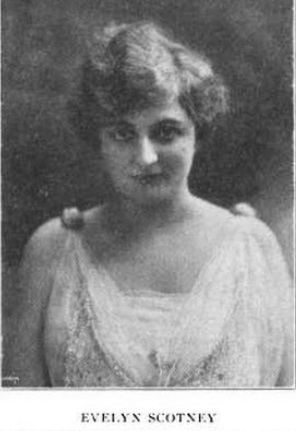 Evelyn Scotney was born in Ballarat in 1896, to Henry Bailey Scotney and Eliza Scotney. Her father was a professor from the University of Oxford who had come to Australia to study minerals, married there, and decided to stay. Her family moved to Melbourne when she was young. She studied singing there with Elise Wiedermann, who also taught Elsa Stralia, Florence Austral and others. She was first noticed by Nellie Melba, while singing at a reception for Lord Kitchener in Melbourne. Melba sent her to Paris to study with her own teacher Mathilde Marchesi. She later studied with Paolo Tosti in London. There she was heard by Henry Russell, the director of the Boston Opera Company, who engaged her to sing in Boston. She first appeared as La Charmeuse in Massenet's Thais, then deputised for Luisa Tetrazzini in the title role of Donizetti's Lucia di Lammermoor, the Mad Scene from which became her most famous part. In this and other roles she was said to surpass Tetrazzini. Her other roles in Boston included Carmen and Olympia (The Tales of Hoffmann). She also sang in Debussy's Le martyre de Saint Sébastien in 1912 with Jeska Swartz, conducted by André Caplet.
Evelyn Scotney was born in Ballarat in 1896, to Henry Bailey Scotney and Eliza Scotney. Her father was a professor from the University of Oxford who had come to Australia to study minerals, married there, and decided to stay. Her family moved to Melbourne when she was young. She studied singing there with Elise Wiedermann, who also taught Elsa Stralia, Florence Austral and others. She was first noticed by Nellie Melba, while singing at a reception for Lord Kitchener in Melbourne. Melba sent her to Paris to study with her own teacher Mathilde Marchesi. She later studied with Paolo Tosti in London. There she was heard by Henry Russell, the director of the Boston Opera Company, who engaged her to sing in Boston. She first appeared as La Charmeuse in Massenet's Thais, then deputised for Luisa Tetrazzini in the title role of Donizetti's Lucia di Lammermoor, the Mad Scene from which became her most famous part. In this and other roles she was said to surpass Tetrazzini. Her other roles in Boston included Carmen and Olympia (The Tales of Hoffmann). She also sang in Debussy's Le martyre de Saint Sébastien in 1912 with Jeska Swartz, conducted by André Caplet.
Evelyn Scotney married Howard J. White, a bass singer with the company, and was then known as "Madame Scotney". She later sang at the Metropolitan Opera in New York, in operas such as Rimsky-Korsakov's Le Coq d'Or, Lucia di Lammermoor, L'elisir d'amore and the revival of Fromental Halévy's La Juive, in which she sang opposite Enrico Caruso.
During World War I she had various tours of Australia with her husband. She returned to the US after the war. It was Evelyn Scotney who appeared opposite Enrico Caruso in his final performance, in La Juive, on Christmas Eve 1920. She sang in Melbourne in 1923. By 1925 she was singing Gilda (Rigoletto) in London. She sang with the Beecham Opera Company and appeared at The Proms in the 1920s.
Evelyn Scotney remarried in London in the 1920s, to B. H. Russell, London manager of the Cunard Line. Their wedding was attended by Sir Joseph Cook (then Australian High Commissioner to the United Kingdom and a former Prime Minister of Australia) and Lady Cook. She and Russell had a son in 1924 and another son in mid-1926.
An Australian coloratura soprano of great renown in the period from 1913 to the late 1920s, her range extended to E in altissimo. In her time she was considered by some to be the world's greatest soprano. She was compared very favourably with Amelita Galli-Curci, Luisa Tetrazzini and others. Her recording of "Caro nome" from Verdi's Rigoletto was described by a critic as "one of the best soprano records in existence", and her recording of The Blue Danube and other Strauss vocal waltzes was described as "absolutely perfect coloratura singing". She appears in The Record of Singing.
What the MacRobertson's Wembley exhibit looked like:
MAC. ROBERTSON'S WEMBLEY EXHIBIT
FINEST DISPLAY IN THE AUSTRALIAN PAVILION
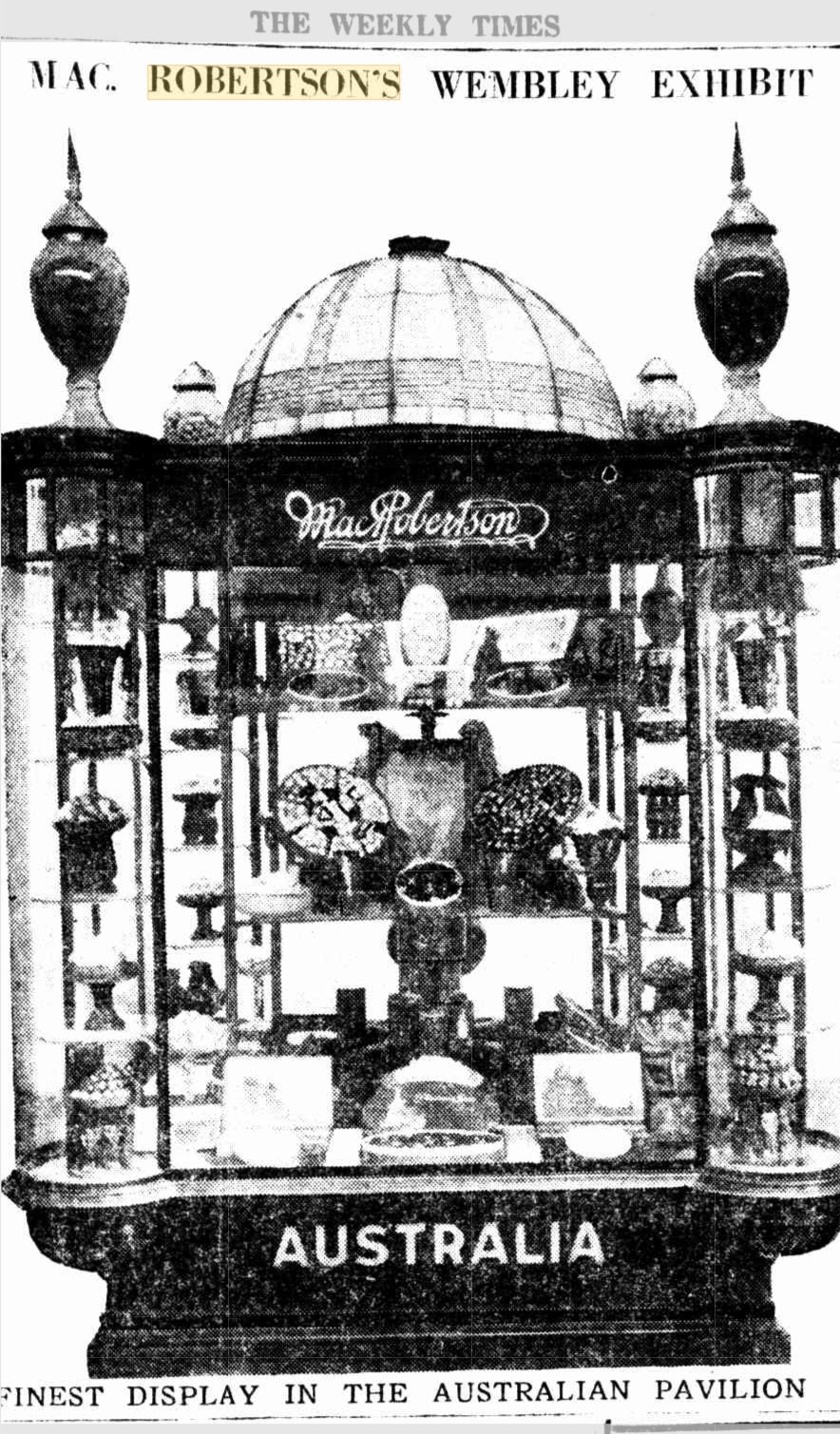
.jpg?timestamp=1576259184033)
The Three Australian Cases Specially Made for Mac. Roherston's Display.
For Letterpress, See Page 12. Photographic Reproductions of Mac. Robertson's Wembley Exhibit appear on Page 61.
. A Triumph in Sweets
Mac. Robertson's Gorgeous Display
The wizard, Mac. Robertson, shows an almost uncanny persistence in being first. From his mother's bathroom in Fitzroy, where he, as a youngster, boiled his first sweets, he set out to capture Victoria in 1880, and won through. Twenty years later, when federation broke down the tariff fences, he over-ran and occupied all the other Australian States. Today behold him at the British Empire Exhibition, his display the most ornate and admired feature of the Australian Pavilion. Characteristically and instinctively, Mac. Robertson is all that is patriotic. But has he, for ulterior object, the capture of the United Kingdom? Really we cannot put it past him, for the man brings grit, energy, imagination and enterprise enough, and withal such intrinsic quality, in his delectabilities, to make such a conquest easily conceivable. Go where you will in London today, go particularly into Bond street, Mecca of the fashionable world, where you find the chocolate de luxe as you find it nowhere else in this wonderful city. Then pay a visit to our Pavilion at Wembley, look as criticially as you like at the Mac. Robertson exhibit, and frankly admit that the Australian has beaten them all. It is a marvellous exhibit. The object that first arrests your eye if you come by the handsome doorway to which the path from the principal railway station leads, it as certainly brings you to a decisive halt if you approach from either of the other two entrances. In the centre of a roomy bay two enclosing sides of which are used for the display of Australian sugars, the exhibit of confectionery has a happily appropriate cadre. Moreover, from the sombre background provided by the sugar cases Mac. Robertson's display stands out in unrivalled gorgeousness...
The centre case is wholly given to chocolate, some of it skilfully moulded into a variety of art groupings. There are, for example, figures of animals supporting lovely vases, each might well be the envy of a sculptor. In the centre of the front a chocolate hare, smugly content, seems to have just alighted within a circle of golden eggs. On either side of him is shown a huge uncovered box of chocolates, in exquisite and varied foilings, gold tone prevailing on the right, silver on the left. Below these are smaller open boxes, displaying chocolates of the same kind, without the foilings, so that the visitor may see them in all their natural wealth of color and perfection of shape, and mark the delicacy of the pipings.
Each piece of chocolate rests in a souffle cup and carries a fruit flavor — pineapple, fig, apricot, date, plum 01 almond. How remarkably fine are the boxes, cartons, labels, etc., which have made the firm famous for handsome display-packing, is exemplified by closed boxes, the covers of which hear exquisite pictures of Beau Brummel, Lady Gay, Dolly Varden, and others. In the centre case also, are the "haver-sacks" of assorted chocolates so much favored as Christmas or Easter presents. The whole arrangement of these delicious things is simply one of those triumphs to which Australians, who nave seen so many of Mac.Robertson's displays at home exhibitions, now take as a matter of course; but it comes as a positive revelation to the wondering eyes of English visitors to the Australian pavilion. The smaller show-case on the left is given principally to a display of Mac.Robertson's Easter Eggs. That on the right shows the boiled sweets for which the firm is noted, with their soft and delicate centres of paste-chocolate, nut, or coffee — not often, we think, found in English-made sweets of the kind. In this case is also a fine model of the thirteen factories at Fitzroy. At night this is lit up by electricity, and is a very brilliant little White City, all on its own.
Of the firm's 700 varieties of confectionery, only chocolate cakes are here offered for sale. Mr G. J. Allen, the firm's interstate expert, who is in charge — with a charming and able assistant in Mrs Allen — started business with 60 tons of these cakes. The demand came early, and has been very brisk. At first, Old Gold were asked for, but when the wonder came to light that so exquisite a confection as the Dolly Varden milk chocolate-was equally available, the precious metal had to give pride of place to lovely woman. Many would like to buy some of those tempting boiled sweets, but they are not for sale. "Sweets" is, of course, the word here, never "lollies." Terms vary with countries. Thinking that Australian children might like to try the confection made on strings for which America is famous, we once went into a San Francisco shop, stocked with varied niceties, and, not seeing what we sought, enquired, "Have you any candy?" "My!" exclaimed the astonished girl-attendant: "Good gracious me, ain't it all candy?" For that is the generic word for sweets under the Stars and Stripes. The Fitzroy wizard has sent to the Exhibition the cauldron in which his first magical sweets were boiled 44 years ago. There it is, alongside the Easter Egg show-ease. A striking contrast, fraught with a valuable lesson, as all Australians know. But is the old nail-can quite safe?
Mr Allen, is vigilance personified, but the curio-hunters are numerous, insatiable, and not always conscientious. Its original value was, we fancy, sixpence! now if it were for sale today — "Perish the thought" exclaims the indignant owner. By all means, since it does not merit life. Germane to the subject, however, is the fact that this very week a rich American bought the ruins of Usk Castle, Monmouthshire, taken and partly destroyed by Owen Glendwyr, in 1402. Whether he intends to ship it across the Atlantic remains to be seen; but, since such things happen, we shall feel easier when Ave know that the precious Mac. Robertson trophy of skill, perseverance and enterprise is safely back in Fitzroy. Now, as to this great Australian himself — Mac. Robertson was born in Ballarat — what is the main factor in his wonderful success? the success of a young man who, with less than half a crown to his name 40 years ago, started a business which, in the intervening time, has so grown that it is now the largest of its kind in the Southern Hemisphere, employing over two thousand hands and paying out nearly half a million yearly in wages. Probably the correct answer has been found by "the Australasian Confectioner," which speaking of him says Vision made Mac. Robertson perhaps ttte most remarkable manufacturer in the ... A Triumph in Sweets MAC. ROBERTSON'S WEMBLEY EXHIBIT (1924, June 28). Weekly Times (Melbourne, Vic. : 1869 - 1954), p. 61. Retrieved from http://nla.gov.au/nla.news-article222807062
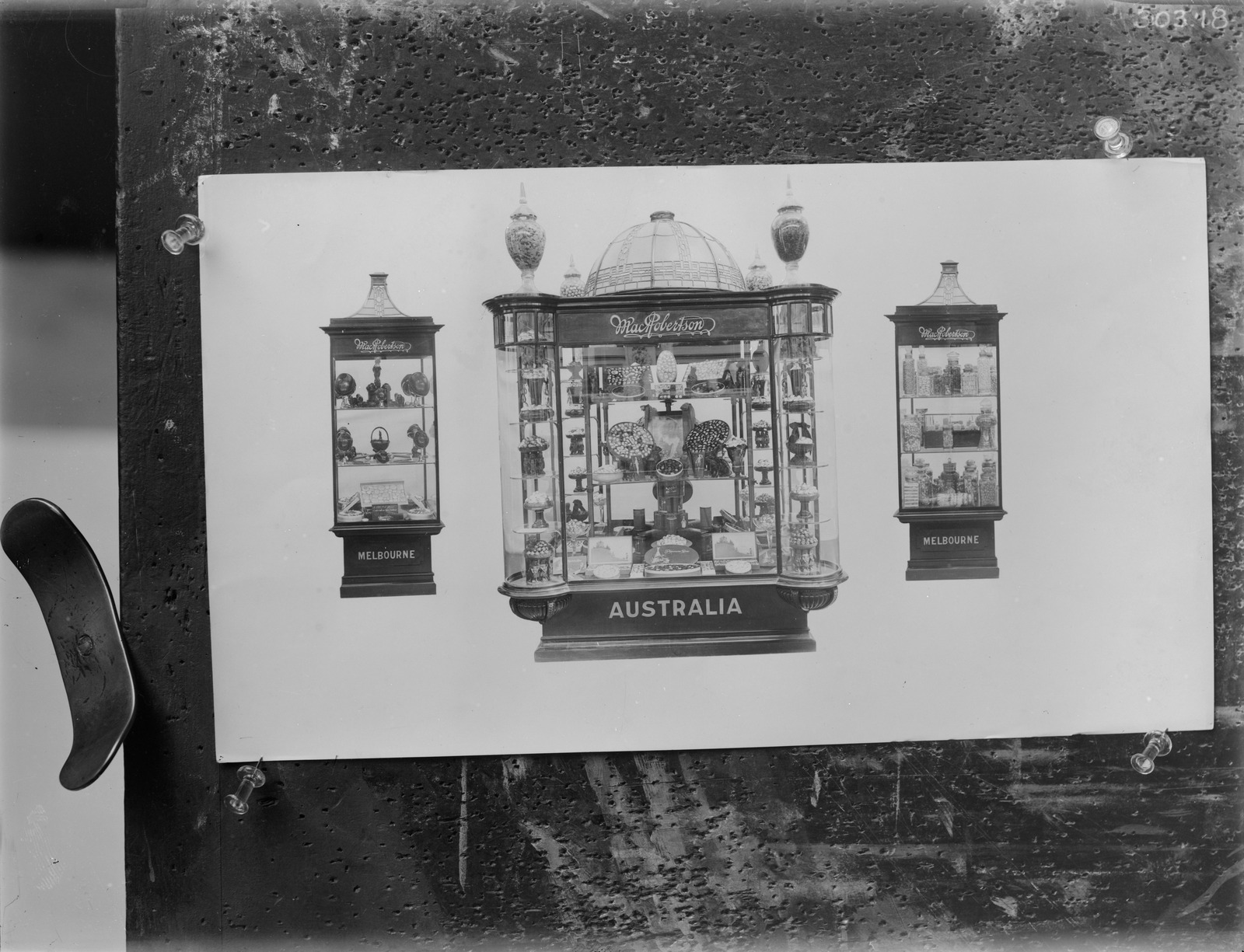
Above: Original layout display - courtesy State Library of Victoria
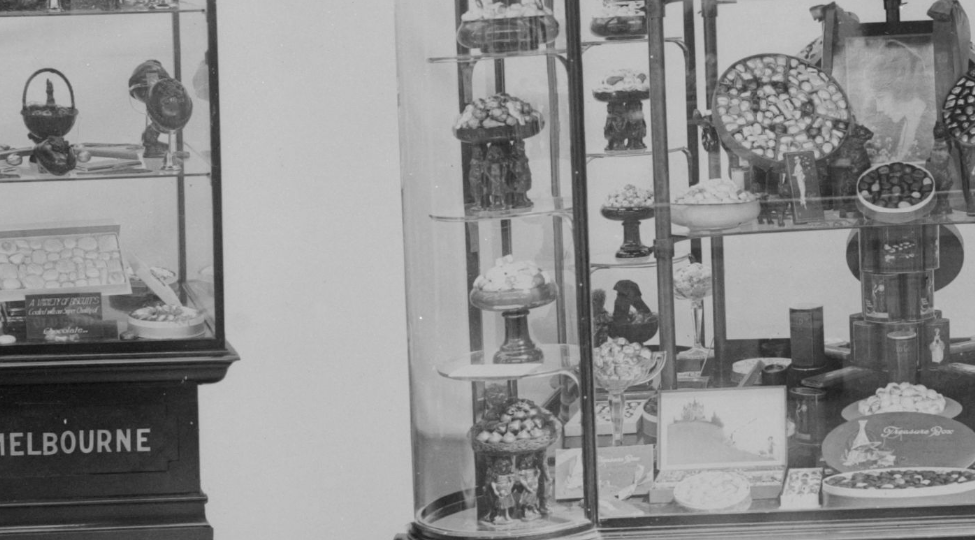
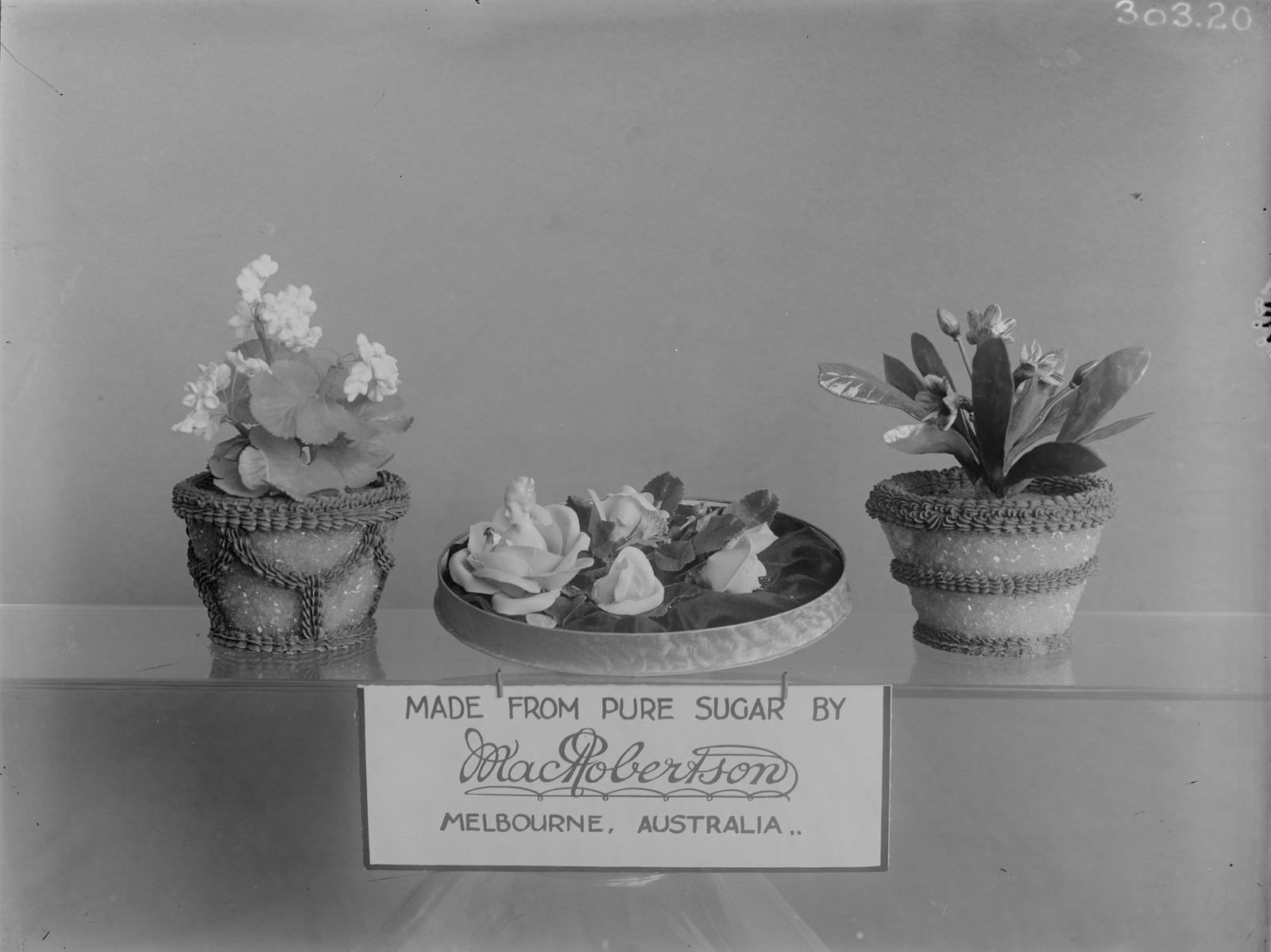
Dolly Varden is a character from Charles Dickens's 1839 historical novel Barnaby Rudge set in 1780. The Dolly Varden costume was an 1870s version of fashions of the 1770s and 1780s. The term "Dolly Varden" in dress is generally understood to mean a brightly patterned, usually flowered, dress with a polonaise overskirt gathered up and draped over a separate underskirt. The overdress is typically made from printed cotton or chintz, although it can be made from other materials such as lightweight wool, silk and muslin. An 1869 fashion doll in the collection of the V&A Museum of Childhood is dressed in the Dolly Varden mode; unusually the outfit is in dark colours. The Gallery of Costume in Manchester holds a more typical Dolly Varden dress in its collections, made of white linen with a pink and mauve flowered print.
A Dolly Varden hat, as it relates to the dress, is usually understood to mean a flat straw hat trimmed with flowers and ribbons, very like the 18th-century bergère hat. It is also closely related to the Pamela hat or "gipsy hat" that was popular during the earlier part of the century.
Although the typical Dolly Varden fashion of the large overskirt and polonaise died out with changes in fashion at the turn of the century, the names continued to be associated with chintz patterned fabrics and peplum style dresses. Even in the late 1930s, chintz patterned fashions might still have the name 'Dolly Varden' attached to them. - from Wikipedia
William P. Frith's famous painting of Dolly Varden, now in the Victoria and Albert Museum, was taken from the description given in chapter 19 of Barnaby Rudge:
"As to Dolly, there she was again, the very pink and pattern of good looks, in a smart little cherry-coloured mantle, with a hood of the same drawn over her head, and upon the top of that hood, a little straw hat trimmed with cherry-coloured ribbons, and worn the merest trifle on one side-just enough in short to make it the wickedest and most provoking head-dress that ever malicious milliner devised."
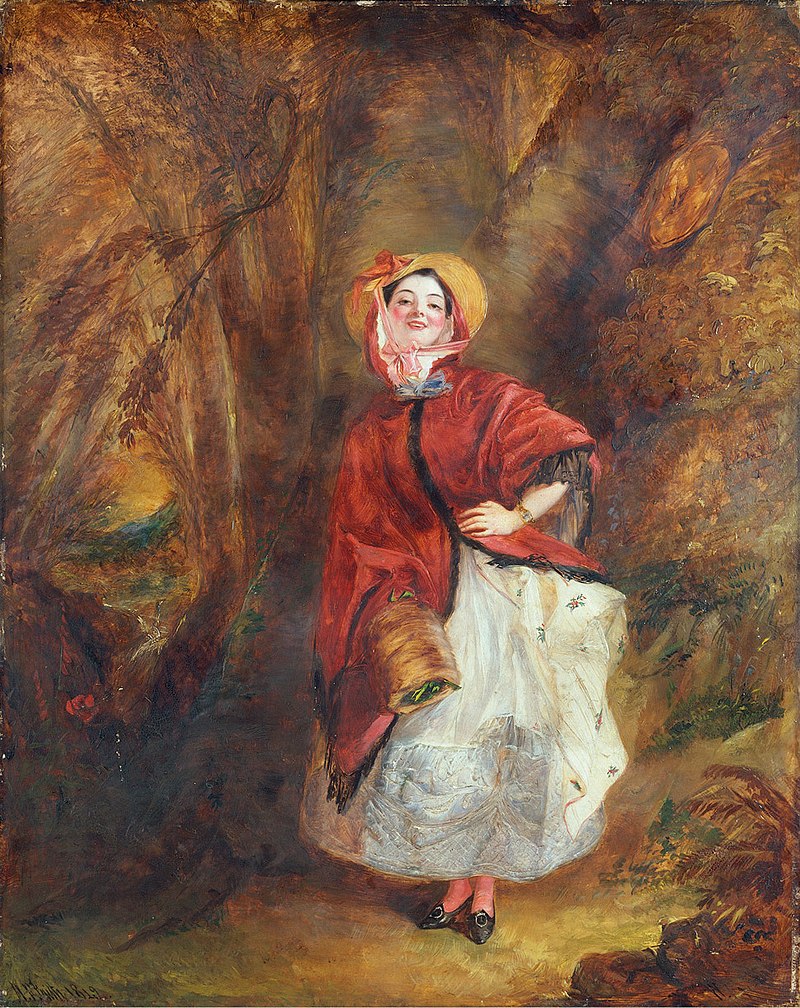
Dolly Varden, 1842. Dolly Varden is a character from Barnaby Rudge by Charles Dickens. William Powell Frith - Victoria & Albert Museum collections
She looks a lot alike Mr. Robertsons' daughter Stella, doesn't she?
George Bryan "Beau" Brummell (July 7, 1778 – March 30 1840) was an iconic figure in Regency England and for many years the arbiter of men's fashion. At one time he was a close friend of the Prince Regent, the future King George IV, but after the two quarrelled, and Brummell got into debt, he had to take refuge in France.
In 1926 he bought a controlling interest in Life Savers (Australasia) Ltd, and transferred its factory from Sydney, to save on wages:
SWEET DEAL
Mr MacRobertson to Control "Life Savers"
Mr. MacRobertson, the chocolate manufacturer, has purchased for the sum of £68,000 cash the controlling Interest in the Life Saver Company, manufacturing the well-known sweet-meat of that name. This is an important departure, and will immediately link up "life-savers" with the MacRobertson organisation. Originally "life-savers" were manufactured In Sydney, but owing to the 44-hour week being in vogue in the confectionery trade in New South Wales, it was decided to transfer the Life Savers' factory to Melbourne, and it will adjoin the establishment at Fitzroy, where the 48-hour week is in operation. SWEET DEAL (1926, January 14). The Herald (Melbourne, Vic. : 1861 - 1954), p. 7. Retrieved from http://nla.gov.au/nla.news-article243900104
When three English firms combined as Cadbury-Fry-Pascall to manufacture in Tasmania from 1926, MacRobertson expanded his product range and redoubled his promotions.
At the Royal Sydney Show
THE HOUSE OF MACROBERTSON, the largest confectioners in Australia, staged a magnificent exhibit of Max Mints,- which was easily the attraction in the big Industrial Pavilion. Max Mints, although only in the market a month or two, is already a wonderfully popular line. It is a delicious chewey mint— 'the mint that you will choose.'
Naturally the exhibit attracted great interest from young and old, and thousands of sample bags were disposed of, MacRobertsons manufacture a larger variety of confectionery than any other sweet house in the world, as most of the largest firms specialise on perhaps a dozen different lines. MacRobertsons, on the other hand, manufacture everything in confectionery, including, of course, the famous Old Gold Chocolates — renowned for their quality— - and which sell well on the English market This is rather unique, fur the confectionery world. The present staff of MacRobertsons is 3000, which include 2000 operatives. This is excluding many subsidiary industries owned or controlled by MacRobertson. They include the Maize Products Co., the Federal Milk Co. Timber Products ' Co., also a carton factory and wax paper factory— these and other kindred businesses all claim direct connection with the huge, self-contained organisation or MacRobertson. The house, therefore, largely controls the raw products which it. manufactures into quality confectionery and chocolates, and engineers, plumbers, tinsmiths, carpenters, moulders.
chemists, architects, saw-millers, box-makers, printers and others all do their share towards the smooth working of this remarkable organisation. Many of the- exclusive machines used by the firm are produced in their own engineering shops, being specially desigined to suit particular requirements and reduce, handling to a minimum. 'Old Gold'' chocolate -productions, therefore, represent the highest attainment, in the art of chocolate-making, and the firm' claims that no choicer confections are procurable anywhere the world over, it may be interesting to state MacRobertsons, which to-day covers 20 acres of factories, controls many subsidiary concerns, and has an annual wage bill of over £400,000, has been built up entirely by Mr. MacRobertson, who still controls tins huge undertaking without the assistance of outside capital. Forty-two years ago he improvised a boiler out of a nail can and produced his first sugar syrups for making sugar dolls, sugar mice and similar novelties. Mr. MacRobertson who is highly respected throughout Australia, is famed for his philanthropy, and for some years past has distributed large sums of money amongst various hospitals and other institutions at Christmas time. For some years past the 'Sydney Morning Herald' has acted as distributors for the N.S.W. portion of Mr.' MacRobertson's bounty. A remarkable fact is since starting in business over 40 years ago he has never had a strike in his factories.
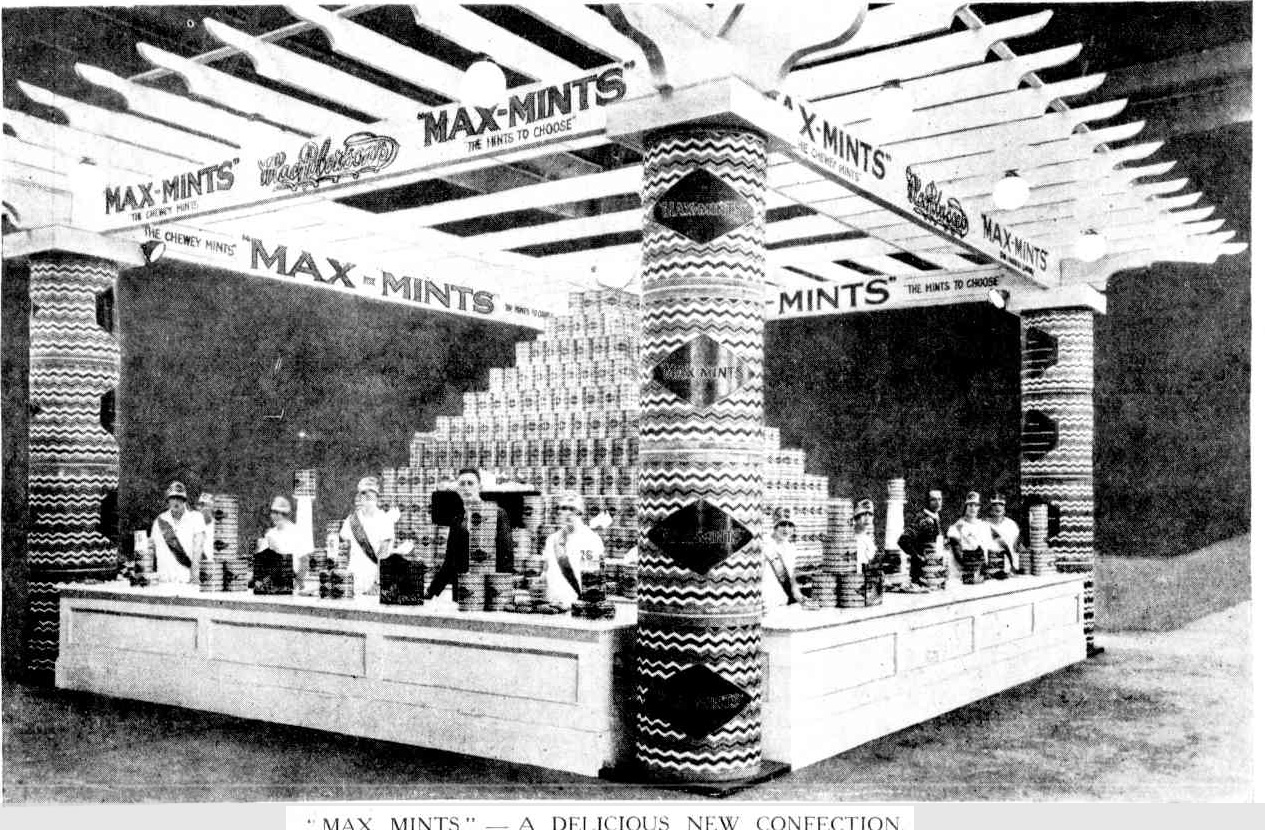
‘MAX MINTS' — A DELICIOUS NEW CONFECTION. At the Royal Sydney Show (1927, April 27). Sydney Mail (NSW : 1912 - 1938), p. 25. Retrieved from http://nla.gov.au/nla.news-article169146762
He joined aviator 'Horrie' Miller in the MacRobertson-Miller Aviation Co., Adelaide, and financed the MacRobertson Round Australia motor truck expedition in 1928.

Advertisement from July 29th, 1937 - South Australian newspapers.
ESTABLISHMENT, OPERATION AND MAINTENANCE OF AIR SERVICES BETWEEN PERTH AND DARWIN AND WYNDHAM AND DALY WATERS.
HIS Excellency, the Governor-General in Council, has approved that Agreements be entered into between the Commonwealth of Australia and MacRobertson-Miller Aviation Co. Ltd., 37 Angas-street, Adelaide, for the establishment, operation and maintenance of aeroplane services between Perth and Darwin and Wyndham and Daly Waters.
J. V. FAIRBAIRN
Minister of State for Civil Aviation. ESTABLISHMENT, OPERATION AND MAINTENANCE OF AIR SERVICES BETWEEN PERTH AND DARWIN AND WYNDHAM AND DALY WATERS. (1940, August 8). Commonwealth of Australia Gazette (National : 1901 - 1973), p. 1693. Retrieved from http://nla.gov.au/nla.news-article232692976
Mr. Robertson became renowned for his generosity; by 1933 he estimated that he had given away some £360,000 and he just kept giving. He made substantial gifts to the British, Australian and New Zealand Antarctic expeditions (1929, 1930). To honour his contribution Sir Douglas Mawson named MacRobertson Land in Antarctica in his honour, a 291 000 square kilometre square place of beauty. Mr. Robertson was elected a fellow of the Royal Geographical Society, London, in 1931 and was knighted in 1932 in recognition of his support for this exploration.
ANTARCTIC EXPEDITION.
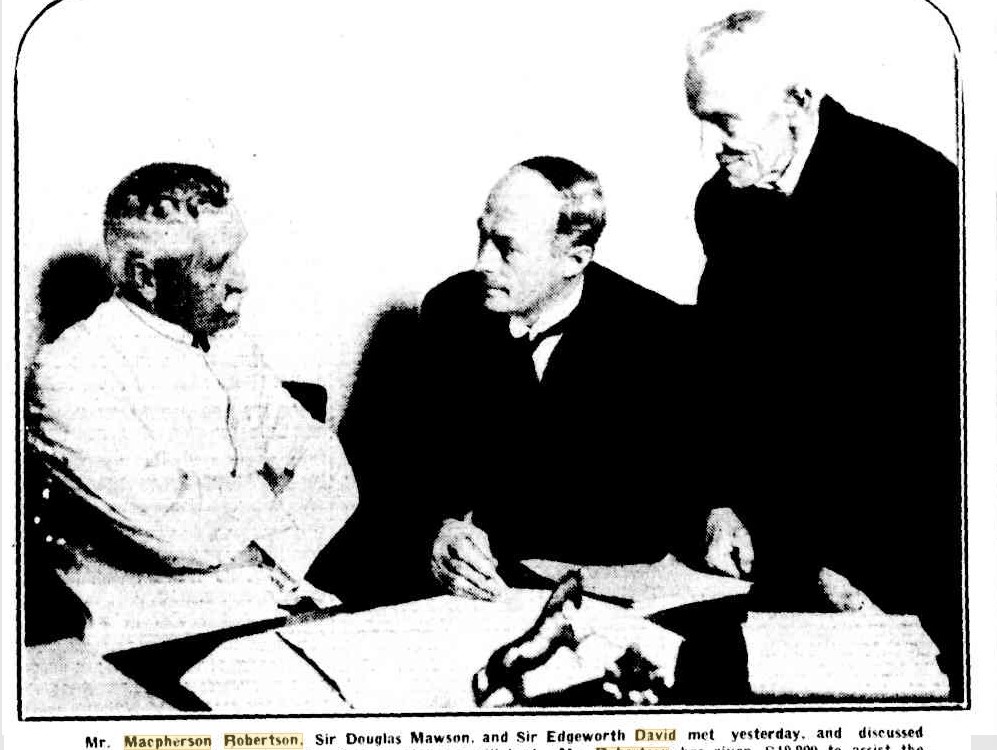
Mr. Macpherson Robertson, Sir Douglas Mawson, and Sir Edgeworth David met yesterday, and discussed the Antarctic Expedition which Sir Douglas Mawson will lead. Mr. Robertson has given £10,000 to assist the expedition. ANTARCTIC EXPEDITION. (1929, July 9). The Argus (Melbourne, Vic. : 1848 - 1957), p. 5. Retrieved from http://nla.gov.au/nla.news-article4020120
ANTARCTIC EXPEDITION COMMITTEE
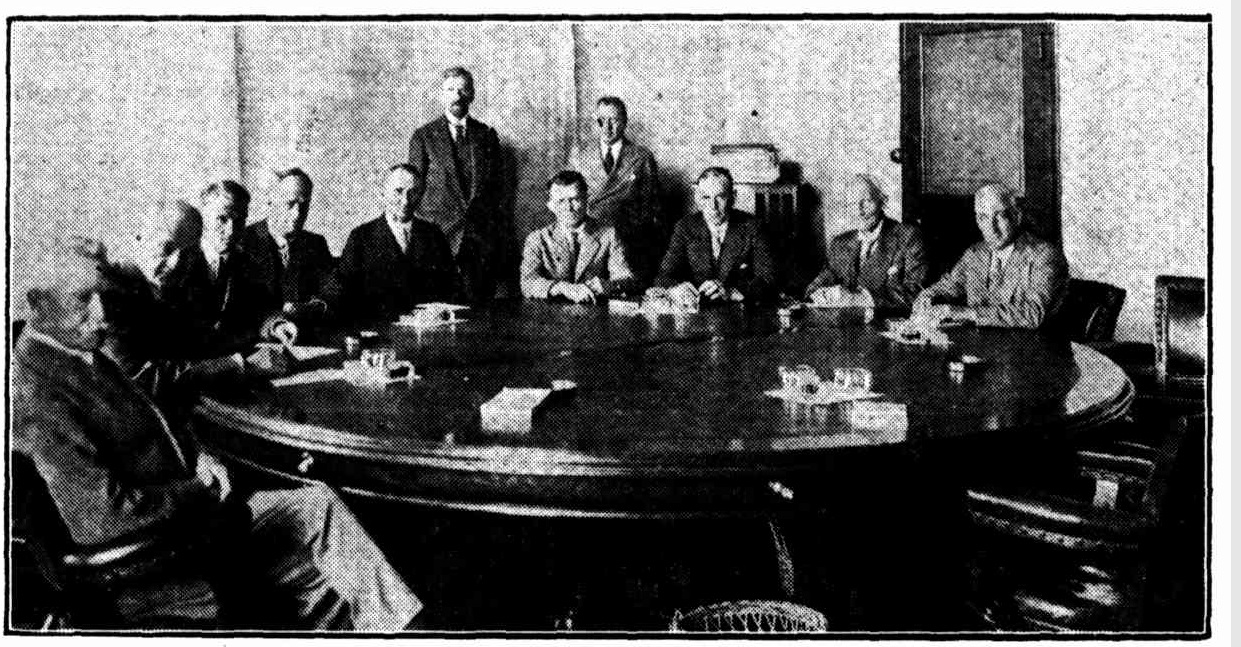
An important meeting of the Antarctic Expedition Committee was held in Melbourne on Monday to discuss the organisation of the next expedition. From the left (seated at table) — Mr. MacPherson Robertson, Sir David Orme Masson, Or. K. Henderson, Sir Douglas Mawson, the Vice-President of the Federal Executive Council (Senator Daly), Mr. E. W. Tonkin (secretary to Senator Daly), the First Member of the Naval Board (Rear- Admiral Kerr), Sir Edgeworth David, and Mr. J. H. Shechan. (Standing)— Captain J. K. Davis and Captain Stephenson. ANTARCTIC EXPEDITION COMMITTEE (1930, May 8). Chronicle (Adelaide, SA : 1895 - 1954), p. 55. Retrieved from http://nla.gov.au/nla.news-article90060442
MR. MAC ROBERTSON.
HONOURED IN LONDON.
Aid to Science Recognised.
In recognition of his generous gifts to aid research in the Antarctic, Mr Macpherson Robertson, of Melbourne, has been elected a fellow of the Royal Geographical Society, London. The fellowship was awarded on the recommendation of Sir Douglas Mawson, the commander of the two Australian expeditions to the Antarctic which Mr Mac Robertson has assisted, and of Sir Edgeworth David.
Mr. Mac Robertson has shown on many occasions a practical interest in scientific research, and when the Commonwealth Government organised the first Australian Antarctic Expedition in 1929 he contributed £10,000 toward the expenses. The generous gift did much to ensure that the most perfect technical equipment should be placed at Sir Douglas Mawson's disposal. When the expedition returned to Australia Sir Douglas Mawson announced that it was desirable that further research work should be carried out in an area to which Australia had long laid claim-a segment of Antarctica lying immediately south of Tasmania. Mr Mac Robertson immediately offered to guarantee up to £6,000 toward the cost of the work. The offer was gratefully accepted by the Commonwealth, and the expedition left Australia in October. Messages received from Sir Douglas Mawson's ship Discovery have indicated satisfactory progress in the work. MR. MAC ROBERTSON. (1931, January 7). The Argus (Melbourne, Vic. : 1848 - 1957), p. 10. Retrieved December from http://nla.gov.au/nla.news-article4244599
During the Victorian centenary celebrations he provided the £15,000 prize money for a London to Melbourne air race (1934) and £100,000 for public works to create employment during the depression and provide much-needed facilities. Family members indicate in some records that the federal government wished to claim almost 50% of this amount as tax and he paid that on top of the £100,000 so all the funds could be directed towards works for those going hungry - an honouring of what he had dealt with as a youngster, and never forgotten.
After controversy, which Macpherson Robertson found distressing, the money was spent on MacRobertson Girls' High School, a herbarium in the Botanic Gardens, a bridge over the Yarra and a fountain.
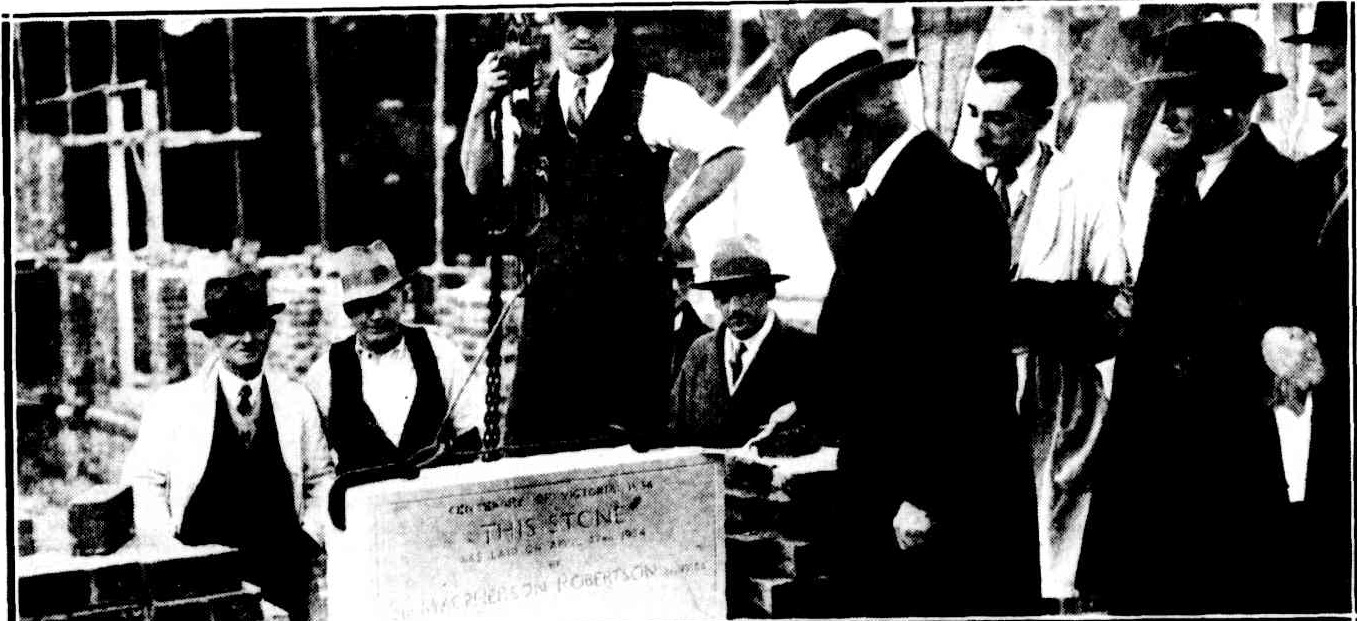
SIR MACPHERSON ROBERTSON laying the foundation-stone, yesterday afternoon, of the National Herbarium in the Domain. He has presented the Herbarium to the people of Victoria as a Centenary gift. The building and equipment will cost £15,000. SIR MACPHERSON ROBERTSON (1934, April 28). The Argus (Melbourne, Vic. : 1848 - 1957), p. 23. Retrieved from http://nla.gov.au/nla.news-article10931597
In 1935 he was appointed K.B.E.
An able sportsman in his youth, Robertson was a non-smoker and very moderate drinker. He worked out daily in his gym, and in his sixties could still jump a 4 ft 8 ins (142 cm) bar. He cut a dapper, upright and serious figure, with silver hair and clear complexion. He lived unpretentiously and his tastes were simple: croquet, films and boxing at the Melbourne Stadium (sometimes in company with John Wren) were abiding interests.
his two favourite pastimes being training horses and hockey. Last year he carted off the Melbourne hockey championship. CHOCOLATE MAKING (1920, July 10). The Mail (Adelaide, SA : 1912 - 1954), p. 3. Retrieved from http://nla.gov.au/nla.news-article63882771
Punching Ball Expert
MacRobertson Excels at the Art
By W. S. SHAHLAND
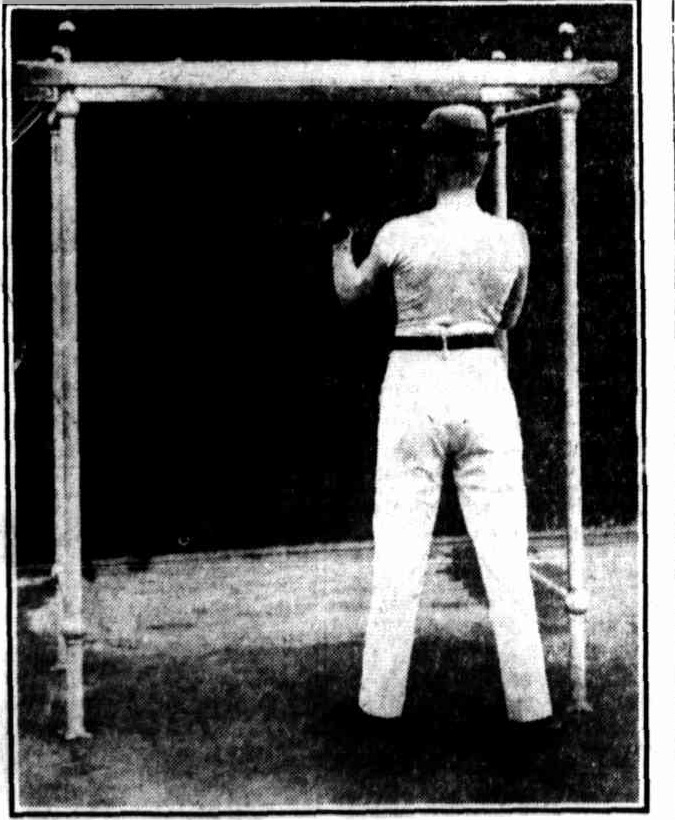
Mr ROBERTSON, Confectionery Magnate, Punching the Ball.
The punching ball should be the requisite of every athlete who takes his training seriously. Unfortunately very few athletes avail themselves of the excellent results which ca n lie obtained from practice with the ball. Not only does punching the ball Improve a man wonderfully in physique, but It makes him think quicker in everyday life. One of the greatest exponents of the punching ball In Victoria is Mr. .Macpherson Robertson, the great confectionery manufacturer of Fitzroy; and, despite his age of 62 years, it is fairly safe to state that few men can punch the ball with such rapidity and for such a period as he. Mr Robertson, as everyone knows, has made a wonderful business, but despite his close attention to his work he has had plenty of time for sport, and he will you Hint constant exercise has been responsible for keeping' him in … of condition. He is passionately fond of punching the ball, and he had the necessary equipment installed in his home to enable him to practice daily. …He also played shinty and hockey.; In the latter sport he was a great player and supporter of the Fairfield club, who held the premlerahip for many years. At football he a fine player and earned renown for being a great centre man. He played with the South Carlton team and Zingaria.Mr ROBERTSON, Confectionery Magnate, Punching the Ball. Punching Ball Expert (1924, July 19). Sporting Globe (Melbourne, Vic. : 1922 - 1954), p. 8. Retrieved from http://nla.gov.au/nla.news-article185067674
Records indicate he rarely holidayed, although there are photographs of him on a Victorian beach with a rug and family members around. He was an ardent motorist from 1902 and owned a fleet of Packard cars:
PIONEER MOTORIST
Mr. MacRobertson's Reminisce AMAZED AT PROGRESS
Mr. MacRobertson, founder and proprietor of MacRobertson's confectionery works in Victoria, who arrived in Adelaide this week, was a keen motorist nearly a quarter of a century ago. He tells of his early experiences with the motor.
"Away back in 1902," he said, "there were few motor cars in this country and the first one I drove was a little 5 h.p. Rochet car of French make. This was a single cylinder car with dry cell ignition, air-cooled, with engine on back axle. It started with a strip which was wound round a pulley on an extension of the crankshaft. When the strap was wound round this pulley you obtained a certain amount of leverage by placing the foot against the back axle, and then made a vigorous pull on the strap to start the car. If by any chance a backfire occurred you were shot forward against the front of the car. I have pulled this strap at periods, in a vain endeavor to start the car, with more vigor than a mule, and pushed it nearly as many miles as I have driven it.
WONDERFUL PROGRESS
"My first venture in an American car was a 5 h.p. Oldsmobile, with tiller steerer, dry cell ignition, air-cooled engine, started with a handle. The trips I used to take in that Oldsmobile when I compare the cars of the past with those of today, amaze me. Many a trip I have taken from which I have returned in freight trains, hay drays, milk carts, and sundry other vehicles, leaving the old car by the wayside and returning for it next day. "Modern motorists have but a faint idea of what it was to drive a car in those days. One's patience and resourcefulness were tested to the extreme. Today, with fool proof, high-powered cars, with definite ignition, electric lighting, powerful brakes, and high-class durable tyres, it is different.
TWENTY-EIGHT PUNCTURES 'On one occasion venturing from Melbourne to Bacchus Marsh I had 28 punctures. I tried to patch every one of them. Tyres and solution were not so good in those days. The Oldsmobile got a good deal of bumping on the hard road through deflating of tyres. At last in desperation I discarded the spent and perforated tubes. Then I cut some long dry grass and stuffed the covers and wound them on the wheels with wire and reached home in the early hours of next day.
SPIRIT OF ENTHUSIASM
"On another occasion through faulty tyres I stuffed the covers with cut up chaffbags, bought from a farmer by the wayside and returned. "Time is a great healer," Mr. MacRobertson concluded, ''and I often sit in that old car and reflect on the incidents of the past with a certain amount of pleasure in the fact that it indicated to me that I had some spirit of enthusiasm, adventure and energy — obstacles to surmount as it were - and perhaps that is the vim of life."
Mr. MacRobertson, who has not visited Adelaide for 25 years, now owns ten Packard cars which are kept for family use. Of the 84 horses he used to employ for transportation purposes there are only 24 left. They are, all being replaced, he said, by motor lorries. PIONEER MOTORIST (1925, April 18). The Mail (Adelaide, SA : 1912 - 1954), p. 29. Retrieved from http://nla.gov.au/nla.news-article59713100
MR. MAC. ROBERTSON AND HIS PRIVATE FLEET OF PACKARDS.
AN ARDENT MOTORIST'S TRIBUTE TO AN ELEGANT CAR.

Mr. Mac. Robertson in his Straight Eight Single-Seater Packard—an aristocratic runabout—the smartest car in the city—which was driven up Collins-st. hill, between Swanston and Russell sts. at 1 mile per hour on top gear.
A car for every occasion is included in Mr. Mac. Robertson's Garage—and they are all Packards:—(Left to Right): Straight Eight Runabout, Twin-Six Runabout, Single-Six 5-passenger Tourer. Single Six Runabout, Single Six Runabout, SingleSix Sedan, Twin-Six Californian Top Tourer, Single-Six 7-Passenger Tourer. MR. MAC. ROBERTSON AND HIS PRIVATE FLEET OF PACKARDS. (1924, May 1). Table Talk (Melbourne, Vic. : 1885 - 1939), p. 11. Retrieved from http://nla.gov.au/nla.news-article146459202
His first wife Elizabeth Alice (nee Edington) passed away in 1932.
ROBERTSON.-On the 13th April at "Launceston" St. Kilda-road. Melbourne, Elizabeth Alice, beloved mother of Ernest (deceased), and Stella Irene, and wife of Macpherson Robertson.
ROBERTSON.—The Friends of the late Mrs. ELIZABETH ALICE ROBERTSON are informed that her remains will be interred in the Melbourne General Cemetery, Carlton. The funeral will leave her residence, "Launceston," 603 St. Kilda-road, Melbourne, TO-MORROW (Saturday), the 16th inst., at 2 p.m. W. G. APPS and SONS PTY. LTD. J1145 (2 lines). Family Notices (1932, April 15). The Age (Melbourne, Vic. : 1854 - 1954), p. 1. Retrieved from http://nla.gov.au/nla.news-article205087809
£68,000 ESTATE
Mrs Robertson's Will
The will of Elizabeth Alice Robertson, late of St. Kilda Road, Melbourne, who died on April 13, was lodged for probate today. .She left real estate £6102 and personal property £61,832. By her will, dated June 17, 1931. she bequeathed her property to her widower, Sir Macpherson Robertson, her children relatives and friends. She appointed her husband a trustee of her estate. £68,000 ESTATE (1932, July 23). The Herald (Melbourne, Vic. : 1861 - 1954), p. 1. Retrieved from http://nla.gov.au/nla.news-article242980606
On August 27th 1932 at Scots Church, Melbourne, he married Elizabeth Siebert, his long term mistress with whom had had a son, Norman (1909 - 1993), daughter, Eunice (died when 2 months old), and another son, Eric (1918 - 1981). Also called 'Lizzie', his second wife predeceased him in 1944.
MacRobertsons, alike every Australian producer, was part of the war effort in supplying the needs of those sent in to defend our shores. The 1942 campaign in New Guinea had been a steep learning curve for the Australian Military Forces (AMF) in terms of feeding troops on the front line. They needed to be sustained so they could stay healthy and they also needed to be able to transport their food as individuals. The terrain the New Guinea defence was fought over and the normal loads carried by soldiers required a solution.The problem of providing rations that were palatable, relatively easy to disburse, and easy to carry and use by soldiers who could not be provided with proper cooked meals created an intense research and development process in Australia from early 1942.
One of the results of this was the AMF 1943 Emergency Ration. This was the result of a three-way project between the AMF, the Council for Scientific and Industrial Research (CSIR – the forerunner of the CSIRO) and MacRobertson's. MacRobertson's in fact received the original contract for production and supply of the ration, with some items sub-contracted out. After extensive operational trials in Northern Australia in 1942 and early 1943, the Emergency ration began to be issued to troops in New Guinea from about May 1943 and also featured in MacRobertsons advertisements;
14.276 Req. F.3109.—Emergency rations, for Department of the Army, £125,000.—MacRobertson Pty. Ltd. DEPARTMENT OF SUPPLY AND SHIPPING. (1943, August 12). Commonwealth of Australia Gazette (National : 1901 - 1973), p. 1699. Retrieved from http://nla.gov.au/nla.news-article232758369
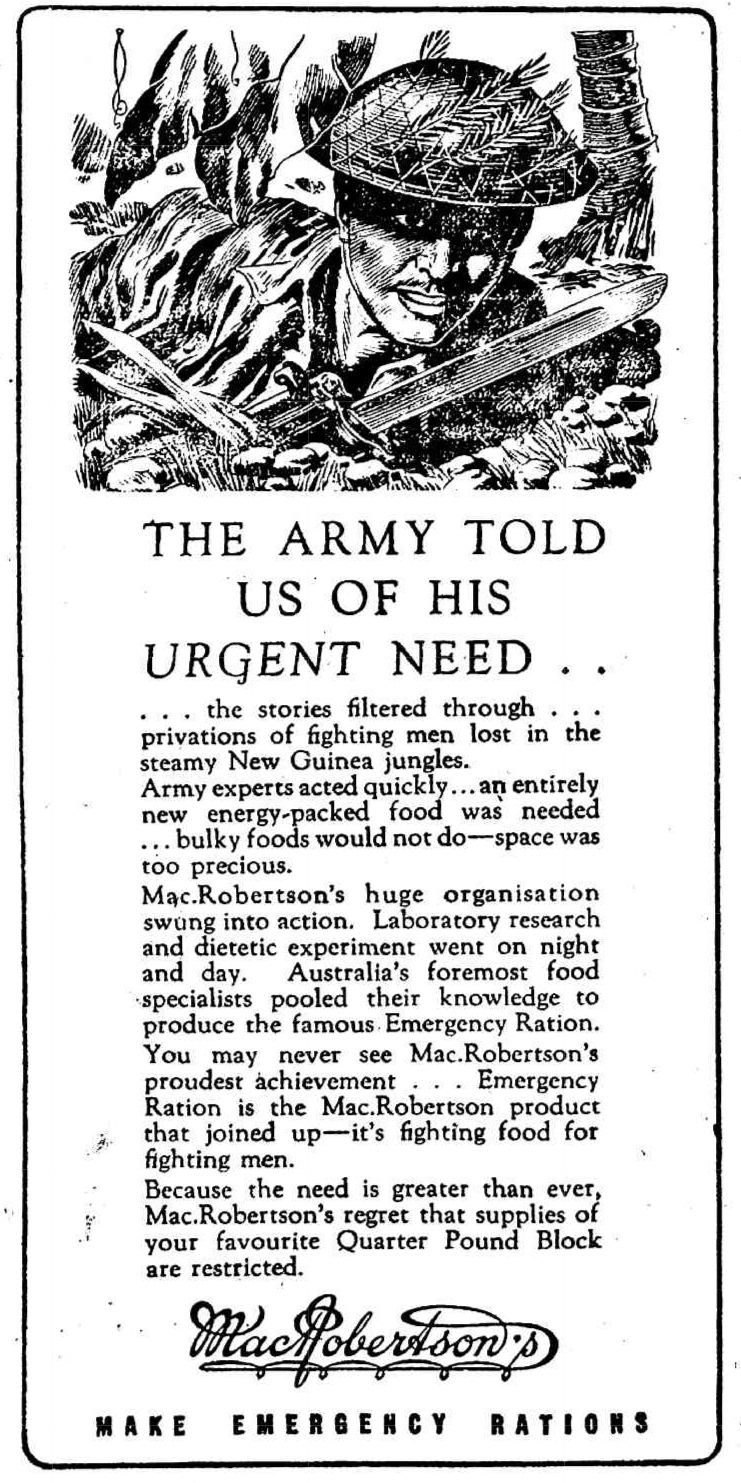
Advertising (1943, November 16). Shepparton Advertiser (Vic. : 1914 - 1953), p. 5. Retrieved from http://nla.gov.au/nla.news-article175186340
This is another example of an AMF 1943 Emergency Ration:
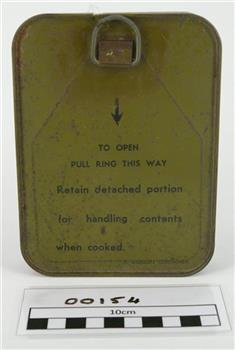
Description: An unopened olive drab Emergency Ration Tin. There are instructions printed in black ink on the inside surface of the lid. This should read 'INSTRUCTIONS FOR USE / To be consumed as found. / 1. HOT CHOCOLATE (if preferred) / Break up chocolate block and dissolve in hot water. / 2. TEA TABLETS: / Use one per pannikin, adding boiling water and sugar if required. / 3. SALT TABLETS : / To reduce fatigue and cure muscle cramp, take either in water or as desired. Normally stamped in the inside of an opened ration tin would be date, such as '10-44' indicating that it was produced in October 1944. FROM THE COLLECTION OF the Frankston RSL Sub Branch183 Cranbourne Road Frankston Victoria and image from Museums Victoria website. Note the rounded corners so it would rip pockets when being pulled out - although the jungle environment made cloth rot.
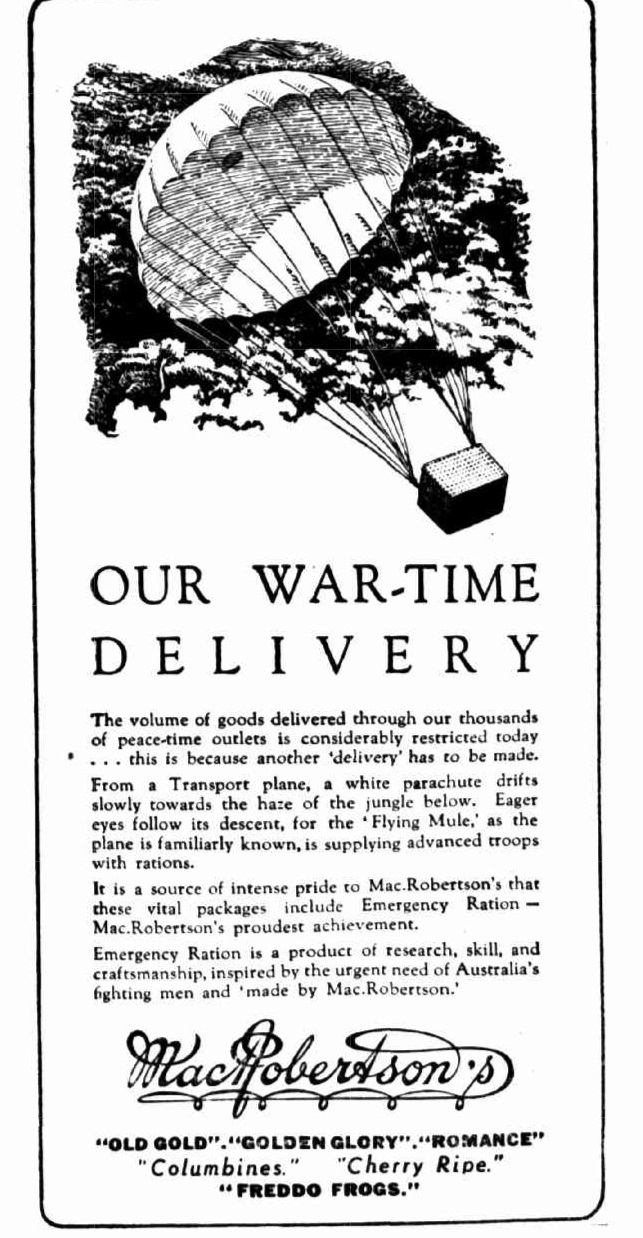
Advertising (1943, December 23). South Western Times (Bunbury, WA : 1932 - 1954), p. 6. Retrieved December 13, 2019, from http://nla.gov.au/nla.news-article252962497
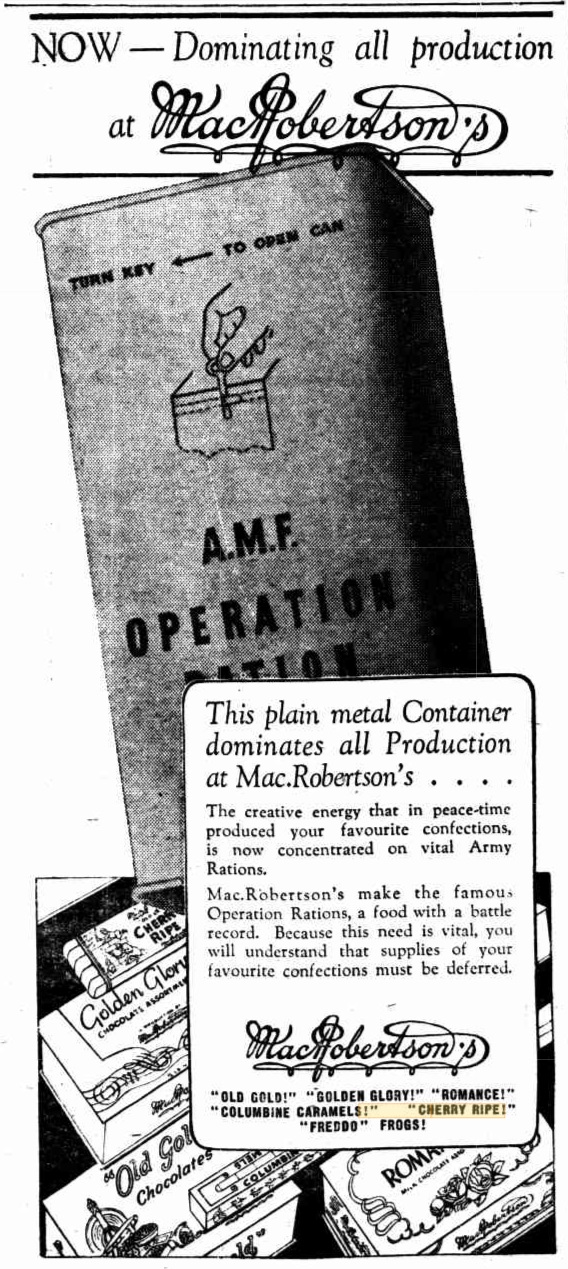
Dominating all production
This plain metal Container dominates all Production at Mac.Robertson's . ...
The creative energy that in peace-time produced your favourite confections, is now concentrated on vital Army
Rations.
Mac.Robertson's make the famous Operation Rations, a food with a battle record. Because this need is vital, you will understand that supplies - of your favourite confections must be deferred
"OLD GOLD!" "GOLDEN GLORY!" "ROMANCE!' "COLUMBINE CARAMELS!" "CHERRY RIPE!
"FREDDO" FROGS! Family Notices (1944, February 12). Border Watch (Mount Gambier, SA : 1861 - 1954), p. 4. Retrieved from http://nla.gov.au/nla.news-article78160449
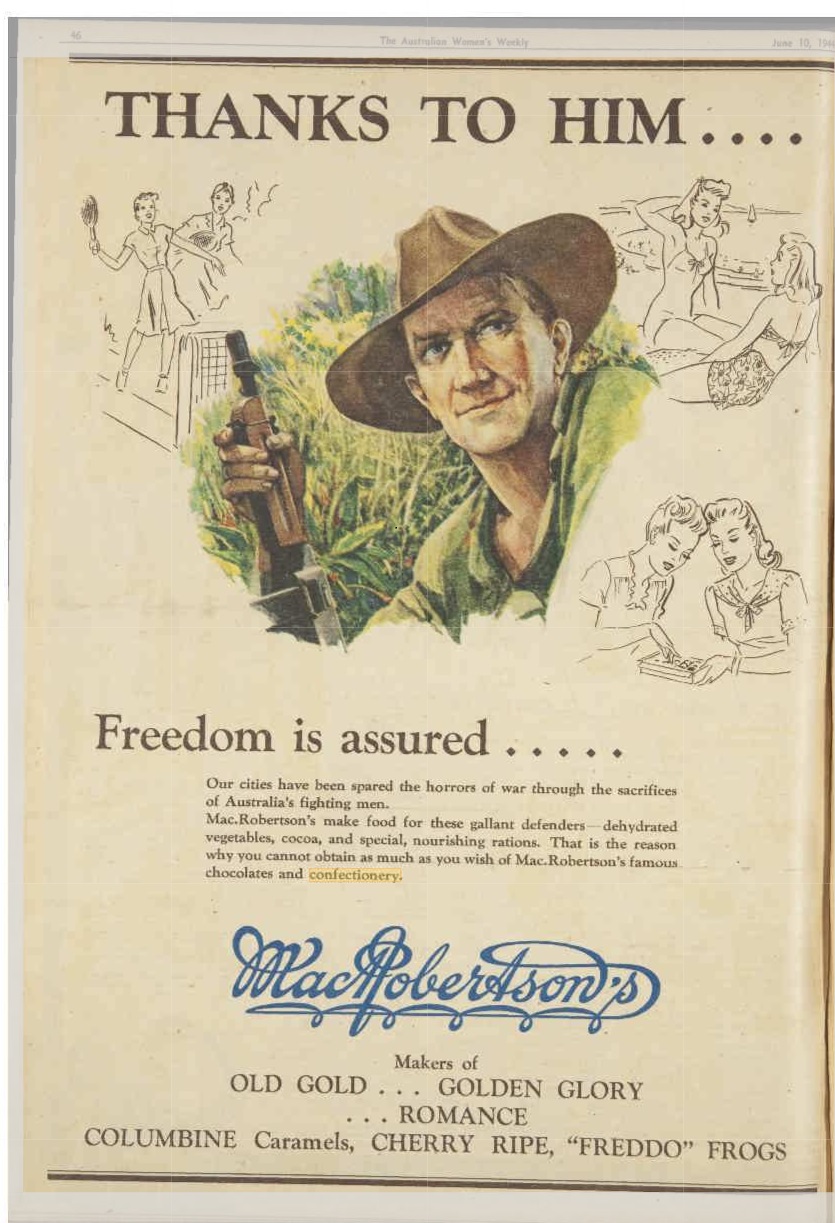
THANKS TO HIM
Freedom is assured.
Our cities have been spared the horrors of war through the sacrifices of Australia's fighting men.
Mac. Robertson's make food for these gallant defenders – dehydrated vegetables, cocoa, and special, nourishing rations. That is the reason why you cannot obtain as much as you wish of Mac. Robertson's famous chocolates and confectionery.
Makers of OLD GOLD . . . GOLDEN GLORY . . . ROMANCE COLUMBINE Caramels, CHERRY RIPE, "FREDDO" FROGS. Advertising (1944, June 10). The Australian Women's Weekly (1933 - 1982), p. 46. Retrieved from http://nla.gov.au/nla.news-article47216811
Rations weren't the only item being supplied by MacRobertsons - records show dehydrated onions being supplied, Kuna rations, and whatever else they could do, alike many other businesses that regeared their factories and fields to meet what what was needed, they did:
Contracts Accepted.
Req. F.3697.—"Kuna" rations, £612 10s.—MacRobertson Pty. Ltd. DEPARTMENT OF COMMERCE AND AGRICULTURE. (1943, October 14). Commonwealth of Australia Gazette (National : 1901 - 1973), p. 2275. Retrieved from http://nla.gov.au/nla.news-article232759405
Req. F.5360/A.124.—Dehydrated onions, £22,203 2s. 6d.— MacRobertsons Pty. Ltd.
Req. F.5361-4.—Dehydrated onions— £2,366.—Gordon Edgell & Sons Ltd.
£1,584 7s. 6d.—MacRobertsons Pty. Ltd.
£1,056 5s.—MacRobertsons Pty. Ltd.
£528 2s. 6d.—MacRobertsons Pty. Ltd. DEPARTMENT OF COMMERCE AND AGRICULTURE. (1944, March 30). Commonwealth of Australia Gazette (National : 1901 - 1973), p. 746. Retrieved from http://nla.gov.au/nla.news-article232777882
As can be seen above, Macpherson Robertson gave and gave and gave to Australia during times of need or when explorations needed to be funded. His support of sport clubs, of new business ventures, willingly sharing these with producers of similar products was all focussed on Australian Made self sufficiency and researching and developing the machines and individuals to do it better.
Another instance of his giving:
LARGE CHEQUES
TO HELP
CANCER RESEARCH
Sir Mac Pherson Robertson, £500
Cheques for £500 from Sir Macpherson Robertson, and £100 each from Captain Eric Robertson, Mr Norman Robertson, and MacRobertson Pty Ltd, together with other contributions, yesterday increased the total amount subscribed in response to the appeal for £5,000 by the Melbourne Cancer Causation Research Committee to £3,944/18/8. The amount received through THE ARGUS is now £3,028/16/8, the remainder having been received by the committee.
In an accompanying letter Mr Norman Robertson said that he had pleasure in enclosing cheques for £700 from Sir Macpherson Robert-son, Captain Eric Robertson, and himself as a contribution to the appeal for funds to assist Dr Thomas Cherry in his investigations. They sincerely hoped that Dr Cherry would be able to make valuable progress in his humanitarian work.
The cheque for £100 from MacRobertson Pty Ltd, Argyle st, Fitzroy, was accompanied by a letter from Mr Leonard Cole, secretary, wishing the appeal every success.
On behalf of the executive of the Melbourne Cancer Causation Research Committee, Mr G. W. Bruce, honorary secretary, yesterday sent a letter to Mr Norman Robertson thanking Sir Macpherson Robertson, Captain Eric Robertson, and himself for their most liberal gifts and their good wishes for the success of Dr Cherry in his research work. They believed, Mr Bruce said, that Dr Cherry had already contributed a great deal of knowledge of value to the community, and that the community would yet be still more indebted to him. Further progress in his work had been made possible by generous gifts such as were now acknowledged.
In a letter to Mr Cole, Mr Bruce said that, without any thought of re-ward, except what good he could do for humanity, Dr Cherry had continued his work for many years with very little material support. The executive had been greatly encouraged by the liberal response to the appeal.
Cheques for £10/10/ each were received also from Michaelis, Hallenstein, and Co Pty Ltd and Mr and Mrs W. E. Flanagan.
THE ARGUS, which will acknowledge donations, has received the following: Previously acknowledged, £ 2,194 0/8. Sir Macpherson Robertson, £500; Eric F. Robertson, Norman Robertson, and MacRobertson Pty Ltd, each £100; Michaelis, Hallen-stein, and Co Pty Ltd and Mr and Mrs W. E. Flanagan, each £10/10/; Mrs A. M. Clarke, £5/5/; A.H.P. and J.P.H., each £3; H.Y.D., £1/1/; K.M., £1; A. and F.J.C., 10/. Total, £3,028/16/8. LARGE CHEQUES TO HELP CANCER RESEARCH (1944, August 16). The Argus (Melbourne, Vic. : 1848 - 1957), p. 4. Retrieved from http://nla.gov.au/nla.news-article11356801
Macpherson Robertson passed away at his Kew home on August 20th, 1945, and was cremated after an Anglican service. His estate, which was sworn for probate at £584,266 and consisted almost entirely of government bonds and shares in his business, was left to his descendants.
During his almost a century of living he had seen Australia change from a place of colonists to those who were proudly Australian, came out on a ship himself and supported and encouraged aviation. You didn't see him in the 'Society' pages, you saw him at work or on a playing field somewhere, excelling at sport.
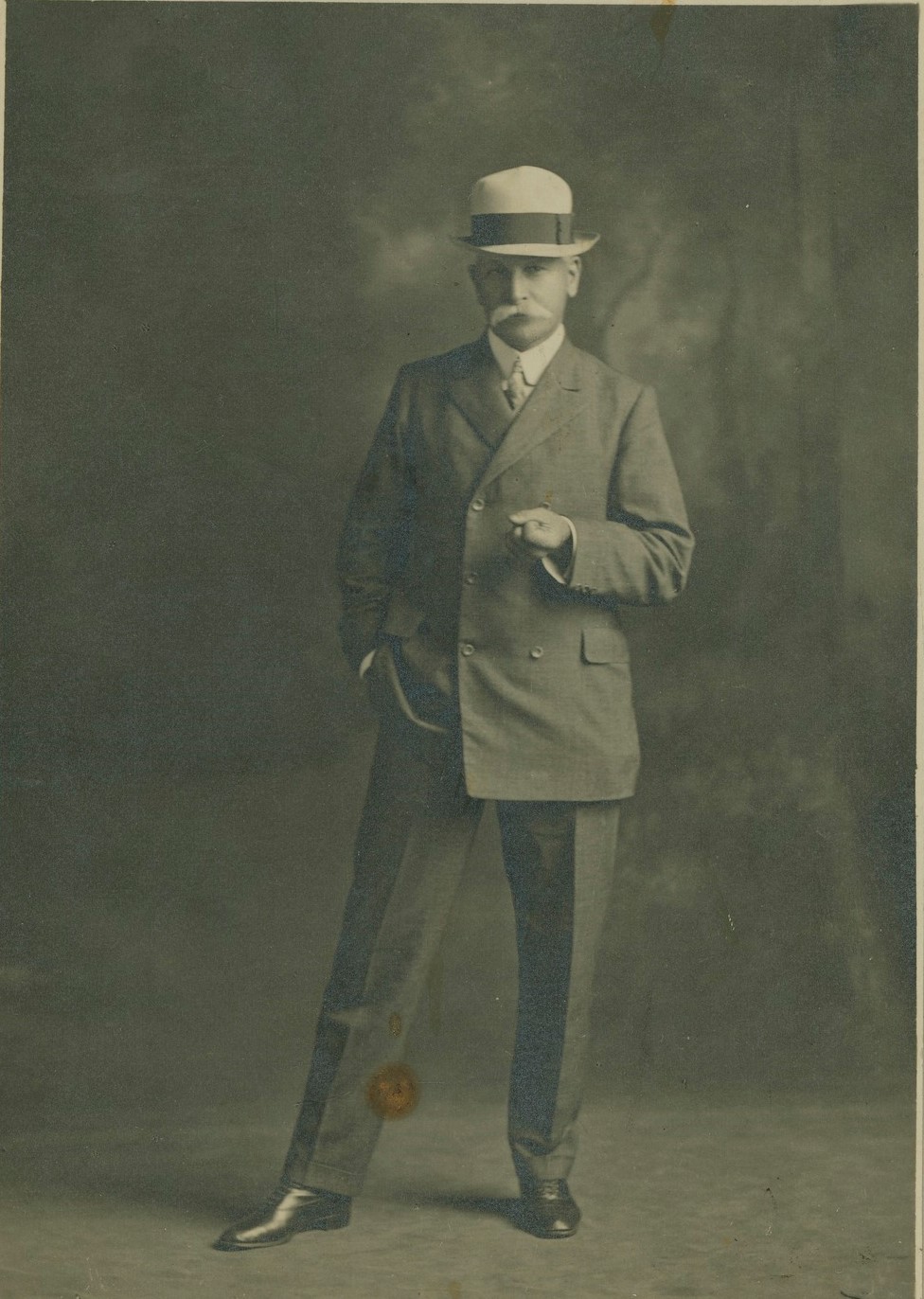
Macpherson Robertson, circa 1924 - courtesy State library of Victoria, Item: FL15689977
Sir Macpherson Robertson Dead
MELBOURNE, Monday. — Sir Macpherson Robertson, pioneer of the sweets industry, sponsor of the Melbourne Centenary air race, and benefactor to many public institutions, died to-day at his home at Kew, aged 86.
Starting life as a barber's boy, he sold papers, was a butcher's boy, and then started manufacturing sweets. From that he rose to millionaire. He was well known for his munificent gifts, his largest being £100 000 during Melbourne's Centenary Of that sum £16,000 was for the Centenary air race, £40,000 for the Girls' High School, and £21,000 for the Grange Road Bridge. His gifts to Melbourne University amounted to more than £50,000. For many years he gave a Christmas present of £10,000, to be divided among charities of the Commonwealth. He also donated £10,000 for Sir Douglas Mawson's 1929 Antarctic expedition, which named MacRobertson Land after him. For that he was knighted in June, 1933. He is survived by two sons. Sir Macpherson Robertson Dead (1945, August 21). The Courier-Mail (Brisbane, Qld. : 1933 - 1954), p. 3. Retrieved from http://nla.gov.au/nla.news-article50283616
'Candy King' Left Estate Of £584,265
MELBOURNE, Wednesday. — The late Sir Macpherson Robertson, governing director of MacRobertson's Pty., Ltd., confectionery manufacturers, left personal estate sworn for probate at £584,265 — no realty. Robertson, who was known as Australia's 'Candy King,' died on August 30, 1945. His personal estate consists mainly of Government stocks and shares in MacRobertsons Pty., Ltd.
The management of MacRobertsons Ptu.,Ltd. is by the will left in the hands of Norman and Eric Robertson, Mervyn and Geoffrey Brewer, Barry White, and Leslie Gordon Atkinson, who are appointed to a board of management with powers powers of directors from and after the grant and issue of probate. Norman Robertson, the general manager, is. to be chairman of the board during his life. Since the death of Sir Macpherson Robertson. Mervyn Brewer has resigned from the board to devote himself to other interests. During his life Sir Macpherson Robertson gave generously to charities, his annual Christmas treat for many years being not less than £10,000. 'Candy King' Left Estate Of £584,265 (1946, May 9). The Courier-Mail (Brisbane, Qld. : 1933 - 1954), p. 3. Retrieved from http://nla.gov.au/nla.news-article50257504
His first son Ernest, and daughter Stella (1890-1942), from Macpherson Robertson's first marriage and who had worked in the business as well, predeceased him. His sons Norman Napoleon and Eric Francis and grandsons Mervyn Macpherson Brewer and Geoffrey Robertson Brewer, Stella's sons, were closely involved in the business. Their first year without their guiding founder showed up in a few instances:
SYMBOL of UNCHANGING QUALITY
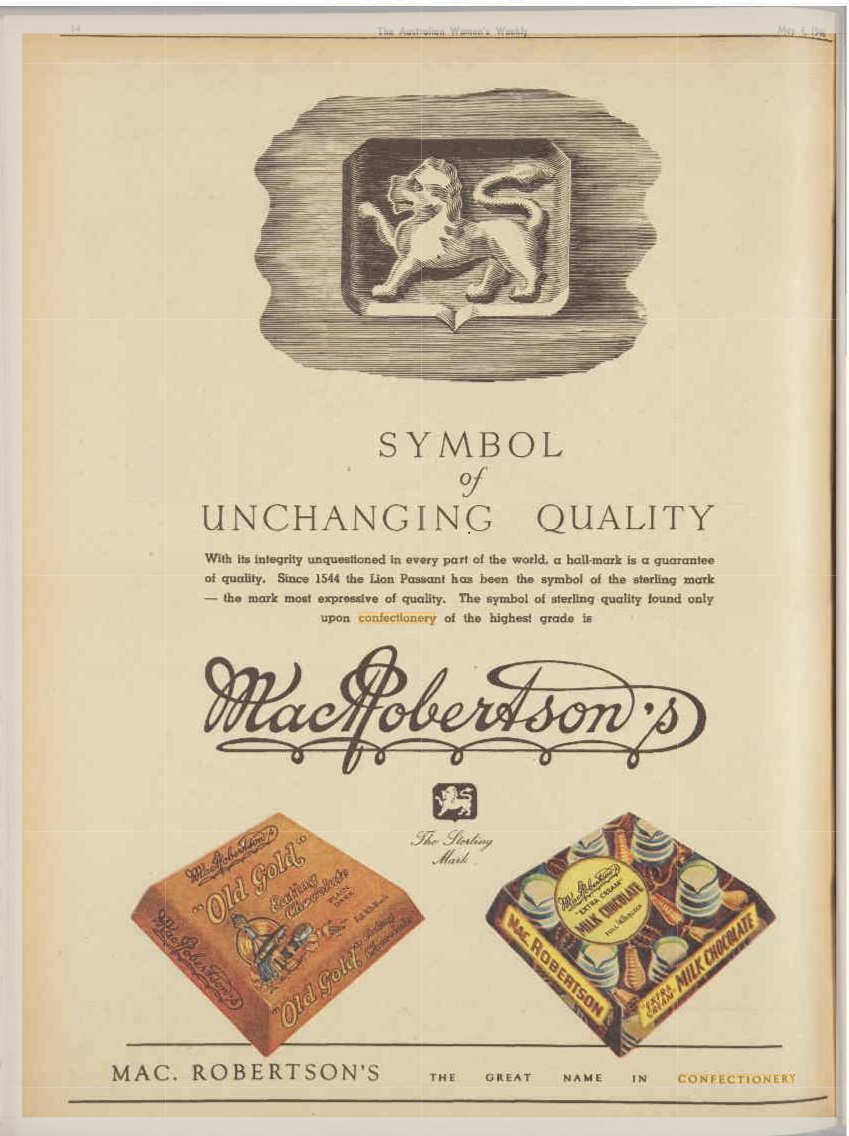
With its integrity unquestioned in every part of the world, a hall-mark is a guarantee of quality. Since 1544 the Lion Passant has been the symbol of the sterling mark - the mark most expressive of quality. The symbol of sterling quality found only upon confectionery of the highest grade is MAC. ROBERTSON'S THE GREAT NAME IN CONFECTIONERY Advertising (1946, May 4). The Australian Women's Weekly (1933 - 1982), p. 14. Retrieved from http://nla.gov.au/nla.news-article47504282
Crown used as symbol of quality in same year:
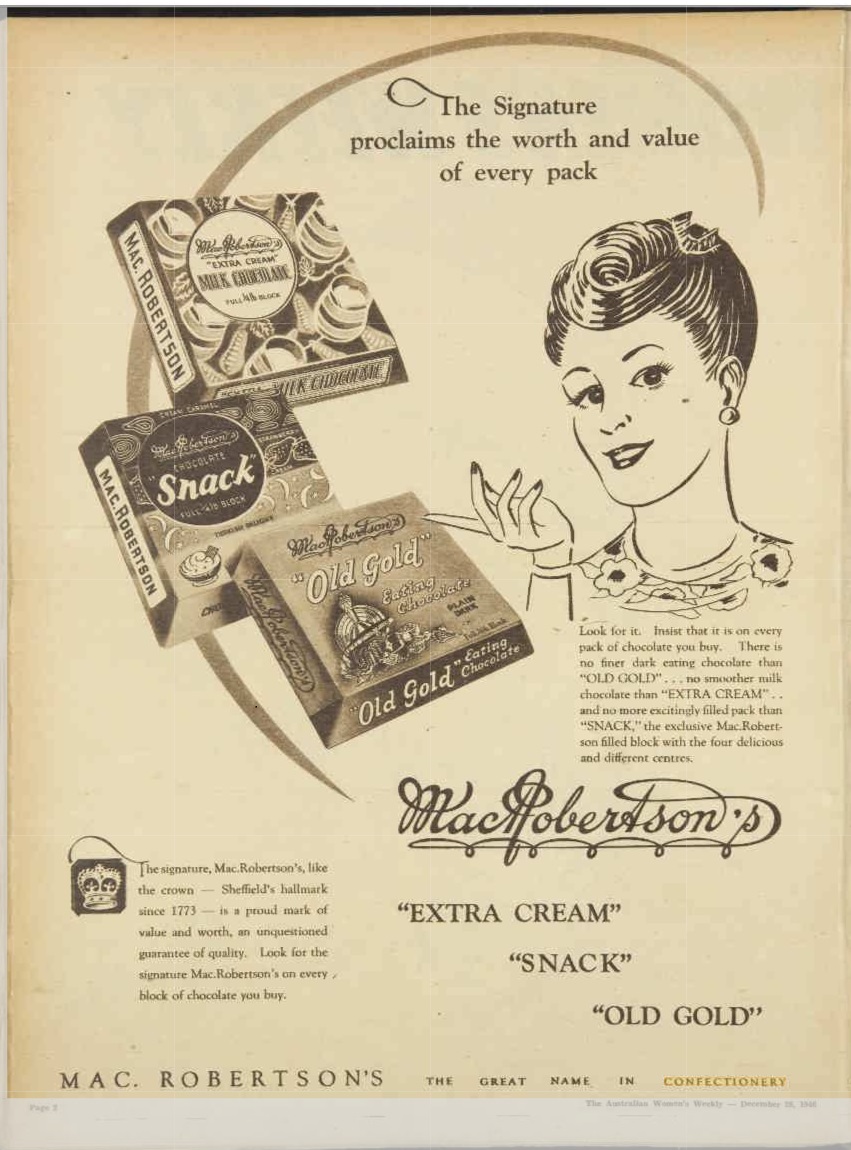
Advertising (1946, December 28). The Australian Women's Weekly (1933 - 1982), p. 2. Retrieved from http://nla.gov.au/nla.news-article47504907
COLUMBINES —the richest caramels of all!

Like your caramels to be extra rich and creamy? With that true caramel flavour you can't mistake? Then ask for "Columbines"—made by Mac. Robertson. Each "Columbine" is a delicious, energizing and wholesome sweet, rich in glucose, and every piece is wrapped for your protection. Made with milk, creamy butter and pure cane sugar, they give you and your family caramel at its best. Made by MacRobertson - The Great Name in Confectionery. Advertising (1951, May 12). The Australian Women's Weekly (1933 - 1982), p. 20. Retrieved from http://nla.gov.au/nla.news-article58151671
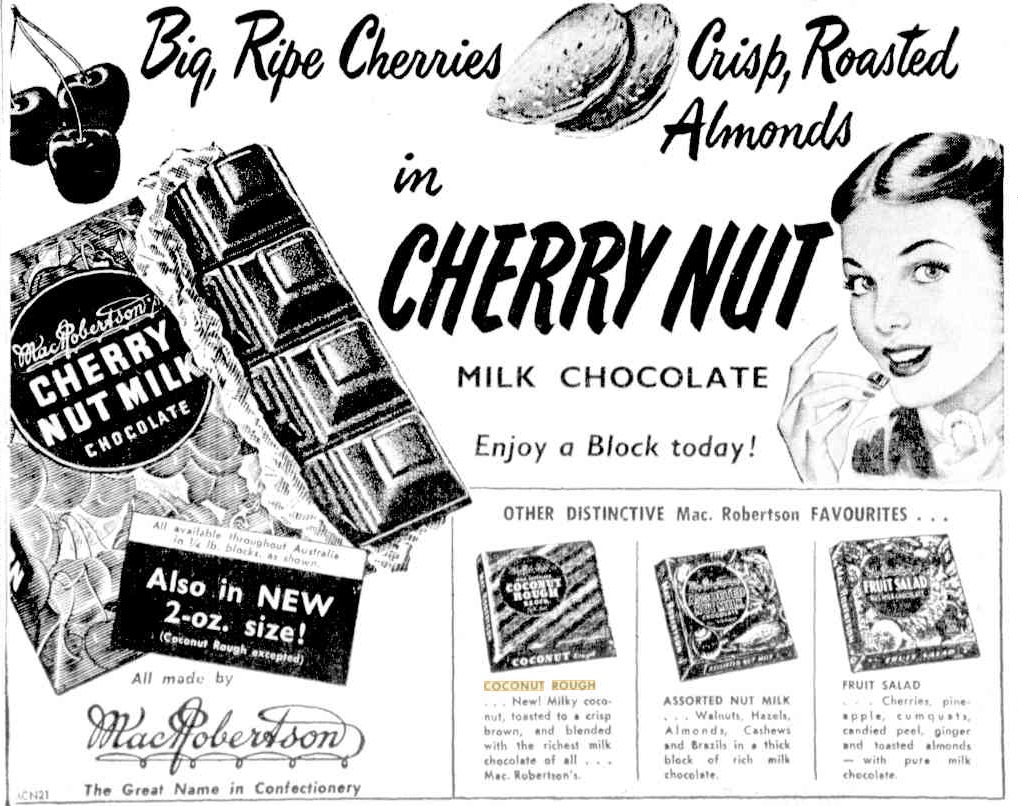
Advertising (1952, June 8). Sunday Times (Perth, WA : 1902 - 1954), p. 13 (COUNTRY EDITION : Sporting Section). Retrieved from http://nla.gov.au/nla.news-article59546407
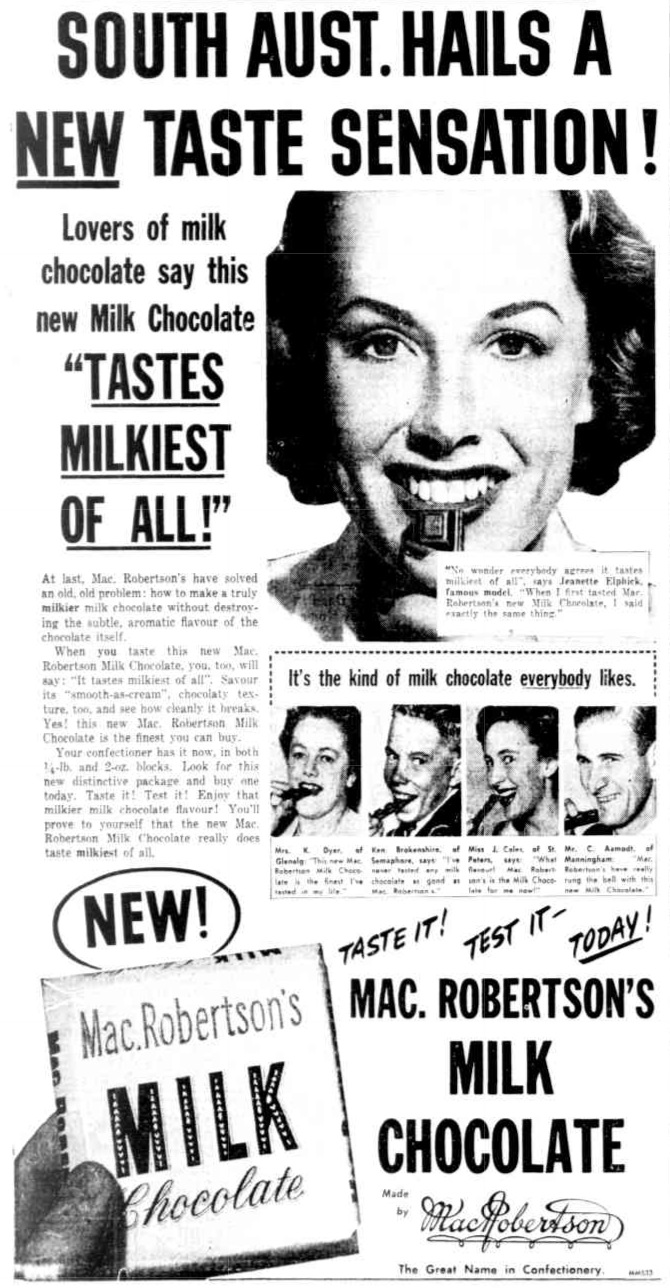
From May 20th, 1953
In 1967 MacRobertsons became part of Cadbury-Schweppes, keeping that name on the Cherry Ripe products until 2002. The MacRobertson Scorched Peanut Bar was made by Nestles for a while, can remember these, like the Cherry Ripe being a favourite at home and in showbags, and then ceased production for almost 40 years until relaunched a few weeks ago by Wollongong based Cooks Confectionery. They have launched a dedicated Facebook page to the popular chocolate bar, in its original packaging, which offers you a chance to win and eat one of these beauties every day for a year - a different kind of 2020 New Years resolution which you may not want to share with mum or your dentist, although it's still all natural.

A few MacRobertson family notes:
BREWER - ROBERTSON. - On the 5th March, at Scots Church, Collins street, by the Rev. Dr. Marshall, Herbert William, eldest son of Mr. and Mrs. W. J. Brewer, of Park crescent, Fairfield, to Stella Irene, only daughter of Mr. and Mrs. Macpherson Robertson, of Station street, Fairfield. Present address, "Leith", Station street, Fairfield. Family Notices (1913, April 12). The Argus (Melbourne, Vic. : 1848 - 1957), p. 13. Retrieved from http://nla.gov.au/nla.news-article10777329
BREWER—ROBERTSON WEDDING.
Miss Robertson's marriage with Mr. Herbert William Brewer was celebrated at Scots' Church on 5th March by the Rev. Dr. Marshall, and afterwards at "Carmalea."

THE BRIDE (MISS S. I. ROBERTSON) AND HER PARENTS (MR. AND MRS. MACPHERSON ROBERTSON). Photos by Allan Studios. Taken in the drawing-room at "Carmalea" just before leaving for the church. MISS STELLA IRENE ROBERTSON.
.jpg?timestamp=1576248153872)
BRIDAL GROUP OF THE MARRIAGE OF MR. HERBERT WILLIAM BREWER AND MISS STELLA IRENE ROBERTSON. Standing.—Miss E. Gamble, Mr. A. Brewer, Mr. E. Brewer, the Bride, Mr. L. Schutt, Mr. S. Brewer, Mr. A. Clark, Miss H. Barnard. Second Row (Sitting).—Miss R. Atkinson, Miss P. Atkinson, Bridegroom, Miss C. Jack, Miss D. Child. In Front.—Miss Ida Kennedy and Miss Nancy Brewer.
A NOTABLE WEDDING.
MR. H. W. BREWER TO MISS S. I. ROBERTSON, A very artistic wedding was celebrated at Scots' Church, Melbourne, by the Rev. Dr. Marshall, on Wednesday, 5th March, between Mr. Herbert William Brewer, eldest son of Mr. and Mrs. W. J. Brewer, of Park-crescent, Fairfield, ,and Miss Stella Irene Robertson, only daughter of Mr. and Mrs. Macpherson Robertson, of "Carmalea," Fairfield. The approaches to the church were crowded with hundreds of spectators anxious to catch a glimpse of the bride. More than usual interest was attached to this wedding in that the bride's father is known as one of Melbourne's most successful business men, and a citizen who numbers amongst his friends many of the best-known of Melbourne's residents.
The bride, who arrived in her mother's handsome limousine car, has a very graceful presence, is very beautiful, and is much beloved by a large circle of friends. The church was very beautifully decorated with flowers and palms. Across the altar was festooned with heliotrope and white blooms, in which were set the initials of the bride and bridegroom. The bridal procession was a most picturesque one. The sweet-faced bride entered with her father, and had one little train-bearer. Miss F. Atkinson, and two maids of honour, Miss Ida Kennedy and Miss Nancy Brewer, who walked one on each side; then followed the five bridesmaids. The bridal frock was of rich ivory satin charmeuse, with a train of some six yards, that hung from the shoulders in long, classical lines. It was lined with shell-pink satin and fine lace ruching. The trimming was of pearl embroidery, set in one long spray with a pretty bow of lace, and clusters of valley lilies on the other corner. A pearl-run tunic of satin was effectively draped over an underdress of silk and pearl outlined applique. The crossover bodice and sleeves were of the same beautiful applique. finished with an Empire waist of the satin. The neck had a soft, square outline finish of shadow net, in which was set a diamond spray (the gift of the bridegroom). A coronet wreath of orange blossom was worn under a long, beautifully-embroidered veil of fine tulle. Her bouquet was of white gardenias and lilitt; and choice ferns, set with bows of tulle.
The maids of honour and the dainty train-bearer were all dressed in white crepe de chene, trimmed with Malines lace. The bodices had soft fichus of the lace, and their hair had bows of white ribbon. The maids oi honour carried baskets of flowers and autumn foliage. The bridesmaids were Miss E. Gamble, Miss H. Barnard, Miss R. Atkinson, Miss F. Atkinson, Miss C. Jack, and Miss D. Child. They were all most artistically dressed in pastel shades of mauve and green. Deep folds of the green finished the skirts. The tunics were prettily bordered with goffered silk. Large Gainsborough hats were worn, lined with pale green satin, set with beautiful La France roses. They carried crooks of La France roses and autumn leaves.
The bridegroom's presents to the bridesmaids were handsome gold bracelets. The bride's mother was beautifully gowned in a trained dress of silver grey satin charmeuse, with a princess tunic of crepe meteor, with a deep flounce finish of grey embroidered tulle, hand run with exquisite bead embroidery. The .bodice and •sleeves were of the same richly embroidered fabric. A large grey satin hat was worn, swept with pleurise plumes in soft grey tones. A bouquet of red cactus dahlias gave an artistic note of colour to this beautiful costume. The bridegroom's mother was prettily dressed in pearl grey crepe de chene, draped with rich lace, that was caught to one side in pannier fashion. The fichu-trimmed bodice was finished with velvet in a deeper tone and oxidised embroidery. The bridegroom was supported by Mr. Louis Schutt as best man, and Mr. Eric Brewer, Mr. Stanley Brewer, Mr. A. Brewer, and Mr. Archie Clark.
After the ceremony the guests, who numbered over two hundred, motored out to "Carmalea," Fairfield, the residence of the bride's parents. A reception was held in the drawing-room, which had been prettily decorated with pale pink roses. Wedding tea was laid in a large marquee erected on one of the lawns at "Carmalea." The tables were very artistically decorated in pale mauve and pink blooms, and the bridal table was done in pink and white.
The toasts were honoured as follows :—'The toast of "The King" was proposed by the host, "The Bride and Bridegroom" by the Rev. C. Walklate, to which the bridegroom responded. Mr. Louis Schutt spoke for the bridesmaids, and the Rev. C. J. T. Martin replied. "The Bride's Parents" Mr. N. Kentish proposed, and Mr. Mac-Robertson responded. The health.. of the bridegroom's parents was left in the hands of Mr. L. Schutt, "senior, and the bridegroom's father replied.
Signor Di Gilio's band played most enjoyable and appropriate music during the reception and the wedding tea. The members of the Collingwood Pipers' Band marched all the way out to Fairfield to serenade the bride. Stationary and moving pictures were taken of the bridal party during the afternoon, and a dance was given in the evening. The well-kept grounds at "Carmalea" were much used for promenade. The tennis courts, croquet lawn and bowling green were all in gay attire with flags. In the gardens the plants were all in full and luxuriant bloom. The lake in the centre of the grounds was gaily festooned in coloured drapings and flowers. The light from a number of miniature lanterns that crossed the surface of the water and the costumes of the guests as they passed and re-passed formed a brilliant and most picturesque enclosure. Small tri-coloured tents and gaily striped umbrellas placed on the lawns helped to further enhance the bewildering scene. A stately rose bush, some hundred and twenty feet in "circumference, that stood in the main garden came in for much notice. So also did the handsome, nine-roomed, up-to-date villa on the south-west side of the garden built for the bride by her father.
The guests spent all the evening either dancing or walking in the beautiful grounds. The bride and bridegroom left early in the evening. The bride travelled in a costume of black velvet, with a small purple velvet hat, grouped with purple plumes. The presents were varied, and some oi very costly nature. The employees of Mac-Robertson made the bride a special gift of a handsome bracelet set in pearls and olivine stones, while the Fairfield Girls' Hockey Team presented her with a beautiful silver tea service. Other presents included : From Mr. S. Brewer, rosewood case of cutlery. Mr. 0. Brewer, clock set in ornament (Tempus), also pair of ornaments and bowl. Mr. and Mrs. F. Robertson, case of dessert knives and forks. Mr. F. H. Bailey, oil painting. Mr. and Mrs. H. Giambic, silver bread platter. Miss R. Merriman, rose bowl. Miss Crow, table brush and tray (bronze), jardiniere. Miss Cutler, jardiniere. Mr. W. Robertson, silver-mounted oak trav. Mr. and Mrs. J. F. Crow, beaten bronze urn. Mr. and Mrs. Thurgood, traycloth. Mrs. J. Mall, salad bowl. Mr. and Mrs. W. J. Arnold, jardiniere. Mr., Mrs. and Miss Hopper and Mr. J. Elliot, silver egg cruet. Mrs. Atherton, Mrs. Bromfitand Miss Athe^.on, copper coffee urn. Mr. R. O'Loughlin, tray cloth. Mr. D. Manger, brass jardiniere. Mr. and Mrs. J. D. Miller, silver vase. Mr. and Mrs. Allan (Sorrento), brass jardiniere. Mr. J. W. Le Masurier. copper jardiniere. Mr. and Mrs. J. A. Von Alwvn. silver fitted dressing case. Mr. and Mrs. H. Noel Kentish, silver epergne. Miss M. Hill, silver photograme. Mr. G. Kemter, pair silver sugar bowls. Mr. and Mrs. J. Bari-ie, silver jardiniere. Mr. and Mrs. L.. J. Walker, cut glass and silvermounted salad bowl. Mr. and Miss Hocking, case of silver dessert knives and forks. Miss Mitchdl and Mr. C. R. Bradish, silver tea service. Mr. and Mrs. Tilly, hand-painted vase. Mr. J. _Brunton, pair silver vases. Mr. J. Metters, spirit decanters. Mr. and Mrs. C. S. Stokes, silver cake stand. Mr. and Mrs. Dutton, silver cream and sugar stand. Mr. and Mrs. W. Atkinson, ease silver fisb knives and forks. Miss C. Jack, ornament. Mr. J. St. 0. Organ, silver jardiniere. Mr. and Mrs T. J. Brewer, silver hot water jug. Miss. W. Vallance, silver vase. Mrs. and Miss Child, ornament. Mr. and Miss Dunn, silver epergne. Mr. and Mrs. Rosman, case of silver afternoon teaspoons. Capt. and Mrs. Schutt and the Misses Schutt, silver egg cruet, butter dish and toast rack. Dr. F. Magnus Kiel, a bust ("Depose"). Messrs. E. Stinton and A: 4yerr, silver rose bowl. - Mr. and Mrs. C. Cole, case of silver nut crackers and pickers. Mr. and Mrs. H. T. Ransford, set of carvers. Mr. and Mrs. . E. Brewer, silver teapot. Miss L. Hollow, silv.er fish slide. Mrs. E. E. Junker, silver butter Sish..' ^embers of Fairfield Ladies' Hockey Club, silver tea service. Mr. and Miss Atkinson, silver jam dish. Mr. and Mrs. Horingan, set of carvers. Mr. and Mrs. F. Stacey, jardiniere. Dr. and Mrs. G. Home, silver epergne. Mr. W. Atkinson, silver hot water kettle. Mr. W. Manger, silver photo frame. Mr. and Mrs. A. Otto Schmidt, bronze clock. Mrs. G. C. Dixon, white satin cushion. Miss S. Guerrero, cushion. Miss Sanders, silver tray. Mr. and Mrs. R. M'Keon, jardiniere. Messrs. Schutze, Steffens and Co., ornament. Mr. and Mrs. W. D. Clay, pair jardinieres. Rev. and Mrs. C. J. F. Martin, picture. Mr. and Mrs. J. D. Wood, oil painting. Messrs. and Misses Donaldson, bronze ornament. Mr. and Mrs. C. Davis, silver and glass celery bowl. Mr. C. Steet, silver coffee service. Mr. and Mrs. Gieoffrey and the Misses Geoffrey, silver bread platter and junket dish. Mr. n. Hollow, copper jardiniere. Mr. and Mrs. H. Nathan, silver cake basket. Mr. and Mrs. G. Griffiths and family, silver nut bowl and pair crackers. Miss E. Gamble, silver cake stand. Messrs. C. and L. Griffith, silver jardiniere. Mr. O. and Miss E. Davoren, silver stand, with afternoon tea spoons and cake forks. Dr. and Mrs. Taylor Downie, silver epergne. Mr. and Mrs. G. Allen, cut glass silver-mounted, biscuit barrel. Miss H. Hollow and Mr. N. Trevens, glass and silver epergne. Mr. L. Christian, silver afternoon tea service. Mr. L. Schutt, silver hot water jug. Employees of MacRobertson, diamond and pearl bracelet. Mrs. W. J. Brewer, dining-room sideboard. Mr. W. J. Brewer, cheque. Mr. and. Mrs. H. T. Sebirt, silver egg cruet. Mrs. and the Misses Rogers, silver cream and sugar stand. Miss E. Heller, ornament. Mrs. R. Scott, silver sugar scuttle. Mr. D'. and Mrs. Theo. H. Bliss, bronze ornament. Mr. and Mrs. D. Robertson, silver asparagus dish and entree dishes. Mr. H. Curtis, silver afternoon tea and cake service. Miss S. 0 Brien, silver sugar scuttle. Mr. and Mrs. Blackburn, pair Japanese silver candlesticks. Mrs. T. H. Brewer, silver jam and butter dish. Mr. and Miss Garrick, silver dish cover. Dr. F. W. Kiel, copper jardiniere. Madame T. P. L'Hardy, silver epergne. Mr. and Mrs. F. W. Box, silver afternoon teaset. Mr. and Mrs. A. K. Inglis, silver jardiniere. Mr. W. L. Elvins, copper ornament. Mr. -and Mrs. J. M. Ramsay, silver muffin dish. Mr. and Mrs. H. J. Mackennal, rose bowl. Mr. and Mrs. A. Alexander, pair silver serviette rings. Miss H. Barnard, case of afternoon cake forks. Mr. A. Clarke, pair silver serviette rings. Mr. and Mrs.Thompson and Miss Thompson, easy chair. Misses Anderson, flower bowl. Miss A. Crow, ornament. Mr. J. V. Griffith, silver bread platter. Mr. C. Walklate, pair silver cut glass salt cellars. Mr. and Mrs. J. Anderson, silver gong. Mr. and Mrs. Mitchell, case of silver afternoon cake forks. Messrs. and Mrs. Kennedy, silver cake basket and pair silver vases. Mr. W. E. Lockyer, silver candlestick. Mr. A. N. Patton, pair of silver jam spoons. Mr. and Mrs. Bennett, silver nut bowl. Mr. R. C. Kempton, ornament. Mrs. Inglesman, dinner service. Mr. E. 0. Thomas (Adelaide), silver tea service. Mr. L. R. M'Donald. silver rose bowl. Mr. and Mrs. P. Joske, ornament. Mr. B. Allan, fancy box. Messrs. E. and L. Brewer, silver egg boiler. Employees of "Carmalea." silver egg cruet. Mr. H. Daus, silver rose bowl. Messrs. and Mrs. Sibthorpe, silver entree dish. Messrs. J. R. Elsbnry and E. Mitchell, silver sugar I basin. Mrs. and Miss Barnett, silver fruit stand. Mr. and Mrs. A. Paterson. pair silver vases Mrs. and Miss Home, silver cheese dish. Miss A. t. Fogarty, copper vase. Mr. and Mrs. Honeycombe, silver gong. Mr. and Mrs. : J. T. Wilkins. pair vases. Dr. Ernest and Mrs. Robertson silver rose bowl. Welch, Perrin and Co., silver and glass epergne. Miss N. Seyler. pair gold croquet hatpins. Mr. and Mrs. Lancashire, set of house brushes. Mr. and Mrs. F. Hopper, set of carvers. Messrs. and Mrs. Besley, set of brown ware. Mr. and Mrs. J. A. Roash, brass jardiniere. Miss Armstrong and Mr. N. Brooks, copper jardiniere. Miss J Forest, Indian silk handkerchief and fancy box and cushions, etc. Life-size portrait of Mr. Macpherson Robertson presented to the bride by the L G.L C. Mr. and Mrs. W. O. Coulson, handsome hand-chased perfume decanter. Father of bride, handsome rosewood afternoon tea trolly and set of beautiful teal ware, Wertheim sewing machine. Mrs. Gamble, silver ring stand. Messrs. Ball and Welch, choice lace table cover. Employees of W. J. Brewer, silver tea service. BREWER-ROBERTSON WEDDING. (1913, March 13). Punch (Melbourne, Vic. : 1900 - 1918; 1925), p. 30. Retrieved from http://nla.gov.au/nla.news-article176032684
WILLIAMSON. -On the 11th January (suddenly), Albert, loving husband of Stella Irene of Linlithgow-road, Toorak, beloved only son of Mrs. H. A. Williamson and the late William John Williamson, late of Fitzroy, aged 42 years. Present Address: 201 Dandenong-road, Windsor. Family Notices (1932, January 12). The Age (Melbourne, Vic. : 1854 - 1954), p. 1. Retrieved from http://nla.gov.au/nla.news-article203175091
Sir Macpherson Robertson's Daughter Married
The marriage took place at St. John's Church, Toorak, on Thursday night of Mrs M. A. Williamson, of Linlithgow Road, Toorak, daughter of Sir Macpherson Robertson, and Mr Ian T McLuckie, son of Mr and Mrs A M L McLuckie, of Brighton, formerly of Hamilton. The Rev Dr A Law officiated. The witnesses, Mrs Herman Donaldson and Mr John Thomson, were the only other persons at the ceremony. Mrs McLuckie is the widow of Mr Mark Albert Williamson, who died in 1932. Mr McLuckie was a law student at Melbourne University In 1927, and has been a secretary and an accountant.
Mr and Mrs McLuckie had intended to visit the United States on a honey-moon trip, but they have deferred their departure until November. They intend to visit London for the Coronation. Sir Macpherson Robertson's Daughter Married (1936, June 20). The Herald (Melbourne, Vic. : 1861 - 1954), p. 1. Retrieved from http://nla.gov.au/nla.news-article244730762
McLUCKIE.—On December 15, at Heidelberg House, Stella Irene McLuckie, of Argyle, Linlithgow road, Toorak. (Privately interred Melbourne General Cemetery on December 17.) Family Notices (1942, December 18). The Argus (Melbourne, Vic. : 1848 - 1957), p. 2. Retrieved from http://nla.gov.au/nla.news-article12010043
ROBERTSON.—On March 6, at her home, Como, 51 Sackville street, Kew, Elizabeth, dearly loved and loving wife of Sir Macpherson Robertson, loving and beloved mother of Norman, Eunice (deceased), and Eric (A.I.F.). —At peace. (Privately cremated March 7.)
ROBERTSON.—On March 6, at her home, Como, 51 Sackville street, Kew, Elizabeth, dearly beloved mother-in-law of Joan and Dallis. —At peace. (Privately cremated March 7.)
ROBERTSON.—On March 6, at her home, Como, 51 Sackville street, Kew, Elizabeth, loving grandmother of Lysia, Gaila, and David. —At peace. (Privately cremated March 7.) Family Notices (1944, March 8). The Argus (Melbourne, Vic. : 1848 - 1957), p. 2. Retrieved from http://nla.gov.au/nla.news-article11817064
AN ESTATE IN VICTORIA was sworn at £109,778. It was left by the late Lady Elizabeth Robertson, wife of Sir MacPherson Robertson, formerly of Sackville Street, Kew. What is Happening in Your Home State (1944, April 23). Army News (Darwin, NT : 1941 - 1946), p. 2. Retrieved from http://nla.gov.au/nla.news-article47692627
ROBERTSON.-On August 20, at Como, 51 Sackville street, Kew, Macpherson Robertson, K.B.E., loving husband of the late Elizabeth, dearly loved father of Norman, Eunice (deceased), and Eric, in his 86th year.
ROBERTSON.-On August 20, at Como, Kew, Sir Macpherson Robertson, beloved father-in-law of Joan and Dallis.
ROBERTSON.--On August 20, at Como, Kew, Sir Macpherson Robertson, fond grandfather of Lysia, Gaila, David, Peter, and Elizabeth.
ROBERTSON. - On August 20, at his home, Sackville street, Kew, Macpherson, beloved father of Ernest - (deceased) and Stella (deceased).
ROBERTSON. - On August 20, at his residence, Sir Macpherson, beloved grandfather of Irene.
ROBERTSON. - On August 20, at his home, Sackville street, Kew, Macpherson, beloved grandfather of Mervyn and Geoffrey Brewer, and great-grandfather of Jillian Brewer. Family Notices (1945, August 21). The Argus (Melbourne, Vic. : 1848 - 1957), p. 2. Retrieved from http://nla.gov.au/nla.news-article965696
His first wife's family:
ATKINSON—HEDINGTON.—On the 1st May, at St. Peter's Church, by the Rev. E. H. Du Bois, William Atkinson, eldest son of E. Atkinson, late of Beechworth, to Minnie Hedington, eldest daughter of George Hedington, old colonist 45 years. Tasmanian papers please copy. Family Notices (1883, June 9). Leader (Melbourne, Vic. : 1862 - 1918, 1935), p. 40. Retrieved from http://nla.gov.au/nla.news-article196713084
HEDINGTON. — The Friends of Mr. GEO. H. HEDINGTON are respectfully invited to follow the remains of his beloved wife, Ellen, to the place of interment, the Melbourne General Cemetery. The funeral will leave his residence, 34 Lee-street, North Carlton, THIS DAY (Friday), 12th June, at 3 o'clock R. ROBSON, Undertaker, Brunswick-street, North Fitzroy. Tel. 1844. Family Notices (1903, June 12). The Age (Melbourne, Vic. : 1854 - 1954), p. 8. Retrieved from http://nla.gov.au/nla.news-article197222123
HEDINGTON.—On the 3rd August, at the residence of his son-in-law, Mr. W. Atkinson, 611 Station-street, North Carlton, George Hedington, aged 85 years, a colonist of 60 years.
FUNERAL NOTICES.
HEDINGTON.—The Friends of the late Mr. GEORGE HEDINGTON are respectfully invited to follow his remains to the place of interment the Melbourne General Cemetery. The funeral will leave the residence of his son-in-law, Mr. W. Atkinson, 611 Station-street, North Carlton, THIS DAY (Tuesday, 4th August), at 3.15.
R. ROBSON, Undertaker, corner of Brunswick-street and St. George's-road, North Fitzroy. Tel. 1844. Family Notices (1908, August 4). The Argus (Melbourne, Vic. : 1848 - 1957), p. 1. Retrieved from http://nla.gov.au/nla.news-article10183581
Below run a few more interesting insights from the newspaper pages of the past:
Up-to-Date Transit.—The enterprising firm of MacRobertson, Fitzroy, Melbourne, of confectionary fame, who were the pioneers in that state of motor waggons for goods transit, have furnished another evidence of their progressiveness by providing their South Australian agent (Mr. Ernest O. Thomas) with an up-to-date motor lorry for use in connection with the distribution of their manufactures from the Adelaide depot. It is evident to anyone understanding the peculiarities of the confectionery business that quick means of transit, especially during the summer months, is very necessary in connection with the dispatch of chocolate goods, of which line alone hundreds of tons are turned out annually by MacRobertson. The famous grey-horse teams of this live manufacturer were well-known throughout the Commonwealth, but these have now been superseded by the more rapid moving, convenient and timesaving motor lorry, which, when necessary, can attain a speed of from 25 to 30 miles an hour. The growth of the firm of MacRobertson has been synonymous with that of this young country. Starting a few years ago with only one employe, the number of hands now employed number about 1,000, all of whom are paid the highest union rate of wages. The premises now occupied cover an area of several acres in the heart of Melbourne's busiest suburb. The most up-to-date machinery is installed therein, and the quality and general get-up of their manufactures compare more than favorably with the imported article, and offer the strongest inducement possible for the Australian citizen to patronise the manufactures* of his own country. Advertising (1910, February 10). The Express and Telegraph (Adelaide, SA : 1867 - 1922), p. 4 (4 o'clock.). Retrieved from http://nla.gov.au/nla.news-article209898487
BOWS AND BELLES.
FACTORY GIRLS' RIBBONS. REGULATION CAUSES STRIKE.
The matter of rivalry in personal adornment has caused intense excitement among a section of the girls employed at Mac Robertson's confectionery works at Fitzroy, and some of them went out on strike rather than yield to dictation in the matter of personal adornment.
So keen has been the desire of some of the young women engaged in wrapping up "milk kisses"—-a caramel confection which is protected by thin paper—-to outshine their shop mates that it was considered advisable by the firm to issue the following order as to dress:—
"Female employees shall wear while overalls, which are to be kept clean, and worn constantly during working hours. Overalls are to be made plain to the throat; aprons also must be made and worn plain. Decorations in the way of flowers, lace, ribbons, or jewellery are prohibited in the factory."
This notification fell like a bombshell among the girls who had records to sustain as the belles of the factory. It is difficult to quell a very natural passion for finery where the spirit of conquest is abroad, and the firm's rule was disregarded. In breaking it some of the girls, spurred on by the com-petition of their rivals, moved by degrees until eventually the firm was compelled to take drastic action. At first small pieces of modestly-coloured ribbons were worn about the clothing, and the hair was tied at the back in neat bows.
Then the quantity of ribbon worn increased, and the hues of the rainbow appeared. Gaily-coloured bands of ribbon were coquettishly displayed around the neck, and hung in steamers over the shoulders, while dresses were liberally decorated with similar material. The bow at the back of the hair, which adornment had been at first a mere concession to convention, took as it were wings, until the ends stood out from the head like semaphores. Jewellery was also extensively worn. Brooches bedecked the bodices of the dresses until from a distance they appeared to form jewelled cuirasses, while Nellie Stewart bangles became common.
The firm eventually came to the conclusion that, although it might speak volumes for their spirit of emulation, the extraordinary desire of the girls for "showiness" was not on the whole desirable. No objection was taken to their wearing their ribbons and jewels at the factory, though it was considered that such ostentation might have unsatisfactory results. In insisting on a certain style of dress being worn by the girls in their work and the limitation of frippery, the firm was simply actuated by the desire that the best results should be obtained from a hygienic point of view. The probability of contamination of confectionery by the napping of yards of dust-laden ribbon was so serious that an endeavour was made to induce the "milk-kiss" wrappers to submit to the limitations; that had been described.
Then came the revolt. The idea of being shorn of their bijouterie was more than flesh and blood could bear, and the girls went out on strike. There were twenty "strikers" out of about 500 girls in the factory. The other girls accepted the dress order. The "strikers" went to the Trades Hall, and saw Messrs. A. Long and J. Munn, the president and secretary respectively, who advised them to return to work. Sixteen went back yesterday without the ribbon adornment on the head and jewellery on their arms and dresses.
One of the employees of the firm, in referring to the position, stated:—
"Most of our employees are splendid girls. But some are 'corkers.' They think of nothing else but beating one another with dress. You should see them on the St. Kilda Esplanade on fine Sundays. They don't work at Mac Robertson's! Oh, dear, no! They are in business at So-and-So's, in Collins-street. Ribbon? They wear yards of it at work. The ends of the bows extend fully eighteen inches from tip to tip. They are made to correspond with the girls' tremendous hats. It would surprise anyone not used to the sight to see their brooches. Some have a dozen, I am sure, pinned on their dresses." BOWS AND BELLES. (1910, July 21). The Argus (Melbourne, Vic. : 1848 - 1957), p. 7. Retrieved from http://nla.gov.au/nla.news-article10446084
CHOCOLATE SOLDIERS
War Between Tasmania and the Mainland Glucose as Whizbang
By H. C. Maddison
The situation Is developing for a confectionery war in Australia. On one side is ranged the invading force, the Cadbury-Fry-Pascall Combination, whose Tasmanian-made products are selling all over Australia, and have pushed as far as London. In the other camp are the Allied resources of MacRobertson, Hoadley and Allen, defending their manufactures on their home soil, with all the skill of a lifetime of experience. Glucose is one of the munitions of a lolly war, and the side that can obtain it most cheaply has the odds in its favour.
Tasmania has welcomed the newcomers with the enthusiasm due to a company with a capital of half a million. The Hydro-electric supply has been brought to the doors of their factory at Claremont, and a special train whizzes — In a Tasmanian sense — a hundred and fifty work girls out from the city every' morning and runs them back in the evening.
'The Tasmanian Government is tired of having to depend for a living on Tattersalls and the tourist traffic", and Is reaching out with both hands to welcome British manufacturing enterprise to the Island. It Is coming presently to Launceston, in the shape of two woollen mills and a spinning factory. The power from the great lakes has just pushed through!
The Great Opportunity
But the invading confectionery caliphs are up against a tough proposition in their mainland rivals. MacRobertson has a million and a half behind his enterprises, and the history of -his endeavours, shows a remarkable purposefulness in surmounting obstacles that come in his path. The war was his great opportunity. The importation of chocolates being prohibited, ho and the other Australian manufacturers had the market to themselves. People who insisted on buying imported chocolates found that they were getting an article that was necessarily becoming always staler, while the local, makers,, though they certainly charged war prices, did not sleep on their rights, but kept aiming at the' perfection of Britain and America,. and reached it before importations were resumed.
And a Sideline, Too
But there, were other issues to be fought, and how Macpherson Robertson met them is characteristic of the man. There was the difficulty of getting glucose, the principal constituent of sweets. MacRobertson got over it by establishing Maize Products Limited, a venture in which Hoadleys and Allens shared. It had a capital of half a million, and its main objective was the manufacture of glucose. Incidentally, It also makes a few sidelines, such as "Dandy" Starch.
Its balance-sheets have not been disclosed, but a man with inside knowledge of the business, says that anyone who was fortunate enough to put a couple of thousand into Maize Products Limited when it was formed five or six years ago, would not need to work any more.
Mainland King's Lead
During the war the resourceful Mac. was put into a tight corner by the Bacchus Marsh Company, which, as a supplier of condensed milk, an indispensable factor in chocolate creams, thought itself entitled to a larger participation in his profits, and sought to get it by raising the price of Its product to him. Most manufacturers would have held up their hands and surrendered. Not so MacRobertson. His reply was to establish a condensed milk factory for himself, and to carry the war into Bacchus Marsh's territory by putting the surplus of the output on the market at a cut price. It is known as "Lifeguard" milk. The possession of glucose gives the mainland lolly kings a strong lead for the moment.
The Cadbury combination have three courses open to them — to Import glucose on a duty of 40 per cent.; to make their own glucose, a matter of doubling their capital; or to go to their rivals for supplies. The last resort would mean that the newcomers, who came here to capture the Australian market, would finish by being absorbed into a combine. Making Millionaires It will be interesting to watch developments, for the manufacturing resources of the Australian confectionery factories are now about four times the total of Australian requirements, and there are big export possibilities ahead.
Glucose holds the mainland confectionery Czars together in a common interest, but it is a sticky substance, and if Cadburys touch it they may become adhesive, too. In which case the kids 'will still get only two chocolate creams for r penny instead of the three that they think they are entitled to it. It takes a power of sixpences to make a millionaire, but the youth of Australia have managed to do it, and may enrich a few more before they have done with them.
A Big Undertaking
Regarding MacRobertson's activities, he supplies the following statement: — "Mr. MacPherson Robertson sent Mr. David Robertson abroad in 1912, and he succeeded in obtaining the right man for the manufacture of glucose, whom he brought back to Australia. They then succeeded in getting other confectioners to take a small interest in it. This meant building casks to hold the glucose. They then brought a man from- America, and imported a complete cask-manufacturing plant, and now they have the largest cask-manufacturing factory in the Commonwealth. MacRobertson's manufacture practically all the glucose used in Australia and New Zealand. The duty on glucose imported is £12 a ton.
"MacRobertson's have a body of returned. soldiers on 4000 acres of land in Queensland, situated round about Kingdory, where they grow the maize for the glucose. They also have timber mills at Warburton to supply material for the casks. In consequence of the Bacchus Marsh people doubling the price of condensed milk, Mr. MacRobertson joined in with, other confectioners and started manufacturing condensed milk for useo in the trade. This ultimately resulted in one-Pound tins being put on the market for the general public under the name of 'Lifeguard" condensed milk. The bi-products of glucose are mainly Dandy Starch, salad oil, and cream korn flour." CHOCOLATE SOLDIERS (1922, October 14). Smith's Weekly (Sydney, NSW : 1919 - 1950), p. 11. Retrieved from http://nla.gov.au/nla.news-article234278838
RISE AND GROWTH OF MACROBERTSON'S.
The business of MacRobertson's was formed in a very humble, way on June 10, 1880, by Mr. Macpherson Robertson, the present proprietor and governing director. The "factory" was a bathroom in a small dwelling place facing Kerr street, Fitzroy, and the "plant" consisted of a deal table, some plaster of paris moulds, a tin pannikin, and a sixpenny nailcan, which he improvised as a furnace for the melting of his sugar syrups. He was obliged to borrow the money to buy his first bag of sugar. The first sweets manufactured were sugar dolls, sugar mice and similar confections. Mr. MacRobertson manufactured on the Mondays, Tuesdays, Wednesdays, and Thursdays, and on Fridays and Saturdays he carried his sweets on trays placed on his head, and delivered the goods from door to door, eventually establishing a regular trade for his wares.
From this inauspicious beginning, the business developed, and five years later (1885) the employees numbered 10. In this year the factory was burnt down, but was shortly afterwards re-erected. In 1891 the staff had grown to 150; in 1913 the employees numbered 924; and in 1915 they had increased to 1074. In 1920 the firm was engaging 1,359 hands; to-day the business employs 2,000 operatives and pays half a million pounds annually in wages.
The development of the chocolate trade did not take place until recent date. To-day the chocolate trade forms the greater portion of MacRobertson's trade. The success in this style of chocolate has encouraged this manufacturer to produce the most elaborate and ornate boxes of chocolates, ribboned and decorated in an attractive way.
Wherever possible Australian raw materials are used, but in many instances it is necessary to purchase from abroad. Large quantities of ingredients are converted into confectionery, and statistics clearly show the rapid rise of the business.
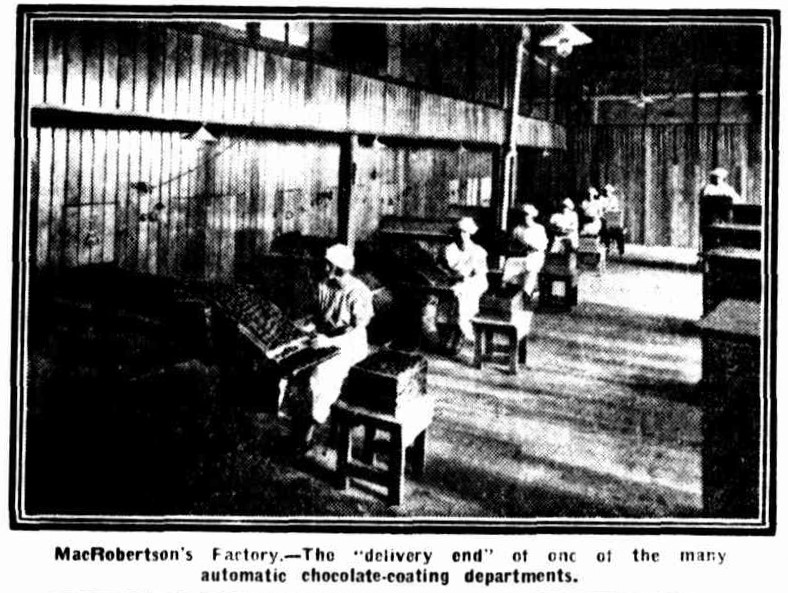
In MacRobertson's Factory.-The "delivery end" of one of the many automatic chocolate-coating departments.
1912 343 tons of cocoa beans were used. In 1920 the figures had increased to 701 tons for the year; and in 1925 the consumption was 1,100 tons. The use of sugar has also increased enormously. It will be remembered that the founder, Mr. MacRobertson, was obliged to borrow the money to buy his first bag, which weighed 140lb. net. In 1925 he converted 1,500 tons of cane sugar into confectionery.
The figures for glucose have shown a corresponding increase. In 1912 the consumption was 1,084 tons for the year; in 1914 1,242 tons was needed; and in 1925, 1,600 tons was required for the factory. Naturally the sterling turnover of the business has increased proportionately, and the 1915 figures show 100 per cent increase of trade over the 1914 figures, whereas the 1925 figures show an increase of 270 per cent. over the 1915 figures. To-day the yearly turnover is calculated in millions of pounds sterling.
.jpg?timestamp=1576238658225)
The nucleus of a great Australian business: MacRobertson's factory in 1885.
A. W. ALLEN LIMITED.
Although the company which now manufactures confectionery under the title of A. W. Allen Ltd. was formed only in 1917, the name of "A. W. Allen" has been associated with the sweet-making industry in Victoria for nearly 40 years. In 1891 Mr. A. W. Allen leased a shop in Brunswick street, Fitzroy, and although his capital was very limited, he erected at the rear a galvanised iron shed. In it he began to manufacture sweets. Mr. Allen's business grew rapidly and several times he transferred his factory to larger premises. At the outbreak of the war it became difficult for Australian manufacturing confectioners to obtain from overseas certain materials.
The proprietors of six confectionery factories, of which Mr. Allen's had been the longest established recognised the advantages of amalgamation, and, after much negotiation, one large company was formed, under the name of A. W. Allen Pty. Ltd. The other firms which were parties to the arrangements were Messrs. Craig and Suter, of Fitzroy; Clark, Luke Pty. Ltd., of Richmond; the National Candy Co. of Richmond, Tuckett, Obbinson, and Co. Pty. Ltd. of North Melbourne, and the Amazon Confectionery Co., of Melbourne. Mr. A. W. Allen became chairman and managing director, and the other firms were represented on the directorate. For some time manufacturing was done in six separate factories, pending the erection of a large modern factory building in Riverside avenue, South Melbourne. The whole of the operations of the company were transferred to the building early in 1924. In 1922 the business became a public company, the name being altered to A. W. Allen Ltd. VICTORIAN INDUSTRIES. (1926, September 9). The Argus (Melbourne, Vic. : 1848 - 1957), p. 26 (AN HISTORIC SOUVENIR). Retrieved from http://nla.gov.au/nla.news-article3807811
MacRobertson 's New Bulk Store Has Carrying Capacity of 3000 Tons a Floor
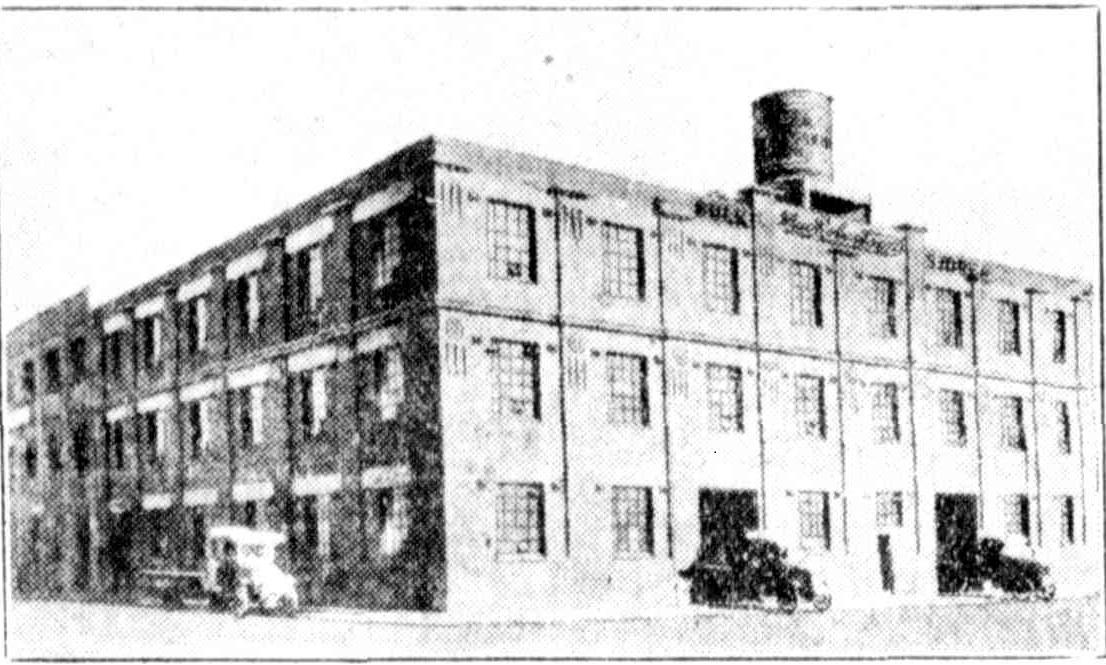
To the great array of MacRobertson factories and stores at Fitzroy has been added the bulk store shown In the illustration. It Is Intended for the storage of raw materials and will act as a reservoir of supplies for the whole of MacRobertson's confectionery factories. This building, of structural steel and concrete with brick facing, has an enormous carrying capacity. Owing to what' the engineer calls "the eccentric live loading requirements," wooden floors have been Installed, but each floor has been -designed, to carry a load of 3000 tons. The concrete foundations to support the great aggregate weight ' were reinforced with 30 tons of steel, and 252 tons of structural steel was used in the building itself. Provision has been made for goods inward and outward, with special docks to facilitate handling. Two modern goods lifts, electrically driven, with two tons capacity each, have been installed for the handling of goods above the ground floor. Automatic Are sprinklers are reticulated throughout the building. Bold design and prominent outline dominate the landscape. Mr MacRobertson hi the possessor of one of the largest (carrying capacity) stores in the southern hemisphere. The drawings and specifications were prepared by G. W. Draper, the firm's architect, under whoso supervision the work was carried out. MacRobertson's New Bulk Store Has Carrying Capacity of 3000 Tons a Floor (1928, May 16). The Herald (Melbourne, Vic. : 1861 - 1954), p. 13. Retrieved from http://nla.gov.au/nla.news-article243988780
JUBILEE OF MAC ROBERTSON FACTORY.
Fifty years ago yesterday Mr Mac Robertson began the manufacture of confectionery on the site in Fitzroy on which the great Mac Robertson confectionery factory now stands. To mark the jubilee of the foundation of the business his employees, numbering 2,600, gave him a great welcome at the works yesterday morning. He is shown addressing his employees. JUBILEE OF MAC ROBERTSON FACTORY. (1930, June 11). The Argus (Melbourne, Vic. : 1848 - 1957), p. 5. Retrieved from http://nla.gov.au/nla.news-article4092736
The Week on the Mainland.
Melbourne. (By "Melburnian.") -MELBOURNE, Tuesday. Mr. Mac. Robertson's Jubilee: Great enthusiasm was displayed by the 3000 employees of the Mac. Robertson confectionery factories, Fitzroy, at a surprise welcome to Mr. Macpherson Robertson on the occasion of the 50th anniversary of the foundation of his huge works.
On his arrival at 11 a.m. he was driven between cheering lines of employees holding gay flags and streamers, and his car was followed by the brass band of the factory, playing "Hail the Jubilee'' and ''Australian Kangaroos, ' the latter tune being, a composition of Mr. Mac. Robertson. On entering the factory he was escorted to the exact site where, on 10th June, 1880, he had begun making sugar animals with a nail can and a pannican and from behind the original nail can he addressed his employees. He had started, he said, with a capital of less than twenty shillings, but his capital was slightly more now. He had been assisted by many able workers, and the concern was now the largest of its kind in the Commonwealth. When abroad in 1920 he had seen nothing to equal it. His greatest help had been from his mother, who had encouraged and inspired him. After placing under a stone a small bottle, in which was sealed a brief record of the business, Mr. Mac. Robertson was escorted to the showrooms, where a replica of the original bathroom in which operations were commenced had been placed close to a model of the 23 Fitzroy factories now in full operation. Later he addressed a huge crowd of employees from a lorry in Gore street, and was enthusiastically received. The Week on the Mainland. (1930, June 18). Advocate (Burnie, Tas. : 1890 - 1954), p. 9 (DAILY). Retrieved from http://nla.gov.au/nla.news-article84943037
MAKING GOOD
The MacPherson Robertson DETERMINATION DOES IT.
Who is Sir Macpherson Robertson, better known as MacRobertson, who rose from impecunious obscurity to the dazzling spotlight of millionaire-dom, and now, like some new Carnegie, distributes enormous sums of money for the benefit of his country and of humanity; and, a few days ago, set the world's greatest aviators competing against each other in an astounding dash across the world! That question, in one form or another, has been asked by tens of thousands not only in Australia but in lands across the seas. Most people in Australia know something of his magnificent contributions to charity, and everybody knows that it was he who, out of his munificence, made the centenary air race possible. But what manner of man is he?
The question is fully answered in an excellently illustrated biography by George Taylor, which has been published by Robertson and Mullens Ltd., of Melbourne, under the title of "Making it Happen."
"Making it Happen" is a highly appropriate title for the life of such a man as Macpherson Robertson. Unquestionably fortune smiled upon him, but he made his wealth by sheer courage, indomitable will power, and a Niagara of human energy.
His father, David Robertson, was born in 1833 of Scottish parents in Monte Video, South America, and was attracted to Ballarat in the golden fifties. There, in 1859, he married an Irish girl from Inniskillin, Margaret Browne. David was an incurable optimist; he had seen the "Welcome Nugget", that hundredweight and a half of pure gold carted through the streets of Ballarat, and he believed that he, too, would be lucky. But like many other optimistic diggers he was doomed to disappointment, and when Macpherson Robertson was born the family was having a desperate struggle for existence. In the sixties he took a job as a carpenter for the first hospital at Rockhampton, Queensland; then he drifted to Fiji as a carpenter, and finally sent his family hack to Scotland — hoping to follow later.
There young Robertson felt poverty in the extreme, for he became the family breadwinner, trudging at 3 o'clock in the morning into Edinburgh, a distance of more than three miles, to sell newspapers, and doing odd jobs until 10 o'clock at night in a barber's shop. His morning meal was an inadequate supply of sour milk and weak porridge; his lunch was dry bread; and in the evening he returned to all that his mother could afford— a bowl of porridge and sour milk. That meal never varied.
At 10 years of age young Robertson made his first bid for greater freedom; in the next two years he tried ten different jobs, from cowboy —he says he often envied the well-fed cows — to a humble job in a manufacturing confectionary house at Leith. That was the job that Fortune had planned for him, for the world has produced only one MacRobertson in confectionary. At that job he was a genius. His grandmother died and left £70. Young Robertson, now head of the house, used that money to bring his mother and four brothers and sisters back to Australia. They reached Melbourne in 1874. Next day he secured a job in a sausage-making shop at 2/6 a week; and that day, too, he found his father, whom the family had not seen for five years. Young Robertson longed to get back into confectionery, and he secured the consent of his mother to become indentured to the Victorian Confectionery Company.
When his apprenticeship was ended he had to look around for a job, and he obtained work with Black and Spence, in North Melbourne, at 35/ a week. He worked there for 18 months, and then, on June 10, 1880, he took the decision of his life. He talked the matter over with his mother, secured her approval, and decided to become a manufacturing confectioner. That day, June 10, 1880, must be the red letter day in the calendar of Sir Macpherson Robertson. With a capital of half a crown, a nail can that is cherished in the MacRobertson works as a curio that money could not buy, a tin pannikin, and a bag of white sugar, he started his career. Next day he hawked his wares over Melbourne, and earned 2// That was his beginning. He made his sweets for four days a week and hawked them for two days. At best he had a turnover of £6 a week; today his turnover is £2,000,000 a year. To imagine that MacRobertson's ambition was to make a fortune and hoard it is to completely misjudge the man. It is true that his work is his very life. He was offered a sum of £2,500,000 for his business. He refused it. The industry was more to him than its monetary value. As he himself put it, "Had I sold I would not have had a job.''
But so soon as he had made money he looked around to see what he could do to help his country. His benefactions have been enormous. Some years ago money was needed to equip the Sir Douglas Mawson expedition to the Antarctic. Mr. Bruce, then Prime Minister, and Sir Douglas, approached MacRobertson. He contributed the whole amount, £16,500.
The depression hit him very heavily, but he faced it resolutely. The value of his sales dropped, but his pay roll remained very much the same as it had been. When departmental managers suggested a reduction of staff MacRobertson shook his head and said, "No." He merely relinquished the immediate idea of profits and decided to stand the losses, and wait for better times. All Melbourne knew that: None knew it better than the leaders of unions and politicians, and when, in June, 1932, His Majesty the King created him a Knight Bachelor, the honor was acclaimed by all ranks and shades of political opinion. All agreed that the honor had been merited:
The centenary of Melbourne was approaching. Could the State afford the expense ? One June 10, 1933— on the same memorable date as he began his confectionery business, but 53 years later — on that day, without any flourish of trumpets, he offered the Government of Victoria a gift of £100,000 towards the expenses of the centenary — a £1000 for every year of Victoria's hundred years. Then came the Centenary Air Race with a first prize of £10,000 and a magnificent gold cup for the winner of the speed race, with a second prize of £1500 and a third of £500. The benefactor wanted a handicap race for commercial purposes, so he provided for that a prize of £21000 for the winner, and £1000 for the second. In addition, he is 'giving a number of valuable medals, one to each contestant; and he made a donation of £2500 to Sir Charles Kingsford Smith for the plane in which he is now crossing he Pacific.
But — space is limited, and it would need a volume to write fully of Sir Macpherson Robertson. Mr. George Taylor has done that in his excellently illustrated book. And among the beautiful illustrations one feels glad to see a picture of the bathroom in which MacRobertson made his first 72lb. of sweets that he hawked round Melbourne, the original nail can in which he boiled his sugar, and the tin pannikin that he used as a scoop. Yes, one can imagine that money would not buy those treasures! MAKING GOOD (1934, November 2). The Kyogle Examiner (NSW : 1912; 1914 - 1915; 1917 - 1954), p. 7. Retrieved from http://nla.gov.au/nla.news-article235324912
That Freddo Frog
In 1931, Harry Melbourne, 18 years of age and now known as the Freddo Frog Ideas Man, overheard someone suggest to the boss that his proposed new product should take the form of a mouse. Macpherson Robertson had actually been selling sugar mice way back when he first began, they were once a popular product. Mr. Melbourne chipped in: "That's rubbish. Women and children are afraid of mice; that won't sell. I reckon a frog ... kids love catching tadpoles and frogs."
Macpherson Robertson gave him three days to come up with the moulds and have the product on his desk for sampling. Mr. Melbourne fashioned the moulds from German silver and had the first Freddo Frogs on the boss' desk, in four flavours, in the allocated time. Not long afterwards, he was told: "You've backed a winner" and promoted to foreman.
Adding a touch of marketing savvy to his creative flair, he told the owner of the company, Sir Macpherson Robertson: "Call it Freddo, after Fred." - one of his mates at the factory, rather than press for it to be named 'Harry' as suggested by some co-workers.
Harry Melbourne, born in Gainsborough in England in 1913, and coming to Australia as a 16 year old, was an ardent supporter of the Caulfield Football Club in the Victorian Football Association, and Caulfield South Cricket Club, where his son, also named Harry, played football and cricket. He was secretary of the football club for about 20 years and guided it through tough times to a premiership in 1973.
He retired as a chocolate maker after 38 years, at age 57, rather than take a senior job at Cadbury after the takeover. He took a job as the keeper of Caulfield Town Hall, enabling him to devote more time to saving his beloved football club by raising funds for a new pavilion.
Mr. Melbourne didn't receive a cent from his employer for his money-making suggestion, but it never bothered him. "Freddo was made for the love of the company," he told his family. A grateful Cadbury, however, kept him in chocolates and from time to time sought his advice.
Harry passed away in 2007 aged 94.
Some More Cherry Ripe 'Notes':
Cherry Ripe!
Delicious Fruit From The Highlands
Within a few days nearly every barrowman in Sydney will be selling cherries. This delicious crop comes in with a rush and provides a Wonderful feast while it lasts, but within six Weeks it is all over. The varieties grown in New South Wales are unsurpassed in any country in the World. Appreciation of this fact makes the fruit even more appetising.
THE earliest records of deciduous fruit trees brought to Australia by our first settlers stamp them as equally desirable in fortitude, stamina, and courage as the settlers themselves, those men who pioneered the continent and sired the race we now know as Anzac. An entry from the records of the Botanic Gardens, Sydney, dated 1827, reads: 'There has been no rain for eight months. European trees stood the drought better than those from warmer climates. Oranges appeared to be burnt up, but the others showed no apparent injury.' They, too, came from the Motherland. Amongst the trees referred to were several varieties of cherries, and even at that early date their performances were carefully recorded. That several of these gave promise in so unsuitable a site is merely an indication of what is actually happening to-day, for the first cherries to arrive on our markets in comparatively recent years have been grown within a few miles of Sydney. These come from the orchard of Mr. Fred Chilton, at Turramurra, on the North Shore line, and although he may beat the wider commercial districts by only a few. days, these days are very profitable, and to such an enthusiast very satisfactory ones. The next to arrive are from Oakdale, in the Camden district, and the lower slopes of the Southern Tablelands; and these are followed by the great centres of Armidale, Young, and finally Orange. Mr. Chilton knows quite a lot about cherries, and expresses the opinion that they followed the gold diggers in the days when gold was gold and men went far to dig for it. This would appear to be perfectly true, for all the established cherry-growing districts of New South Wales are located on or in the vicinity of our once great goldfields.
AT Uralla a veteran of seventy cold winters still occupies its place in the row of trees among others sixty years it junior. This pioneer is the father of all cherries in New England, and was with others brought up from Maitland, then the rail-head, by bullock team through and across the ranges, so that the miners and settlers might eat more fruit. As a matter of fact, few Australian pioneers journeyed into the then unknown without a supply of seeds or nursery stock to plant on their locations. Batlow — still amongst the gold — claims the biggest cherry tree in Australia. This aged giant stands 40ft high and bears enormous crops of fruit. That the yield is of very mediocre quality matters not, for the veteran occupies a proud position as corner-post in a fence. It is still thriving and putting many younger trees to shame, not only in yield, but because of its utility in other directions. It has been morticed for the panels of the fence, and besides serving as a harness rack provides convenient limbs on which the plough may be hung at eventide. The districts of Bathurst, Young, and Orange further prove the gold theory; but it must also be admitted that other deciduous fruits are now extensively grown in all the areas referred to. There are remaining, however, no trees other than cherries that survive those days of our early history.
NEW SOUTH WALES, grows more than one-half of the cherries produced in the Commonwealth. Nearly 350,000 trees are now planted out, by far the greatest numbers being at Orange, Young, and Uralla. Each of these districts is well above sea-level, the height ranging from 3500ft (Uralla and Orange) to Young (1500ft). This fruit requires fertile soil, good, reliable rainfall, and moderate temperatures. Of late years other areas have come under notice, principally with a view to catching early markets, but the quantities produced from these are negligible. So defined are the requirements of the cherry tree in respect of soil that in all three of the older districts the available area is limited. At Orange, for instance, the district is about 30 miles long and 1 0 miles wide. It begins a short distance from Millthorpe and extends to Borenore, on the Molong line, and Mullion Creek, on the Wellington line. At Young the strip of suitable land is much smaller, comprising a ridge about fourteen miles long and eight miles wide. There are, without doubt, many other areas where the fruit could be profitably grown, but lack of transport facilities has prevented plantings in localities that otherwise possess the necessary requirements.
CHERRIES are the last trees to bloom and the first to provide fruit for the market. Within a few days of ripening they are pale, insignificant berries. Almost overnight the trees become aflame with the tints of maturity, and all hands toil unceasingly to pick the fruit before it all too quickly passes the correct harvesting period. Hundreds of casuals (many of them regular because they annually repair to the cherry orchards) are engaged, Sundowners, Sydney-siders, boys, men, and women, and children find that the cherry orchard is a place where energy counts and where nature has to be raced all day long. In six short weeks anything up to half a million 121b boxes of cherries has to be picked, packed, marketed, and eaten. Where other fruits may for some reasons, artificial or otherwise, extend their season, time governs the cherry most relentlessly. The crop sets simultaneously according to variety and locality and almost as simultaneously ripens. A cherry orchard during the harvesting period is a scene of simmering excitement. All operations must be scheduled, this being possible because the expert grower ha? balanced his varieties to give him scope for systematic work. His boxes are made ready, packing benches are cleared for action, and as an unending stream of laden buckets reaches these they are expertly picked over and packed — firmly, yet delicately — so that when opened up they will worthily uphold their district's good name. The vagaries of weather play a most important part, for an inopportune shower will ruin the best crop extant.
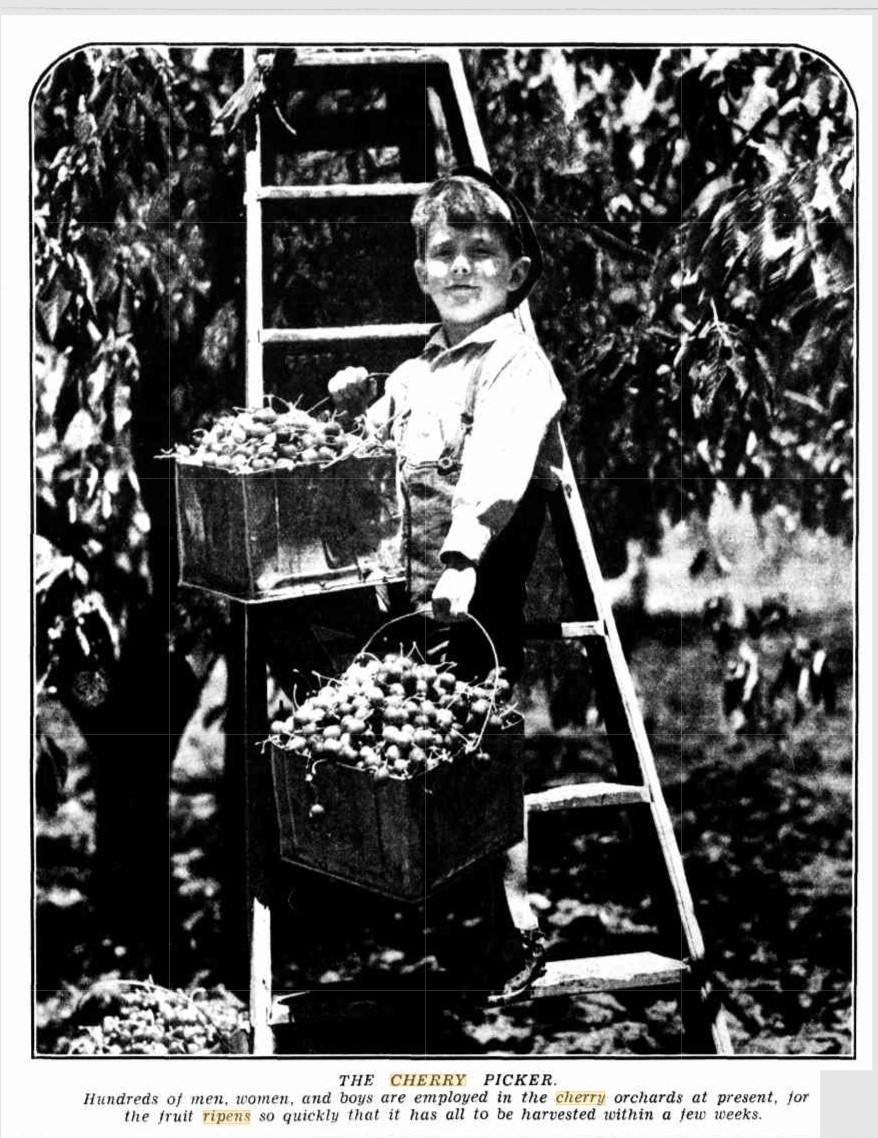
THE CHERRY PICKER. Hundreds of men, women, and boys are employed in the cherry orchards at present, for the fruit ripens so quickly that it has all to be harvested within a few weeks.
.jpg?timestamp=1576267668188)
Scores of students and others from Sydney make for the cherry orchards at this season of the year, and for those who are prepared to work there is good money in picking.
Where the New England Cherries Grow
It is not until the last boxes have been brought under cover that the grower can take a brief respite from his year of unremitting toil, and it is no unusual experience then for weather conditions in Sydney to be against free sales and to retard consumption. Cherries are grown to be eaten at once, and eaten to the fullest possible extent. For ten weary months the lover of this delicious fruit has waited to appease a most natural appetite, and the consumer knows that within just a few weeks there will not be a cherry left. Why not, then, eat and eat again of such delicious fruit?
THE cherry-growers, although not co-operatively organised for marketing, are what might be termed 'district conscious.' Agents specialise in certain brands, and the buyers usually think in terms of Armidale, Young, or Orange. Perhaps the latter, by reason of larger figures of production and by a more definite concentration upon regard for public requirements, is best known on our markets; but so far as the consumer is concerned a good cherry is a good one, irrespective of origin. The Young district specialises more on the earlier varieties, and is literally forced to race the fruit to market. This season its qualities have been superb — a natural recompense for last year, when lack of rain caused the fruit to ripen when too small. Annidale and Uralla may be bracketed together with several other splendid districts adjoining. A very large proportion of their fruit goes to Queensland, where it usually beats Sydney prices. The growers of New England have their own publicity department, and use a common label in order to assist this endeavour. Their energy has recently been galvanised by a leading grower who has toured the world, and, incidentally, absorbed American publicity methods. Mr. R. A. Jackes, the grower referred to, is a descendant of one of the pioneers of this great district. The original orchard, Orchardfield, together with those occupied by other descendants of the family, are still flourishing. This district produces cherries of wonderful quality, but Sydney receives very few of them. Uralla in perhaps the largest centre, but right through from there to Inverell, and surrounding Armidale itself, are many fine properties.
BARELY one month ago Sydney held its Health Week, and, appropriately enough, the importance of fruit was stressed by the leading medical authorities. All doctors agree that fresh fruit should be eaten every day, and now that cherries are in there is no doubt that all who can get them will do so. Prices, for the consumer, are in accordance with prevailing conditions. Enormous quantities must be sold every day from now on until the last of the fruit has been harvested.
New England ELEVATION and climatic conditions make New England an ideal region for the growing of cherries, apricots, peaches, plums, apples, pears, quinces, and nectarines, especially the Armidale, Arding, Uralla, and Kentucky districts, a small area within a radius of forty miles that is splendidly situated and highly fertile. Cherries — Nature's ideal dessert — flourish particularly well on the tablelands, and a ready sale is found for them, mainly through the Brisbane market, but also in the northern towns of New South Wales. The prominent growers have banded together under the name of 'Sunny New England 'Blue Label' Community Packers,' and their aims are as high as their products are good. Although in some senses a co-operative organisation, this is really an individualistic movement. Each orchardist is supplied from a central depot with the number of labels required, and the fruit is packed and despatched from each orchard independently, it being left to the grower's honesty to pack only the choicest fruit in boxes bearing the community - packers' 'blue label.' This system, which is working very smoothly, does away with the necessity for having all fruit grown in the area passed through a grading and packing depot. In this growers are more or less emulating the system used extensively in California.
SEVERAL orchards in this area have been in existence over 60 years, and many of the original trees continue to yield wonderful crops of fast-grade fruit. One cherry tree of the Florence variety, now 55 years old, stands 30ft high, with a spread of 30ft. In the year 1928 70 boxes were taken from it, last year 40 boxes, while this year's crop is estimated at about 45 boxes. An officer of the Department of Agriculture who visited New England some years ago stated that the cherries were on a par with the choicest varieties grown in any part of the world.
The picture at the top-left of this page epitomises the settlement of the great New England district. It shows three generations of fruitgrowers with three generations of fruit trees, in every way as sturdy and true of heart as the pioneers themselves. The tree under which Mr. Yeomans, his son, and grandson stand was planted in the days of the gold-diggers. While these have long since disappeared, the old tree remains, with the Yeomans family, as a testimony of steadfast endurance and the will to carry on.
.jpg?timestamp=1576267532236)
THE YEOMANS OF ARDING. Three generations of one of the pioneer orcharding families of the New England district, photographed under a veteran cherry tree of the Florence type which was planted nearly 60 years ago, and is still bearing heavily.
.jpg?timestamp=1576267476790)
A NEW ENGLAND MAID.
Cherry Ripe! (1930, November 26). Sydney Mail (NSW : 1912 - 1938), p. 29. Retrieved from http://nla.gov.au/nla.news-article159660466
Cherry ripe
A CHERRY tree, planted at Severnlee, in the granite belt of southern Queensland, some 30 years ago, is still bearing. This season the tree, which is growing on the property of Mr. F. Donges, produced 25 trays of cherries, which sold for £63 in the Brisbane markets. The tree is 24ft high, and, although the pickers used a ladder 12ft high, most of the fruit was gathered by pickers climbing up into the upper branches. Mr. Donges estimated that it would have taken one man at least a week to harvest the whole crop.—J.K.H. (Q). Australiana (1955, April 9). The World's News (Sydney, NSW : 1901 - 1955), p. 27. Retrieved from http://nla.gov.au/nla.news-article133915298
"CHERRY RIPE."
For Summer Sweets.
Every housewife feels most grateful to cherries for coming in just when the hot weather has descended upon us, and indicated that light and attractive desserts must be served if dinner is to be a successful meal.
A variety of delicious sweets may be made, all with cherries as their basis, and the following recipes are well worth noting now that the cherry season is here.
CHERRY SPONGE: Soak 4 level dessertspoons of powdered gelatine in a pint of cold water. Wash and stone, using 3 pint of water, 1 pound of cherries, and let them boil till very soft. Press through a colander. Let boil again, add 9 level tablespoons of sugar. Meanwhile, beat the white of an egg to a stiff froth. Add the gelatine to the boiling mixture, and when it is quite dissolved pour all over the egg-white. Beat all through -let stand till near setting, then beat till it is all light and spongy. Pour into a wet mould to set and serve with boiled custard.
CHERRY CUSTARD: Stone 1 pound of cherries in as small a quantity of water as possible. Put in a pie-dish with sugar to sweeten, and sufficient bread, biscuit, or cake crumbs to just about absorb the liquid. Make a custard with milk, eggs, sugar, and lemon essence. Pour over the cherries, sprinkle with nutmeg, dot with butter, and bake, standing in a dish of water, until the custard is firm.
CHERRY CREAM: Stew 1 pound of cherries in half a pint of water, to which 4oz of sugar has been added. When soft, rub the fruit and liquid through a sieve. Mix 1oz of gelatine in half a gill of water. Strain it into the fruit puree and add the juice of half a lemon. Whip half a pint of cream, and stir it into the fruit mixture. Colour with a little cochineal, and put into a mould rinsed with cold water. Leave to set in a cool place. Turn out, and garnish with crystallised cherries cut in half.
CHERRY TART: After slowly stewing 1 pound of cherries with Jib of sugar in h pint of water and a dessertspoonful of lemon juice, strain the fruit out of the syrup, which should be thickened with arrowroot previously mixed with a little of the syrup. Bring the thickened syrup to the boil and drop the fruit in. Line a sandwich tin with short crust, bake to golden brown, pour cherries and syrup in. This is delicious as a hot or cold dessert. (The cherries may be stoned or not, as preferred.)
CHERRY TART: Stew 1 pound of cherries with 1 cup of sugar, but without water. Line a tin with good pastry, lay the cherries evenly in this, adding a little of the syrup. Put strips of pastry across the top to form an open lattice, brush over the pastry with the beaten white of an egg, and bake in a good oven until it is nicely browned. Use the yolk of the egg for some boiled custard to serve with the tart. "CHERRY RIPE." (1935, November 28). The Sydney Morning Herald (NSW : 1842 - 1954), p. 18 (Women's Supplement). Retrieved from http://nla.gov.au/nla.news-article17212329